Zagreb Tourist Board Marking World Tourism Day in Vukovar
September the 27th, 2022 - For the first time, the Zagreb Tourist Board will mark World Tourism Day outside of the capital city, looking to Eastern Croatia and choosing Vukovar.
As Poslovni Dnevnik writes, the Tourist Board of the City of Zagreb (TZGZ) traditionally celebrates World Tourism Day every single year, and this year will be the first time it will do so outside of the City of Zagreb, presenting the long-standing educational high school project "Culture of Tourism" in Vukovar. As such, in cooperation with the Croatian Association of Tourist Journalists and Writers in Tourism - FIJET Croatia, the projects of the students of Zagreb will be presented within the a programme called "Culture and tourism in the revival of the continental tourist offer".
The Director of the Zagreb Tourist Board, Martina Bienenfeld, said on this occasion: "World Tourism Day is celebrated on September the 27th under the auspices of the UNWTO (World Tourism Organisation), so I'd hereby like to send my sincere congratulations to the entire tourism industry of Zagreb and Croatia. In accordance with this year's slogan, Rethinking tourism, we focused on our "Culture of tourism" project, which we're implementing in cooperation with the City Office for Education, Sport and Youth.
With this project, we're involving young people in participating in environmental protection programmes, raising their quality of life, preserving ethnological, historical and cultural heritage, raising the level of hospitality and creating a welcoming climate, and with their great work, they're showing how well tourism can truly be thought through. With an emphasis placed on year-round tourism, Zagreb has a developed, sustainable, equal and responsible tourist offer and has achieved great tourist results in the previous part of the year. Cooperation with Zagreb's high school students provides the foundations for shaping the future of tourism in a way that makes it sustainable, stronger, more inclusive and empowering both for our city and for the country as a whole."
Through the systematic education of Zagreb high school students for whom tourism and catering are not primary, the Zagreb Tourist Board hopes the "Culture of Tourism" project will succeed in its aim to raise the students' awareness of their own city and introduce young people to its touristic, cultural and natural potential. Over the years, all schools in the City of Zagreb have participated in the project, and this year there were six of them. They will present their projects in Vukovar this year.
For more, make sure to check out our dedicated travel section.
Season 2022, Mission Year-Round Tourism: Vukovar Well on the Way
September 8, 2022 – While the Adriatic coast is still almost exclusively a summer destination, other parts of Croatia strive to fill the gap. Among them, Vukovar is indeed full of life, 365 days a year. The local tourist board shared some of their insight for season 2022 so far. Year-round tourism in Vukovar is the mission, and it seems that it’s been going well.
CNTB has been working to stregthen continental tourism, and Vukovar is a step ahead. As they put it in the local tourist board, this city is not a seasonal destination anyway, though its highlights are a higher number of tourist arrivals in spring and autumn. Statistically speaking, the number of overnight stays is an indicator of the success of a season, but in Vukovar, even one-day visitors should make the count, it's just that it is difficult to count them accurately.
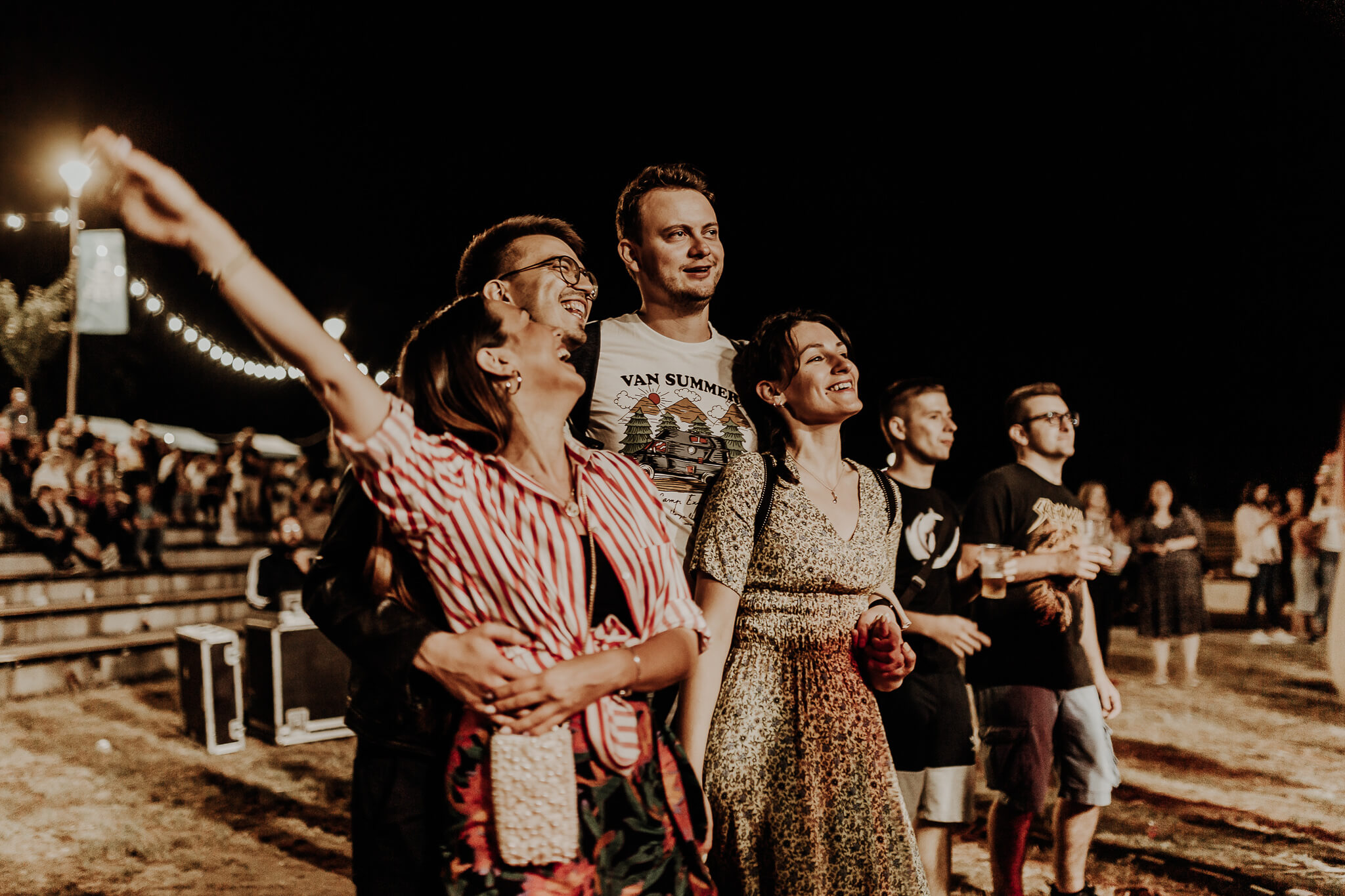
Significant sports events as well as manifestations and festivals generate an increased number of arrivals and overnight stays (Vukovar Film Festival, Svi zaJedno Hrvatsko NAJ).
In the period from 1st January until 31st August, 19.605 arrivals and 33.005 overnight stays were recorded in Vukovar. Out of the total number of overnight stays, 24.641 were domestic guests and 8.364 foreigners. The number of overnight stays compared to the same period last year is 113.93% higher in total. The number of overnight stays of foreign tourists increased by 63.26%, and of domestic tourists by 139.12%. Such a large overnight index of domestic tourists is the result of the return of students' visits for a two-day tour of Vukovar, while in 2021 they would only come for one-day visits, without overnight stays.
As for arrivals, the total amounts to 19.605, of which 2.744 were foreign guests, and 16.861 were domestic. Last year, there were 13.756 fewer arrivals, because in 2021 there were no student excursions that included overnight stays, so they are not recorded here. Looking at arrivals and overnight stays in 2022 without students, the total number of arrivals was 9.188, of which 2.725 were foreign guests and 6.463 domestic. This means that this year 10.398 students visited Vukovar. Comparing the indexes of arrivals and overnight stays, it is apparent that in the total amount, arrivals exceeded last years' by 57.9%, and overnight stays by 36.60%. The number of foreign tourist arrivals increased by 97.89% and domestic by 44.52%. In terms of overnight stays, the increase of foreign guests has been 61.59 %, and domestic guests 24.18 %.

The people of Vukovar have always lived on and by their river, and they still spend a lot of time on its waves and banks. It is increasingly attractive to guests from other parts of Croatia, and numerous guests from all over the world on river cruises sail down the Danube.
In 2021, 125 river cruise ships docked in Vukovar with 11.349 passengers. For 2022, 339 cruisers were announced, at the level of 2019, when 351 cruisers docked.
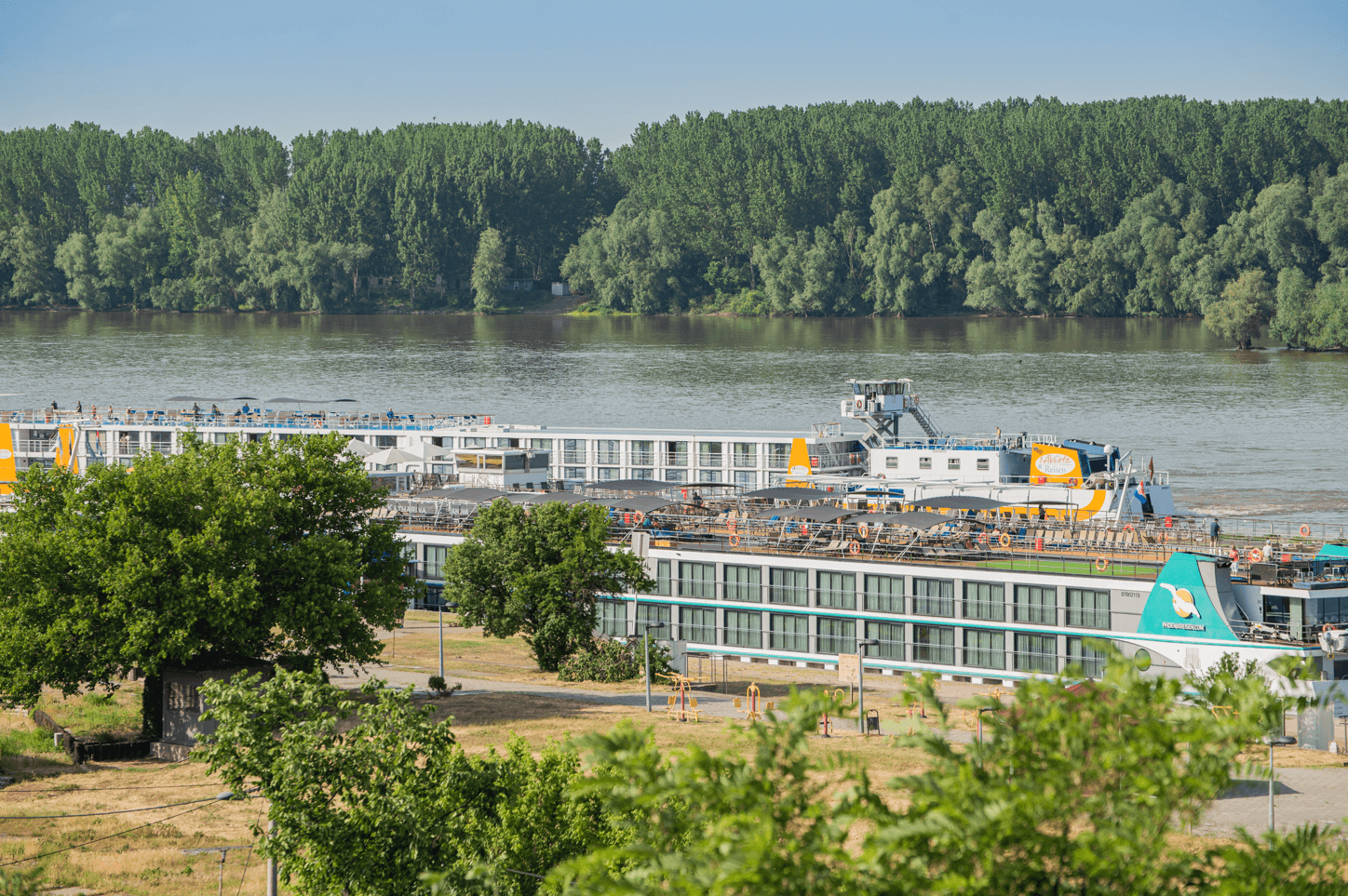
The Film Festival of the Danube countries - the Vukovar Film Festival, which is in many respects unique - has returned to the banks of the Danube in its full glory. It is the only film festival that literally takes place on the Danube and thus offers a unique experience. It was designed to promote and expand the creative rise of filmmakers from the Danube countries. The 16th edition of the Festival was held from June 29 to July 3, and it brought over 50 of the latest acclaimed and award-winning films from prestigious international film festivals.
Vukovar was an important destination for film festivals this summer. Another film festival premiered on July 29 and 30 - Klein Film Festival. Klein is a film and music festival, which is conceived as an international festival of short feature, documentary, and animated films up to 20 minutes long. The festival is a tribute to Hugo Klein, a theater professor, theoretician, and psychiatrist born in Vukovar.
Summer in Vukovar is unthinkable without swimming in the Danube on Vukovar Ada, a sandy island opposite the city that is ranked among the ten most beautiful and interesting beaches in Croatia on rivers and lakes. This year too, free transportation was provided for all those looking for refreshment and an escape from the heat and scorching city asphalt. The Vukovar Ada is a great place for camping and beach volleyball, and good fun in a pleasant company is guaranteed.
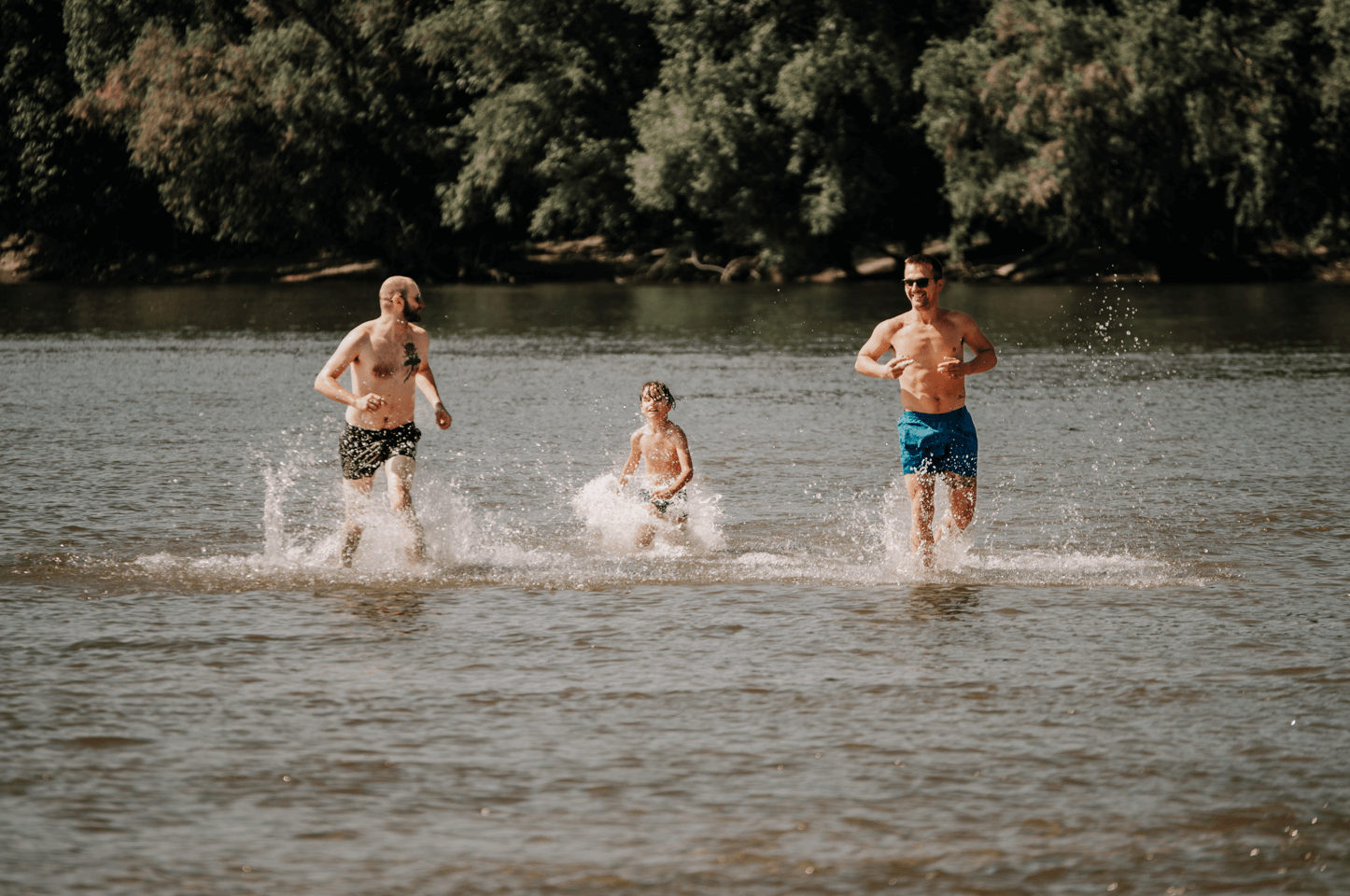
An interesting program called Danube Garden Summer Nights has been designed for this year, with good music, delicious food, and refreshing drinks under the Danube stars. A total of four concerts during July and August were held on the summer stage by the Danube, which in its magical ambiance was a hit place this year for pleasant socialising, fun, and enjoying the beauty of Vukovar nights. There was also a cinema under the stars, a motorcycle party, and numerous other cultural and similar events. It is no small thing to live in a city through which the second largest European river flows! It should be emphasised, celebrated, and simply lived with the Danube, as the people of Vukovar show by example.
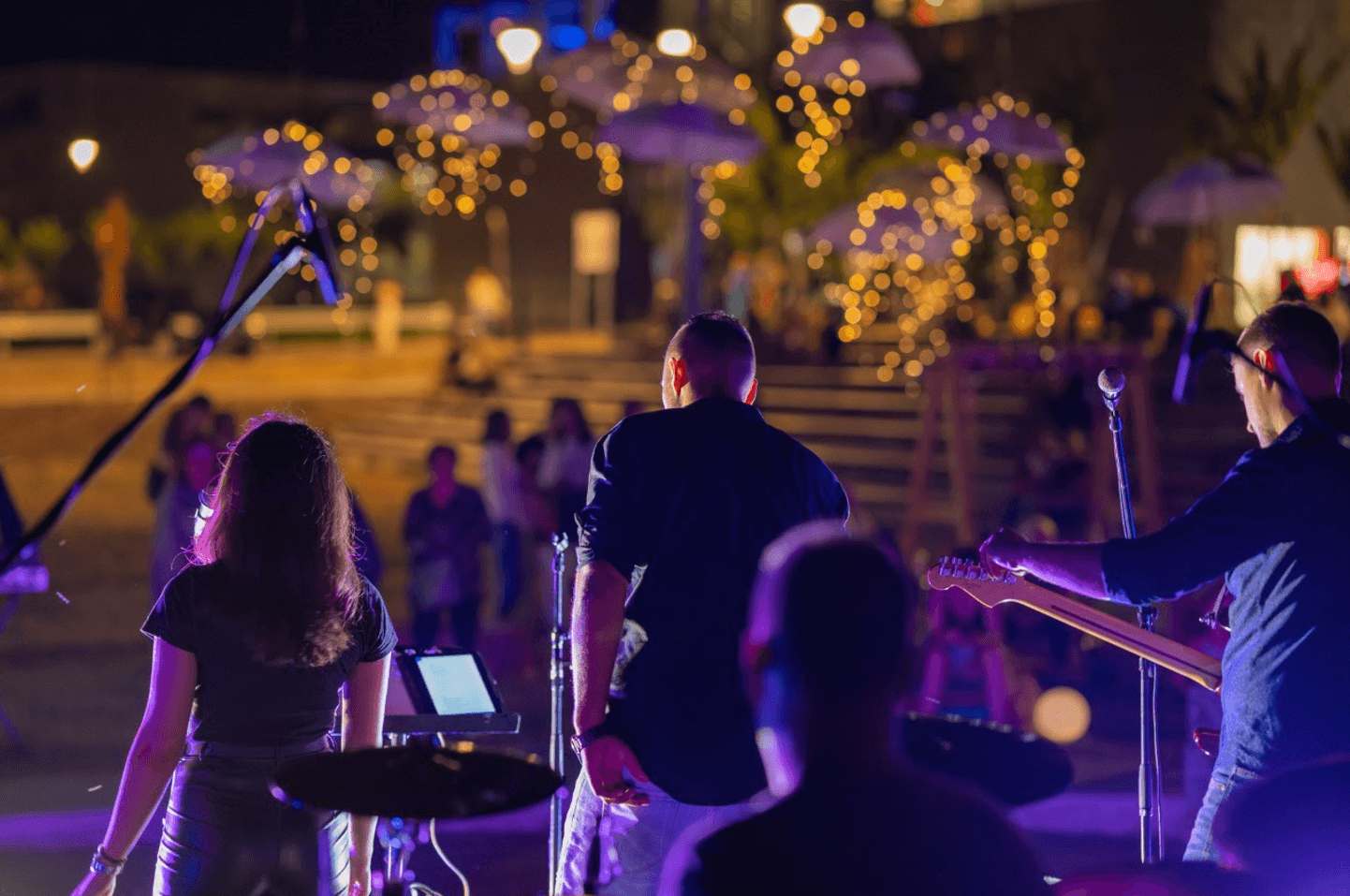
As autumn approaches, preparations begin for the 15th Vukovar ethno fair, which will be held from September 23 to 25 at Republic Square. Craftsmen from all over Croatia will join the fair again this year at the 6th Flavours of Croatia fair, organised by the Vukovar Artisans Association, where they will prepare and present their autochthonous dishes. Brewers and representatives of the German and Austrian minority communities as part of the 5th Vukovar OktoBierFest will also showcase their products. There is no better place to promote beer and brewers than Vukovar and its fair - after all, the first beer was produced in Vučedol.

During the fair, the Association of Tourist Guides of the City of Vukovar is organising a free guided tour of the city for the local population and visitors for the fifth year in a row, on the occasion of World Tourism Day, which is September 27. This year, costumed guides will take us back to the old times in the city.
All photos by Vukovar Tourist Board.
For more, make sure to check out our dedicated Travel section.
Lika-Senj Prefect Ernest Petry Reveals Plans in Works for Region
June the 1st, 2022 - Lika-Senj Prefect Ernest Petry has revealed the plans which are currently in the works for this beautiful region of the country.
As Novi list/Marin Smolcic writes, one entire year has passed since Lika-Senj Prefect Ernest Petry (HDZ) took over the helm. It is well known that this period has been very rich in meetings, field trips, decisions and efforts to make up for this part of Croatia which many deem to have been lost and forgotten about many years ago. Add in the global COVID-19 pandemic, and recently market changes caused by Russian aggression against Ukraine, the situation continues to be problematic for all. Lika-Senj Prefect Ernest Petry was asked whether or not he was satisfied with the results of the work done so far:
''Of course, the first year of my mandate is now behind me, during which I tackled many problems with my associates and worked diligently and purposefully. It's certainly important to note that I found an extremely small number of started, concrete projects, so I carefully determined the priorities and plan for the development and launch of Lika-Senj County. Time just flies and I'm aware of all the challenges we've got to face, but I'm also very optimistic and believe in the great future of our region.''
The Croatian Government has launched many projects across Lika-Senj County. What would you single out as being crucial?
''The level of cooperation with the Croatian Government, PM Andrej Plenkovic, all of the ministries and their ministers here has reached an enviable level and it's become clear that without their wholehearted support, assistance and targeted investments, Lika-Senj County would be in big trouble. I'd like to therefore highlight a number of excellent, developmental and strategic projects: the construction of the Plitvice bypass, the construction of the western and eastern bypasses in Gospic, the construction of a water supply for settlements south of Karlobag, investment in road infrastructure and the construction of pavements in Brinje, Lovinac and Vrhovine, investments in Senj, Karlobag , Zigljen, Metajna, the Municipal Port of Novalja, the Fishing Port in Novalja, the construction of a new ramp in the Port of Stinica, the construction of an agglomeration for the Plitvice Lakes area, the construction of the Kosinj/Senj 2 hydropower system, the construction of numerous power plants and the energy renovation of a number of schools.
A project is also being prepared for the construction of the Centre for Mountainous Agriculture and Livestock, we're improving access to primary healthcare at the Health Centres in Otocac, Senj, Korenica, Gospic and clinics in Donji Lapac, we're equipping the Centre of Excellence for Gifted Children, constructing a building for the Central Land Registry Of the Republic of Croatia in Gospic, and there are many other investments going on in all cities and municipalities in this county. In addition to all of the above, the Homeland War Memorial Centre in Gospic and the Veterans' Institution for the Care of Homeland War Veterans in Otocac will be built, a children's playground will be built in Donji Lapac, a care home will be constructed in Senj, and a new fire station and a water supply network will be built.''
Some places near Karlobag will get a water supply for the first time. How do you assess this project, with the construction of new waterfronts, is there any mention of new ferry docks or ports?
''Small but valuable municipalities in Lika-Senj County require careful reconstruction, so in terms of the Municipality of Karlobag, when it comes to infrastructure - yes, the construction and the rehabilitation of ports, waterfronts and beaches are necessary. Following the position of Croatia being a country rich in tourist offers, customs and tradition, the existing infrastructure must be renovated and as such, so will the necessary sites you mentioned. Nowadays, it's impossible to develop tourism without basic communal infrastructure, without a water supply, so I'm glad that we recently finally got issued a location permit for the construction of the water supply for settlements south of Karlobag that will be built all the way to Starigrad.''
What do you expect from the construction of infrastructure projects in the Lika area (Plitvice Lakes, Gospic, Korenica, Perusic)?
''They're certainly strategic projects in terms of strengthening Lika-Senj County in the economic, demographic and every other sense. The recognisability of this county must become visible in the economic sense, and in entrepreneurship, the potential development of the little man, God-given tourism opportunities and all the natural and other resources we've inherited. The Lika-Senj brand should become recognisable for its quality and durability.''
Do you have any comment on the HES Kosinj and HPP Senj 2 projects?
''It's a strategic project, the implementation of which will contribute to the betterment of the entire region. The value of the investment of the entire upgrade is estimated at 3.45 billion kuna. In the circumstances of the current rise in energy and electricity prices on European and global markets and the European Union's decision to reduce dependence on gas imports from Russia, the decision to build new hydropower plants in the Senj Hydropower System - HES Kosinj and HPP Senj 2 - is becoming increasingly important.
The first and most important benefit for the local population is the prevention of floods in Kosinj. The HES Kosinj project will also enable the increase of agricultural and livestock production and the development of tourist and sport-recreational activities. As part of the project, the communal infrastructure in the wider area of the project will be significantly improved. Several new roads with a total length of 17 kilometres are under construction, and a new water supply, electricity distribution and telecommunications infrastructure is being dealt with along most of the routes of these roads.
In the area of the Municipality of Perusic, the electricity distribution network with a number of new substations and lines is being further reconstructed and upgraded with the aim of strengthening the overall network and increasing the level of security of the electricity supply to the local population. The investment value of the aforementioned projects, together with the residential building in Perusic, is around 150 million kuna. This is the amount that HEP will directly invest in improving the living conditions of the local population even before the start of production. In addition, when HES Kosinj starts production, the local self-government units will increase their permanent income from HEP in the name of compensation for the use of the space where the electricity generation facilities were built.
On top of all of that, HEP is financing a new cadastral survey conducted by the State Geodetic Administration in the wider Kosinj area, which will enable owners to clear up their long-standing unsettled ownership situations, which usually requires a lot of time and significant financial resources.''
For more, make sure to check out our dedicated politics section.
Discovering Authentic Croatia's Secrets With Seoski Tourism
November 4, 2021 – Village tourism or countryside tourism - Seoski tourism in Croatia - offers authentic, traditional experiences. Aleksandra Kuratko, secretary of Udruga ruralnog turizma Hrvatske (Croatian Rural Tourism Association) tells us more about it, and their work to help facilitate it
Croatia's visitor offer is evolving and expanding. There are exciting aspects of authentic Croatia to be discovered. Away from the beach, villages inland often look remarkably similar to how they did one hundred years ago. There, crops are grown and produce made in ways passed down through generations of families. And, in some lucky instances, these family farmers are willing to open their doors, invite you inside and show you how they live.
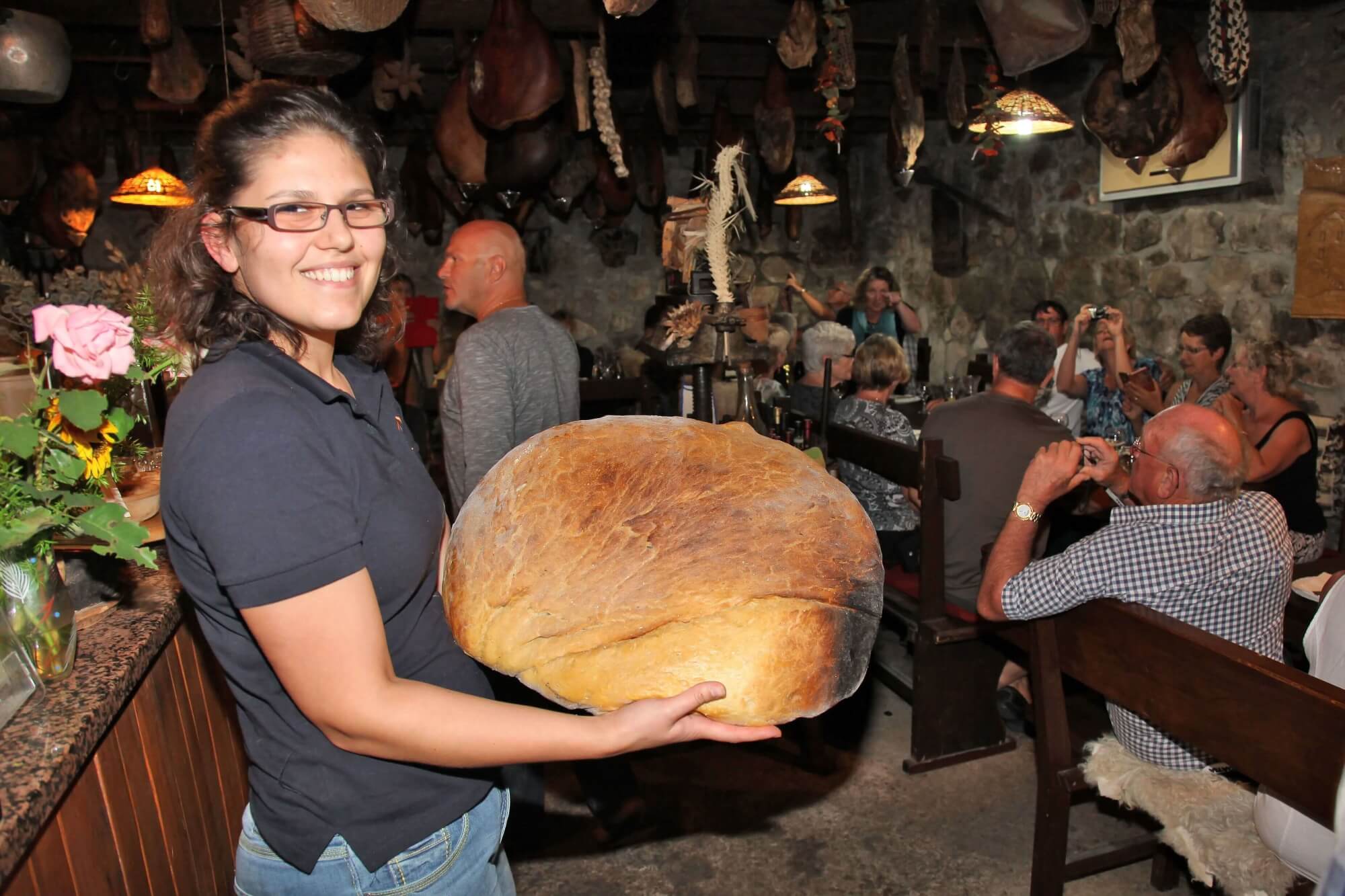 Bread from the peka at Agroturizam Antunović on Pelješac
Bread from the peka at Agroturizam Antunović on Pelješac
Seoski Tourism – translated as either village tourism or countryside tourism – is just that. Family farms that offer hospitality. These are some of the most homely and most welcoming accommodation experiences you can have in Croatia. Offering sights and sounds, tastes and flavours that you can't find anywhere else, visits or stays in Seoski Tourism places have long been loved by locals for weekend breaks or holidays outside peak summer. But, increasingly, these authentic Croatia experiences are being discovered by international visitors.
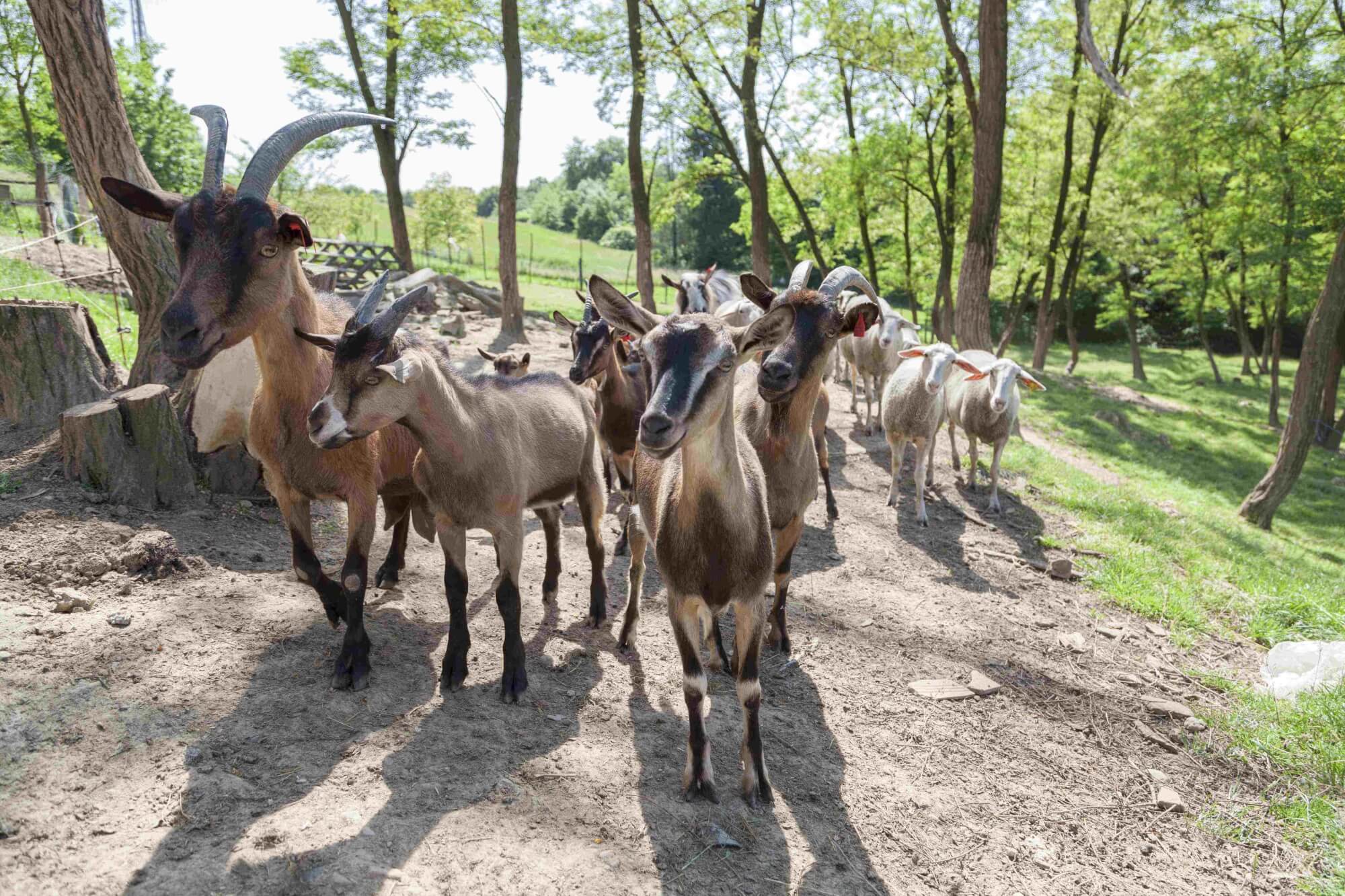 Moslavina goats at Kezele family farm © Davor Konjikušić
Moslavina goats at Kezele family farm © Davor Konjikušić
One institution trying to facilitate the growth in interest is Udruga ruralnog turizma Hrvatske - Croatian Rural Tourism Association. Since it was formed in 2016, they have tried to bring together Croatia's family farm hosts, to promote them and educate them, and to build bridges between these independents and tourist boards, tourist agencies, educators and even the wider world outside Croatia.
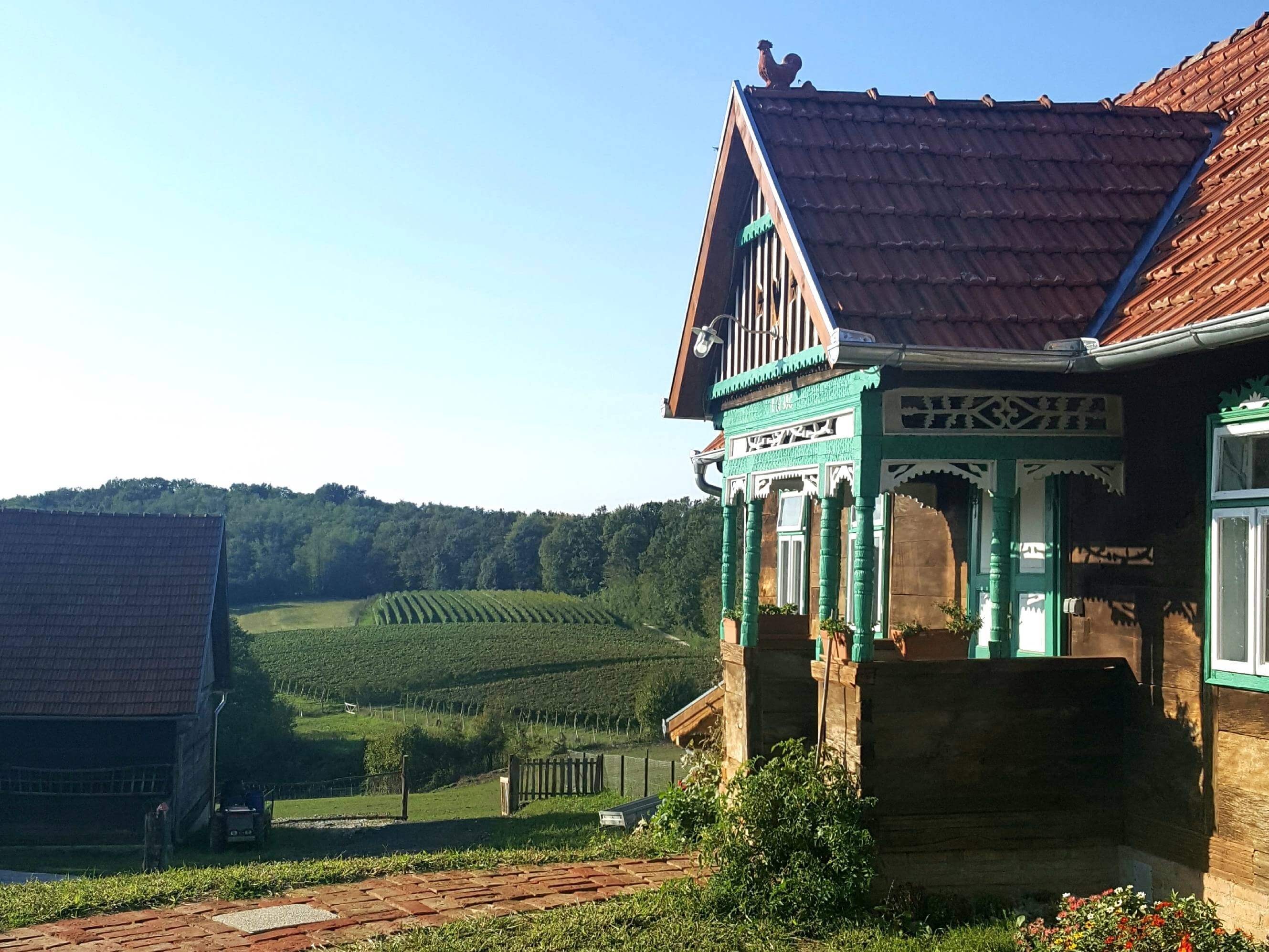 Seoski turizam Kezele in Šumećani, on the border of Zagreb County and Bjelovar Bilogora County © Davor Konjikušić
Seoski turizam Kezele in Šumećani, on the border of Zagreb County and Bjelovar Bilogora County © Davor Konjikušić
Based in Ivanić-Grad, Zagreb County, the Croatian Rural Tourism Association is currently touring the length and breadth of the country, holding workshops with as many Seoski Tourism family farms that will come. And if the farmwork doesn't allow them free time, then they can attend Croatian Rural Tourism Association workshops online.
On the eve of the association's online Seoski Tourism workshops for Central Croatia and Slavonia, TCN interviewed Aleksandra Kuratko, secretary of Udruga ruralnog turizma Hrvatske, to find out more about Seoski Tourism in Croatia.
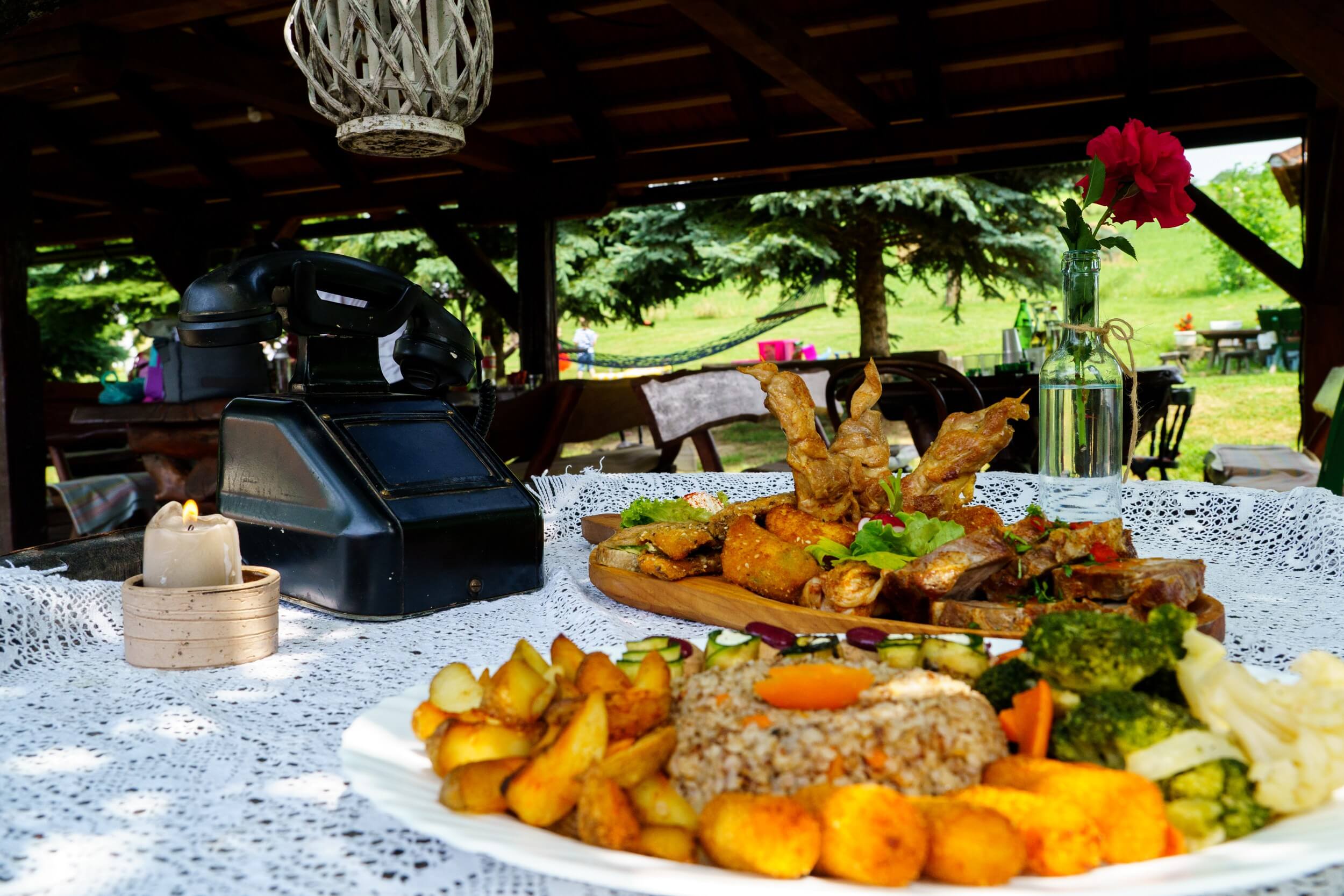 Prigorje specialties at Rakić family farm
Prigorje specialties at Rakić family farm
My name is Aleksandra Kuratko and I am secretary of Udruga ruralnog turizma Hrvatske. As an association, we are 5 years old.
We have 35 members, most of whom are service providers in what we call Seoski Tourism. We also have several tourist boards and two educational institutions as members.
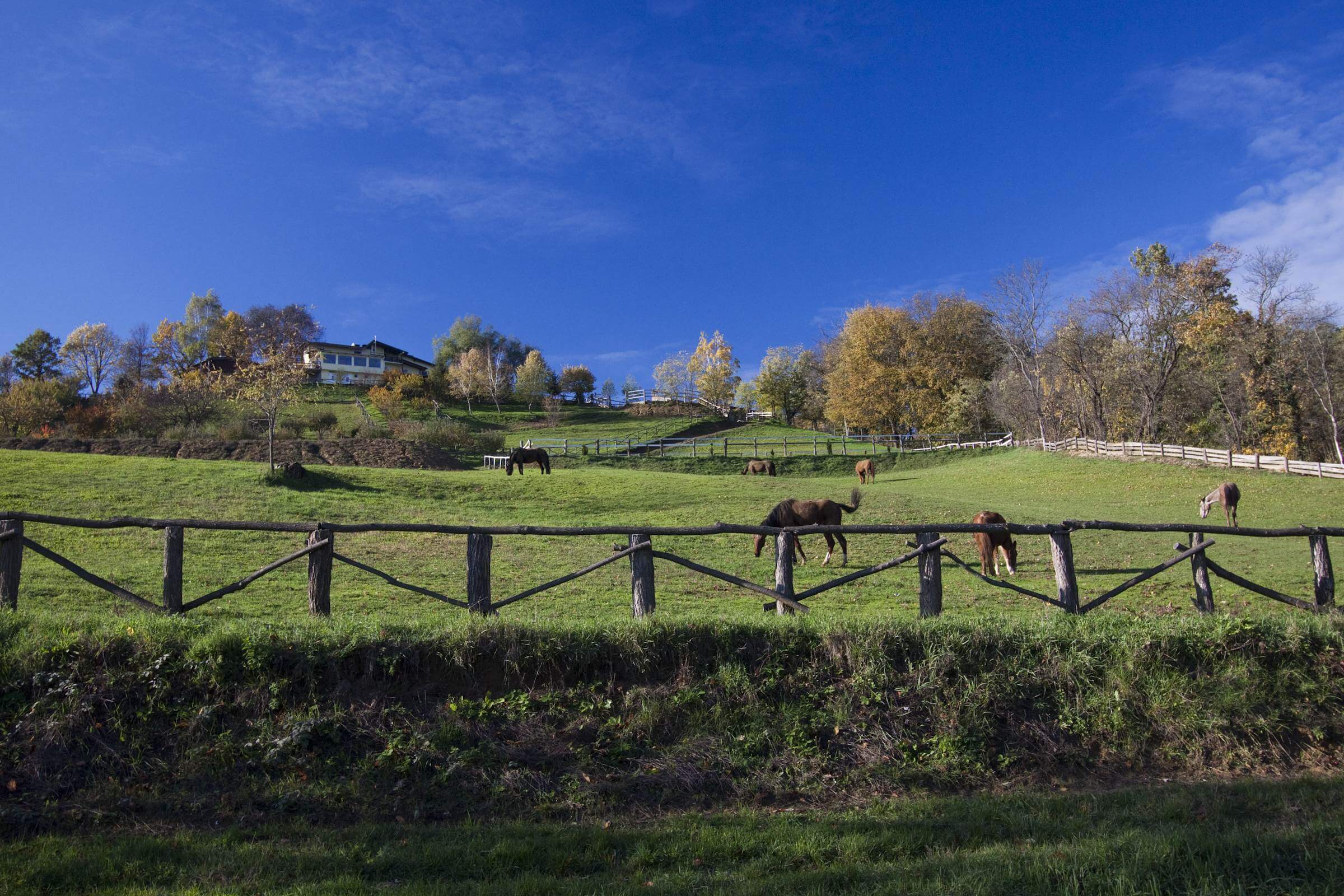 Bilogora horses in autumn at Agroturizam Na malenom brijegu © Vladimir Vlajinić
Bilogora horses in autumn at Agroturizam Na malenom brijegu © Vladimir Vlajinić
Seoski tourism is not quite the same as rural tourism, because rural tourism is many different types of tourism that happen in rural areas. Seoski tourism - which you might translate as village tourism - is quite specific. We assemble people who work in agriculture and who, at the same time, are also offering hospitality. In English, you might call them Farm Stays. Or Agro-tourism – a merging of agriculture and tourism.
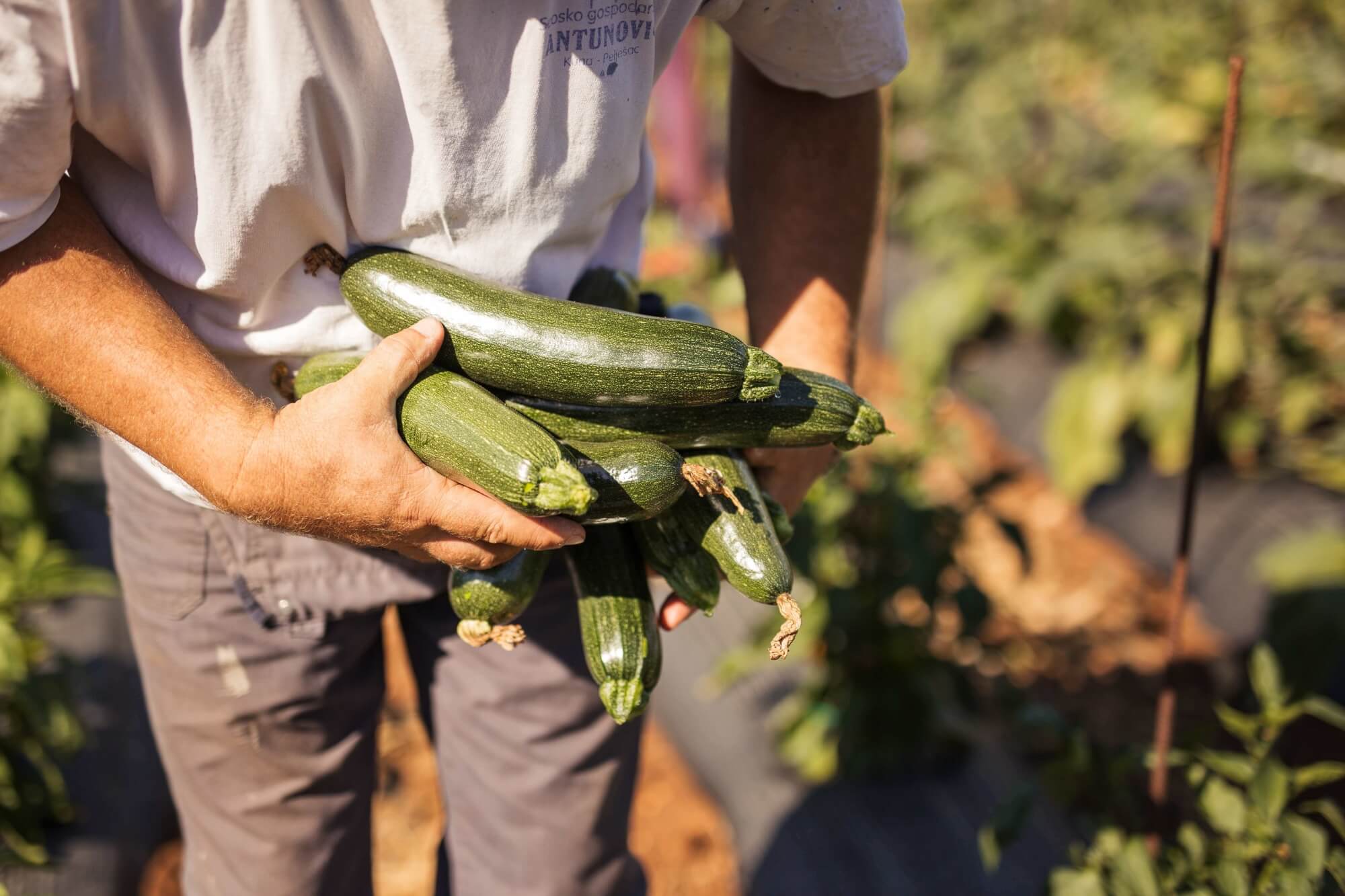 Fresh vegetables at Agroturizam Antunović on Pelješac
Fresh vegetables at Agroturizam Antunović on Pelješac
People who work on agricultural estates often take care of local cultural heritage. For example, they might maintain and renew traditional wooden or stone houses. Many also have etno collections, in which they preserve different objects from their region. Some of these objects might have been used in agriculture and households hundreds of years ago. So, they are preserving the cultural heritage of Croatian villages. This is what we call material cultural heritage. But, there's another kind.
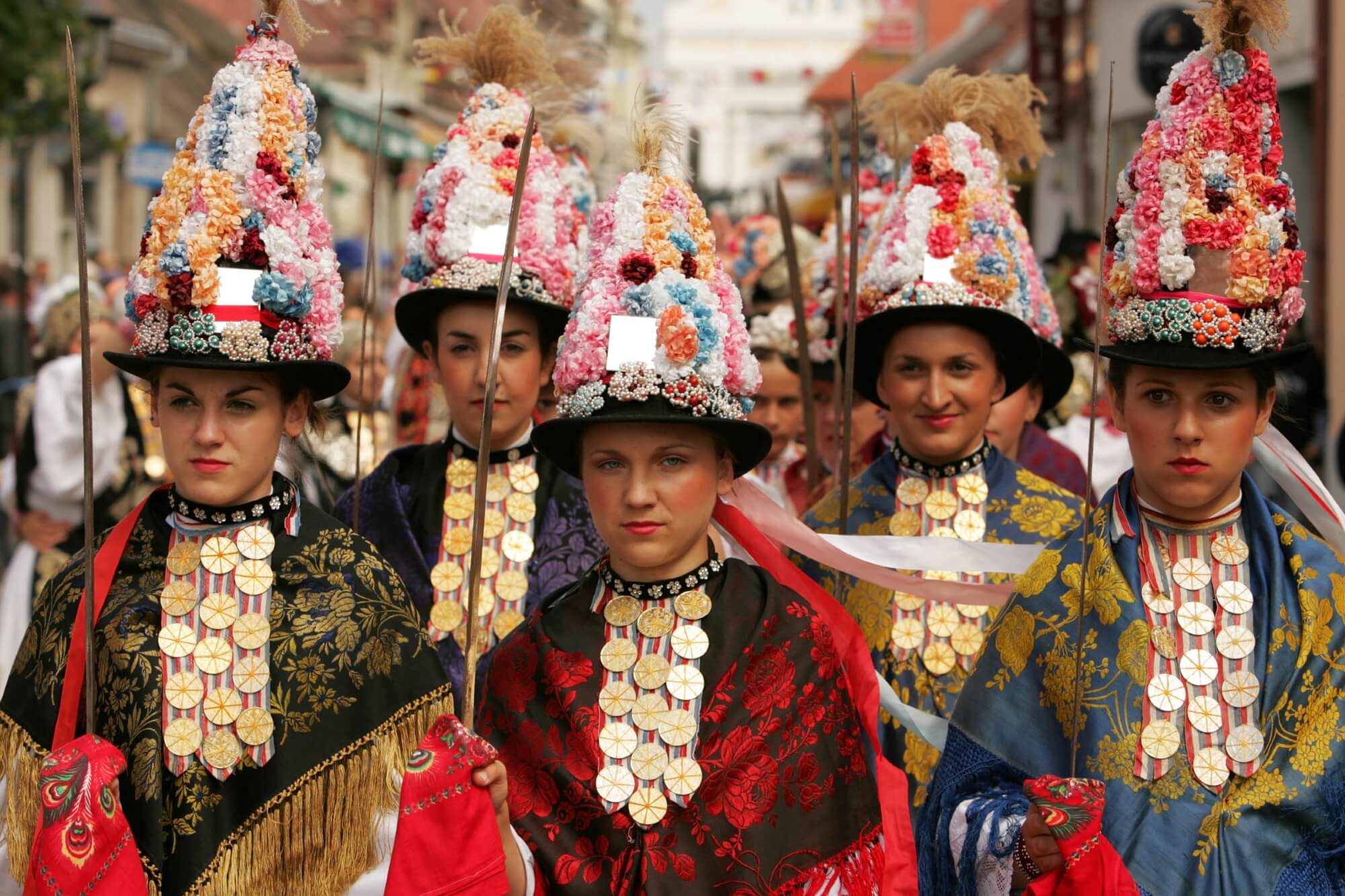 Cultural heritage preserved in one Slavonian village © Mario Romulić
Cultural heritage preserved in one Slavonian village © Mario Romulić
Non-material cultural heritage is also a part. That might be preserving old recipes of traditional, regionally-specific dishes. Or, it might be showcasing the songs and dance of local music.
We are currently running a project which is supported by the Croatian Ministry of Tourism and Sports in which we hold 37 Seoski Tourism workshops in the field all over Croatia. There will also be around 15 online workshops. The workshops are aimed at colleagues who currently operate in Seoski Tourism – they work in agriculture and offer hospitality. Also invited are local tourist boards and local action groups.
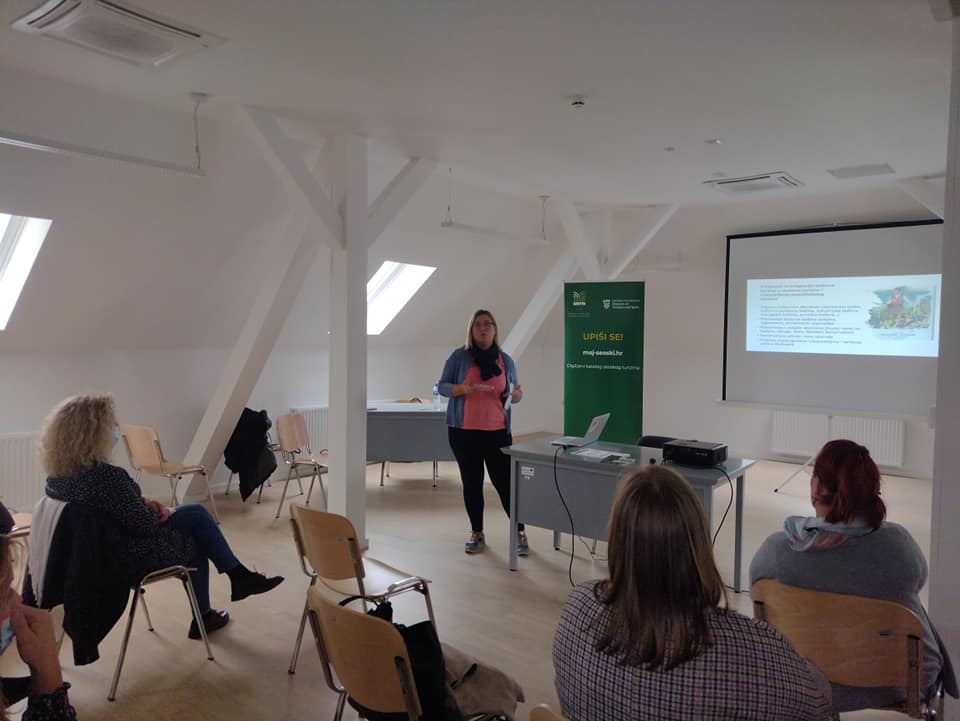 Photo from URTH workshop in Slatina
Photo from URTH workshop in Slatina
So far, we conducted 20 workshops in the regions of Central Croatia, Slavonia and Baranja, and Podunavlje. From next week until the end of the year, we will conduct the workshops in Istria, Kvarner, Lika and Dalmatia. Some service providers were not able to attend earlier workshops, because of work commitments of Covid. So, we decided to also offer access to the workshops online. Tomorrow is our first online workshop for Central Croatia and on Friday it's the online workshop for Slavonia.
These workshops are interactive discussions between our association, service providers and all other stakeholders. We discuss the legislative framework, which can be extremely complex. We talk about new trends in tourism for the post-pandemic era. We also discuss the importance of integrating cultural heritage in digital promotion.
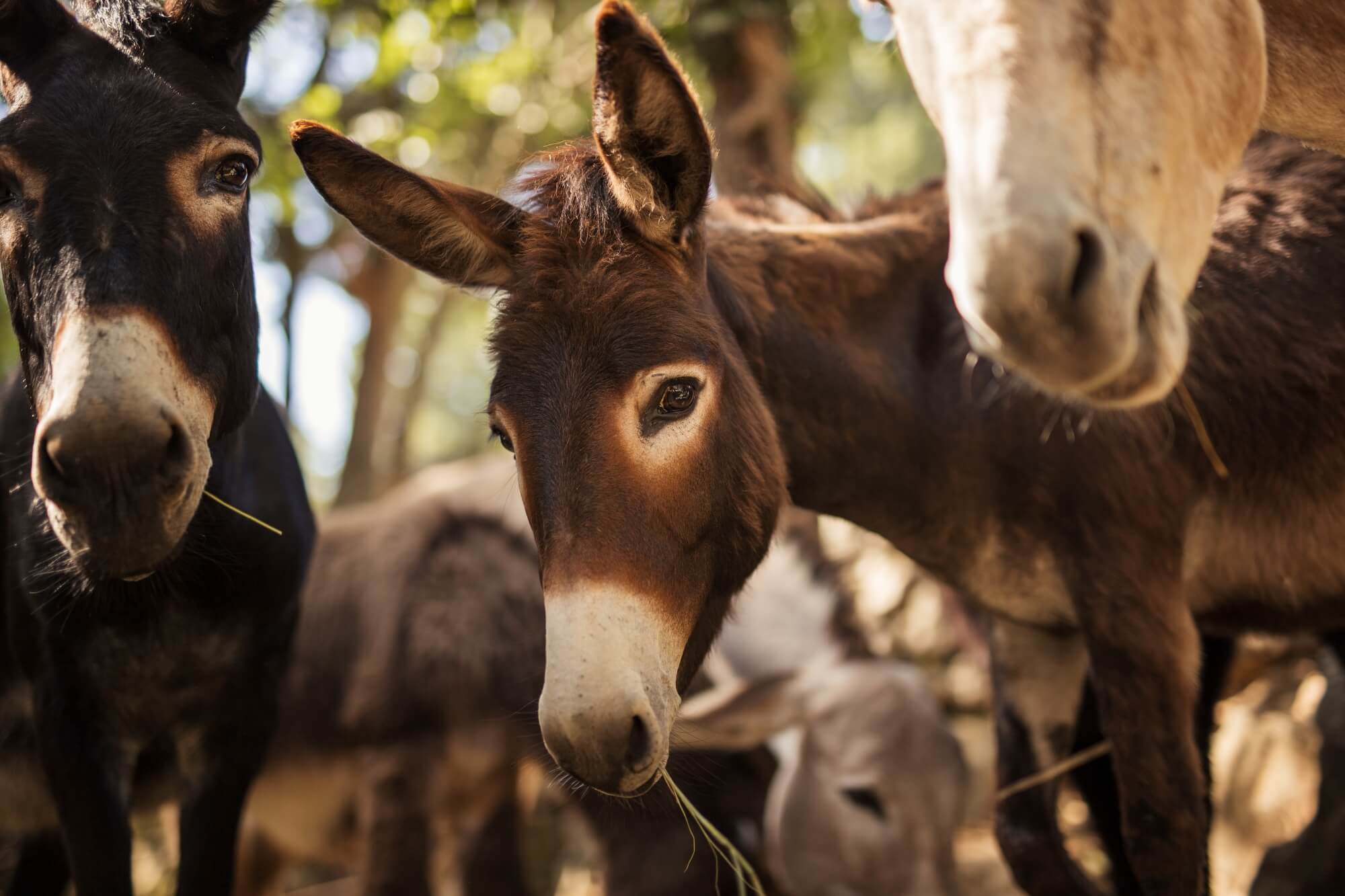 Donkey farm at Agroturizam Antunović on Pelješac
Donkey farm at Agroturizam Antunović on Pelješac
For the legislative framework, we have initiated the formation of a working group for the development of Seoski Tourism, which is now operating in the Croatian Ministry of Tourism and Sports. So, at the workshops, we ask if anyone is having issues. We collect the responses and address them in the working group.
Part of the workshop is the presentation of a new web application of Seoski Tourism, which we have developed with Croatian Ministry of Tourism and Sports. It has two purposes. One is to create a digital catalogue of Croatian Seoski Tourism. You can see region by region some of the Seoski Tourism options – currently around 40, those who have already enrolled.
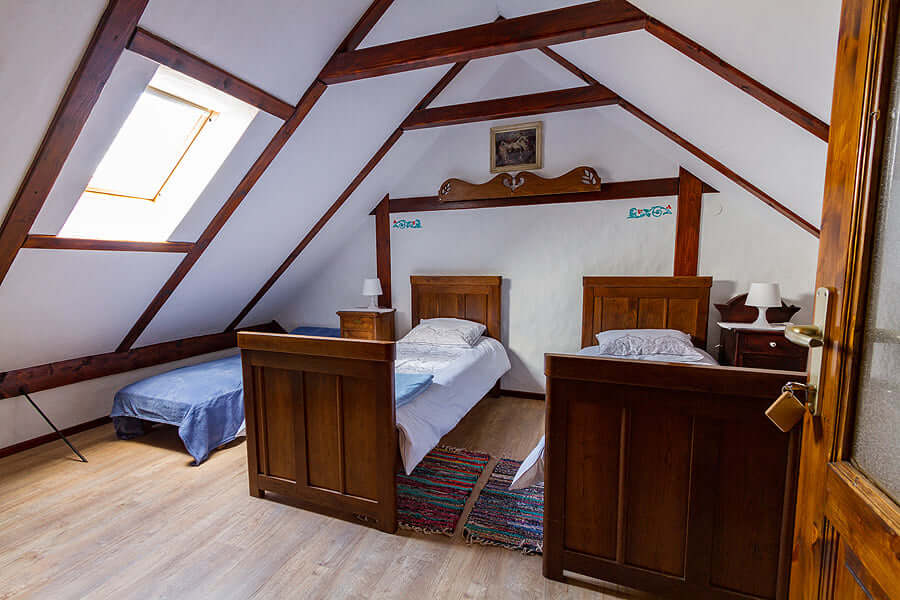 Podravina Etno rooms at Zlatni klas Otrovanec
Podravina Etno rooms at Zlatni klas Otrovanec
A version of the app is currently available on the website of the National Tourist Board. But, they are building a new website. The forthcoming version of the catalogue will likely be more user-friendly with many more functions and options. On the new website, Croatia's Seoski Tourism options will be detailed in many different languages. It should be a great resource not only for tourists but for travel agencies, journalists like you and for educational institutions. That's the reason we are devoting time in our workshops to encourage Seoski Tourism providers to enroll. We are just at the beginning of the process.
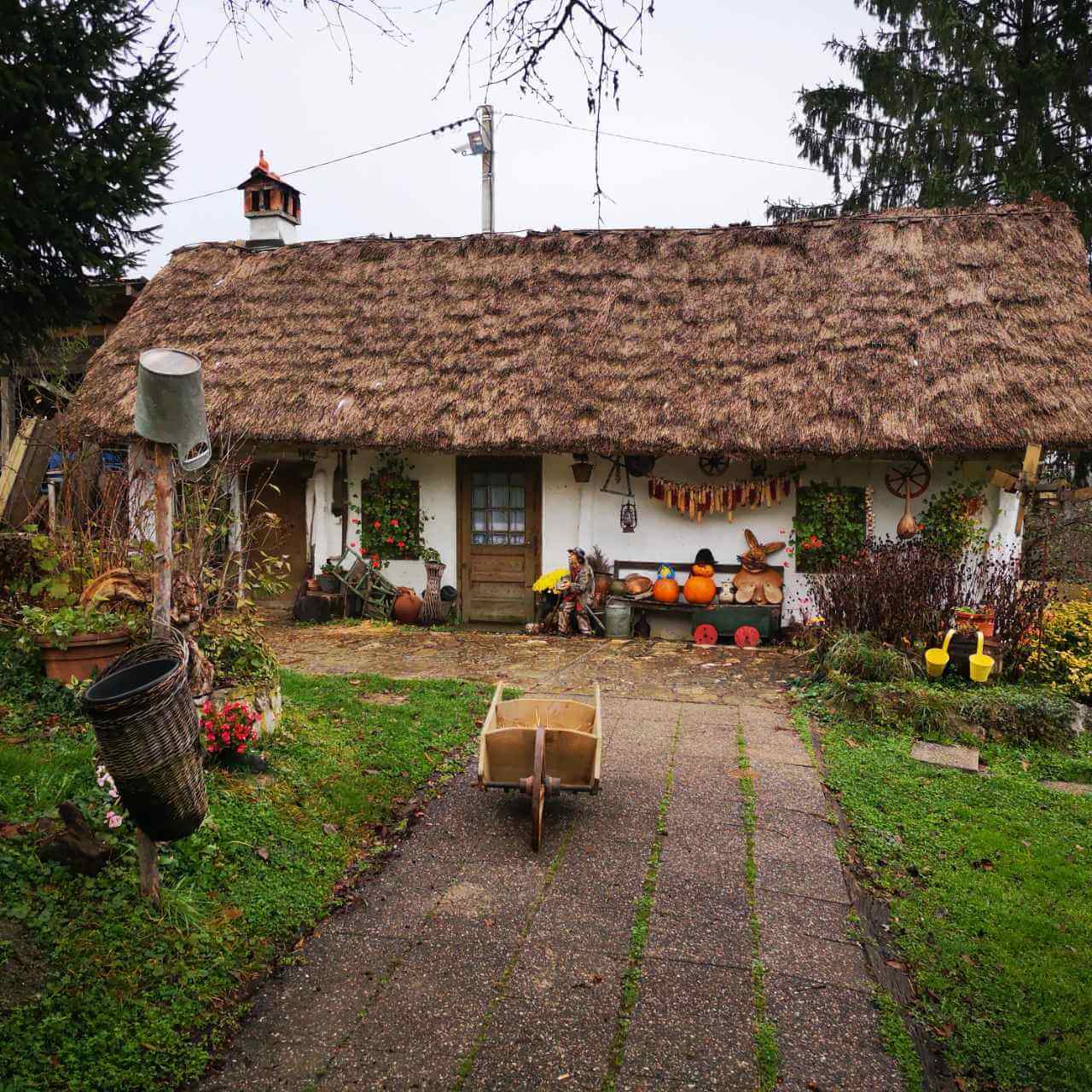 Grešna pilnica in Zagorje © Jasna Podboj
Grešna pilnica in Zagorje © Jasna Podboj
The second purpose of the app is to collect information about the service providers. This info will be used by our working group when defining a Croatian model of Seoski Tourism. So far, we have taken examples from Slovenia, Italy and other countries that are successful with Seoski Tourism. But, these models were entered into our legislative system without fully considering our distinct business and cultural environments. That is now about to change.
We are very happy that, following many years of partially successful advocacy, there is now political will at a ministerial level to really shape things up, to change the laws and regulations in order to facilitate Seoski Tourism. We want to encourage more Seoski Tourism, not to have people from agriculture being turned away because of the difficulty of the process and bureaucracy.
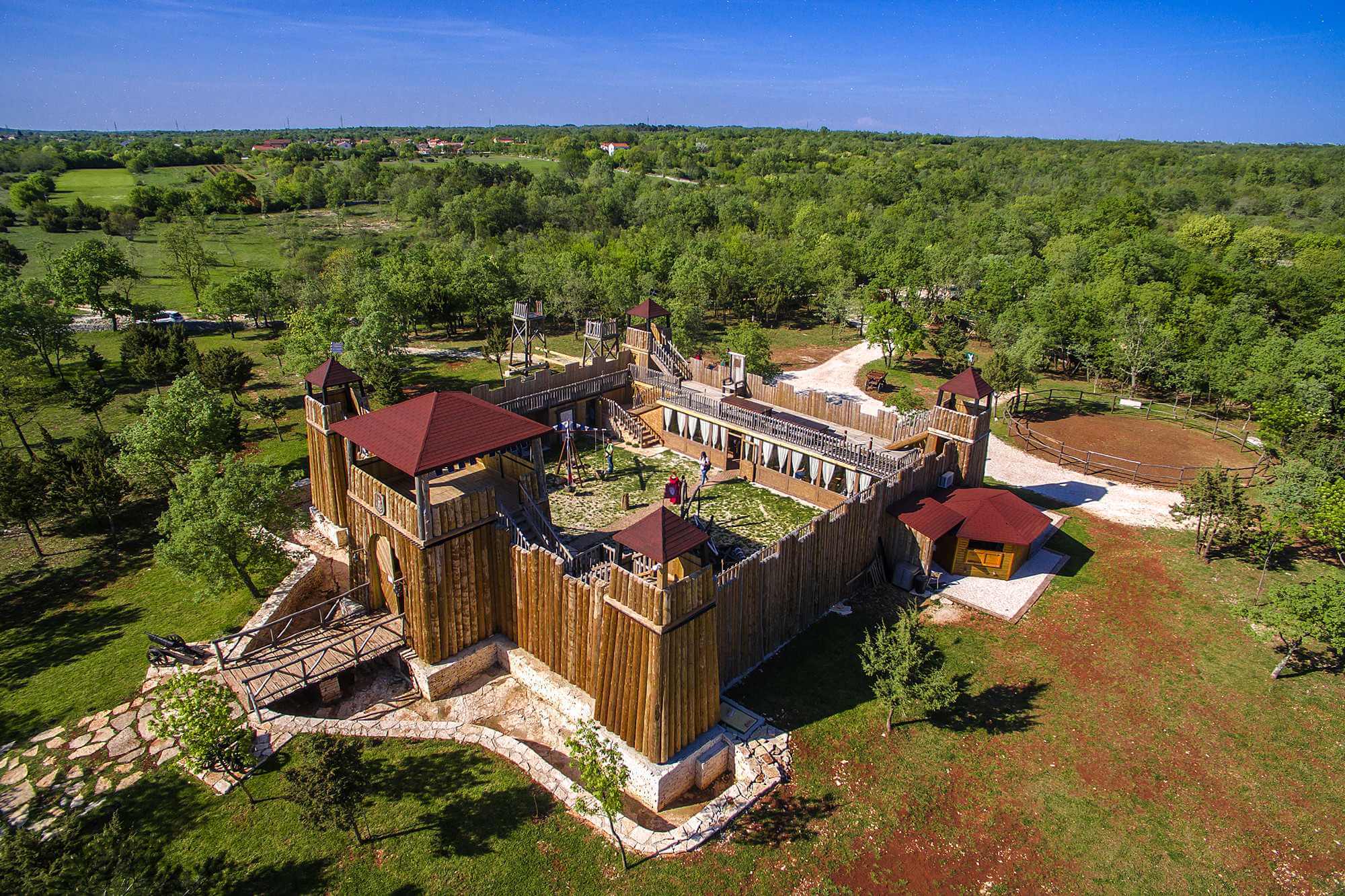 Medieval Theme Park San Michael © Silvia Otočan
Medieval Theme Park San Michael © Silvia Otočan
You said part of the workshops will focus on new trends. What are some of these?
Research has been done by a working group that is developing a new tourism strategy for Croatia. It's called Strategy for Sustainable Tourism to 2030. Under the auspices of this group, a number of research fields have been analysed.
The collected data shows that a huge percentage of tourists are now more inclined to eat locally grown and healthy food. They want to spend their time on estates that are run in accordance with ecological principles. So, they really care about issues like how waste is disposed of etc. They also pay a lot of attention to culture. They are curious to learn exactly how we are living, how we are working and how we produce things. They want to learn about our society and culture. And, importantly, they really care about how they spend their money. Above all, they want to spend money in areas that can help support local communities.
 Prigorje Breakfast at Rakić Family Farm
Prigorje Breakfast at Rakić Family Farm
For us, this is really important. Because Seoski Tourism answers these demands to an incredibly high level. We do produce local, healthy food. Not only on the agricultural estates where you can experience Seoski Tourism, but also from their neighbours who just do agriculture. We are concerned with ecology, we protect cultural heritage and the money spent in Seoski Tourism stays in local communities, where it has very beneficial effects.
In the digital promotion part of the workshops we are trying to persuade people about the importance of their online presence. Basically, these days, if you're not online, it's almost like you don't exist. So, we try to explain the importance of having good-quality photos, short videos and a regular online presence.
 Kulen, čvarci and other specialties at Baranjska kuća © Denis Despot
Kulen, čvarci and other specialties at Baranjska kuća © Denis Despot
That's interesting. In some cases, it might be like two different worlds colliding - people who work in a traditional industry and a traditional environment having to adapt to a very modern way of operating. There's also another potential collision when providers learn of the expectations within modern tourism. Because these people can no longer just work in agriculture. To operate in Seoski Tourism, you're also very much expected to also be a host.
Yes. All of our current service providers who are successful within Seoski Tourism are also great hosts. It's essential. You can see it in almost all of the reviews for this kind of tourism. Guests come for the food and drinks and surroundings, yes. But, what they value the most, what they remember the most, is the host part of the experience. On the estates of Croatian Seoski Tourism, guests are welcomed like family. Across all of Croatian tourism we are expected to be good hosts. It's part of our reputation and the reason why many people come here from all over the world. In Seoski Tourism, it is vital we live up to those expectations.
 Kezele family farm © Davor Konjikušić
Kezele family farm © Davor Konjikušić
Another aspect of this, which is a more recently-observed element, is that visitors often want an insight into the actual lives, even the personalities of their hosts. They want not only to taste the homemade sausages you make, but they also want to know how you do it, where you do it, how you learned to do that. When they go to Spain, they want to know how the people there make their wine. And, when they come to Croatia, they want to learn how we do it here.
So, all in all, those of us in Seoski Tourism are really busy. We are in agriculture, yes, but we are also in tourism and we are also online. With this more recently-observed aspect, we will need to try and devote even more time to our hosting. It can be difficult to balance the demands on your time. But, in our workshops, we are trying to persuade people to talk more about themselves, their lives, their cultural heritage. And, if there isn't time to do everything themselves, then to involve different and often younger generations of the family. Sometimes within the hosting or alternatively just with the online promotion and presence.
 Kezele family farm ethno collection © Davor Konjikušić
Kezele family farm ethno collection © Davor Konjikušić
I've visited some family farms that were right at the start of their journey with Seoski Tourism and they seemed surprised that I was at all interested in what they do and how they do it. I think maybe they thought I was a bit crazy.
Yes, that is a response we sometimes also see at first. I think it's because our generation takes a lot of things for granted. We sometimes think that what we do is just what we do. We are not so good at showcasing it. “Why would I show someone how I make my cheese? I make my cheese like my grandmother used to make it” But, for those who open their doors to Seoski Tourism, inquiries about how they do what they do are only increasing. So, they seem to appreciate how we advise them in the workshops.
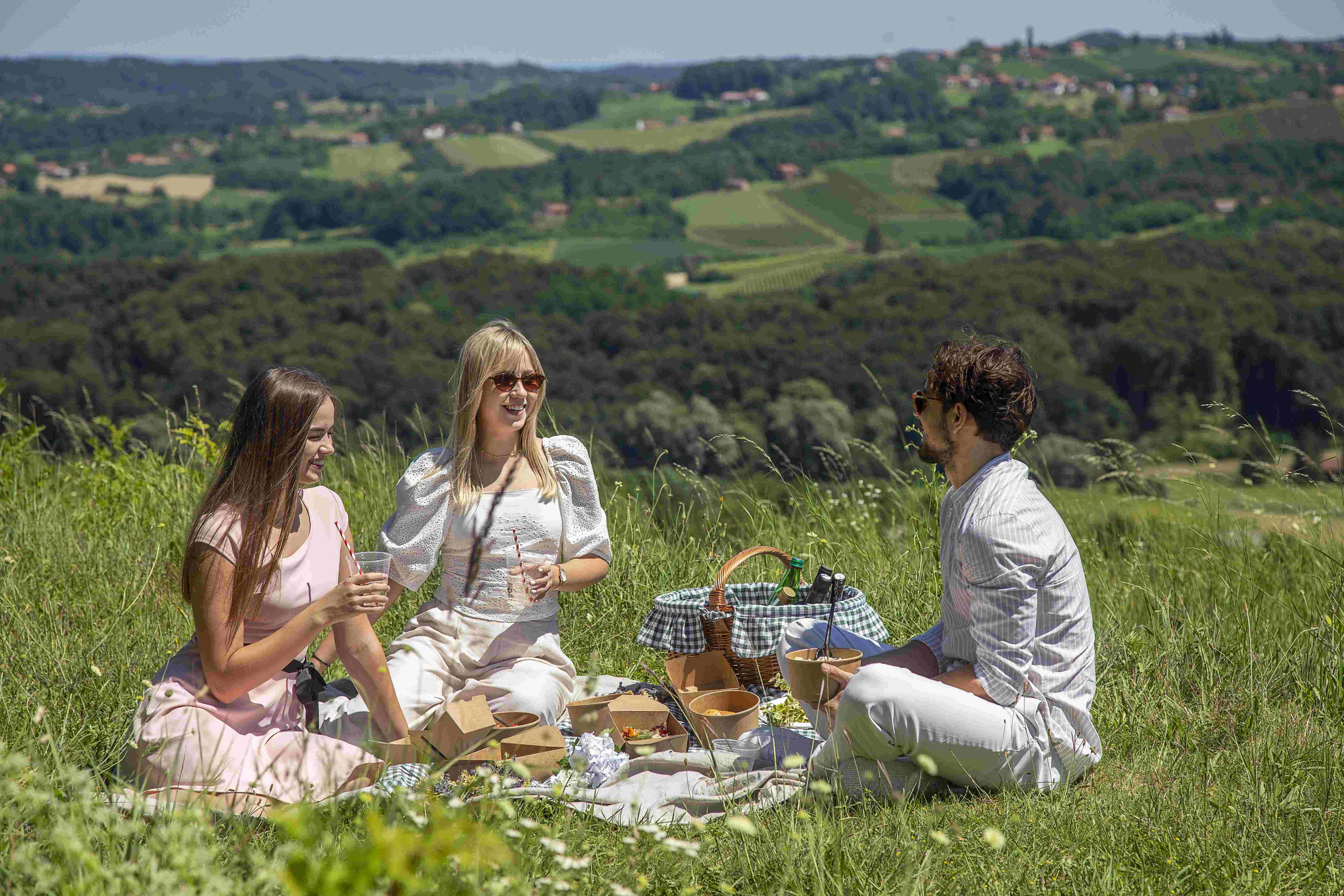 Picnic by Restaurant Međimurski dvori © Igor Nobilo
Picnic by Restaurant Međimurski dvori © Igor Nobilo
We are trying to let our producers know that Seoski Tourism is not just a platform to sell their produce and an overnight stay, but it's a full experience they can sell. There are agricultural farms in Austria that are established in tourism that you must pay only to visit. Of course, that doesn't happen currently anywhere in Croatia, even though some of our Seoski Tourism estates have sections that look like museums.
Some of these aspects are very new. And the feedback is great. I truly believe there are hidden treasures to be discovered in some Croatian villages. We are here to tell that story.
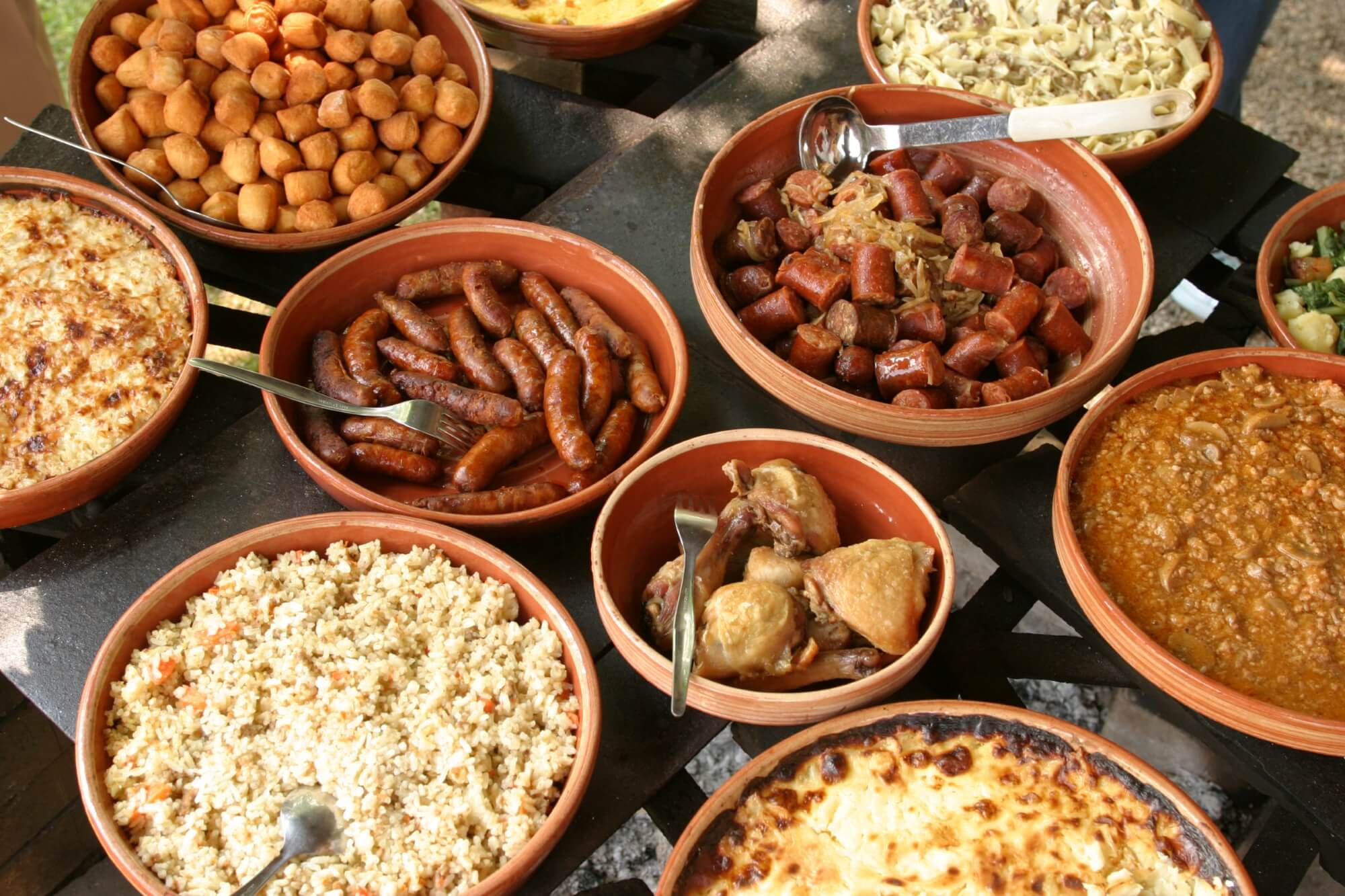 Selection of food from a Slavonian village © Mario Romulić
Selection of food from a Slavonian village © Mario Romulić
What is so rewarding about Croatian Seoski Tourism that international visitors would want to go to a traditional farm in some inland village instead of lying on the beach in Dalmatia for 14 days?
People come because they really want to see a different side of Croatia. And, there are many different aspects of Croatia to discover – not just Seoski Tourism, but also National Parks and Nature Parks. All of our current trends show us that more and more tourists are willing to come inland from the coast or to explore a different part of Croatia – inland Istria, for example, or continental Croatia.
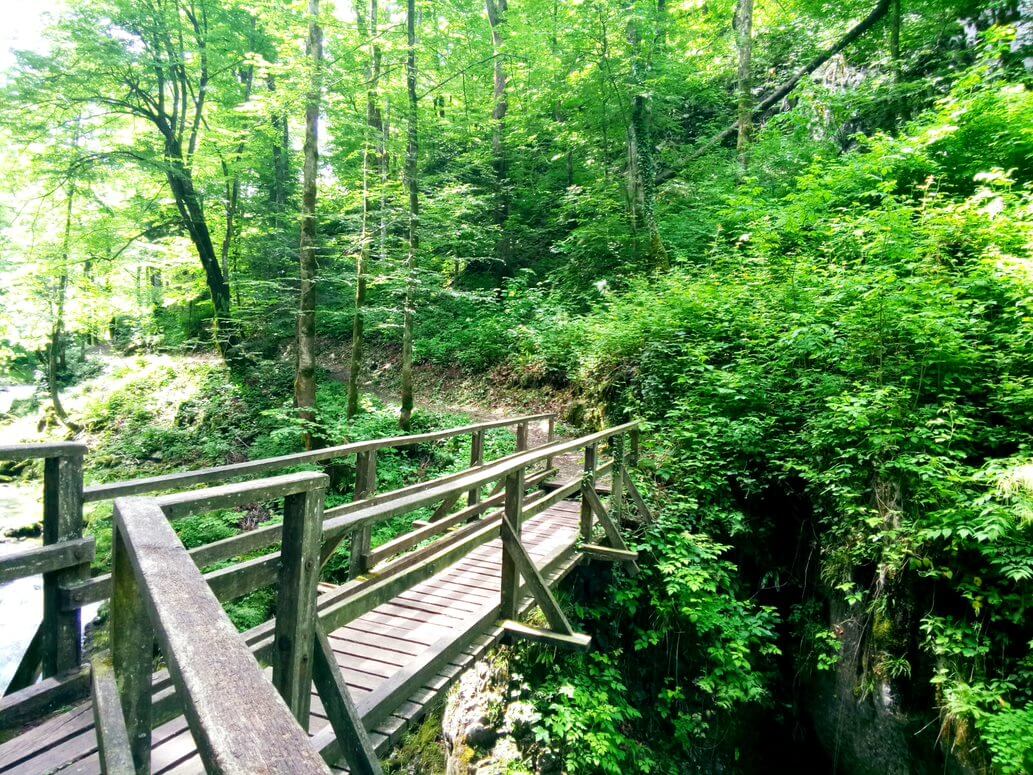 Kamačnik river canyon © Aleksandra Kuratko Pani
Kamačnik river canyon © Aleksandra Kuratko Pani
They really want to try authentic, local food. They want to eat healthy, to know what they are eating and how it is made. And, they want to experience flavours that are different from the usual ones they get from the supermarket.
 Traditional Međimurje table at Etno restaurant Međimurski dvori
Traditional Međimurje table at Etno restaurant Međimurski dvori
Also, I would say that with Seoski Tourism, people get to know better an authentic version of Croatia and its culture. It's a story we hear very often from our members. Some of them are visited by large groups from cruisers. These are people who might be on a cruise on the Adriatic and who journey inland for a day trip. Or, it might be a group who are cruising the Danube and disembark to visit a family farm in Slavonia, Baranja or Srijem.
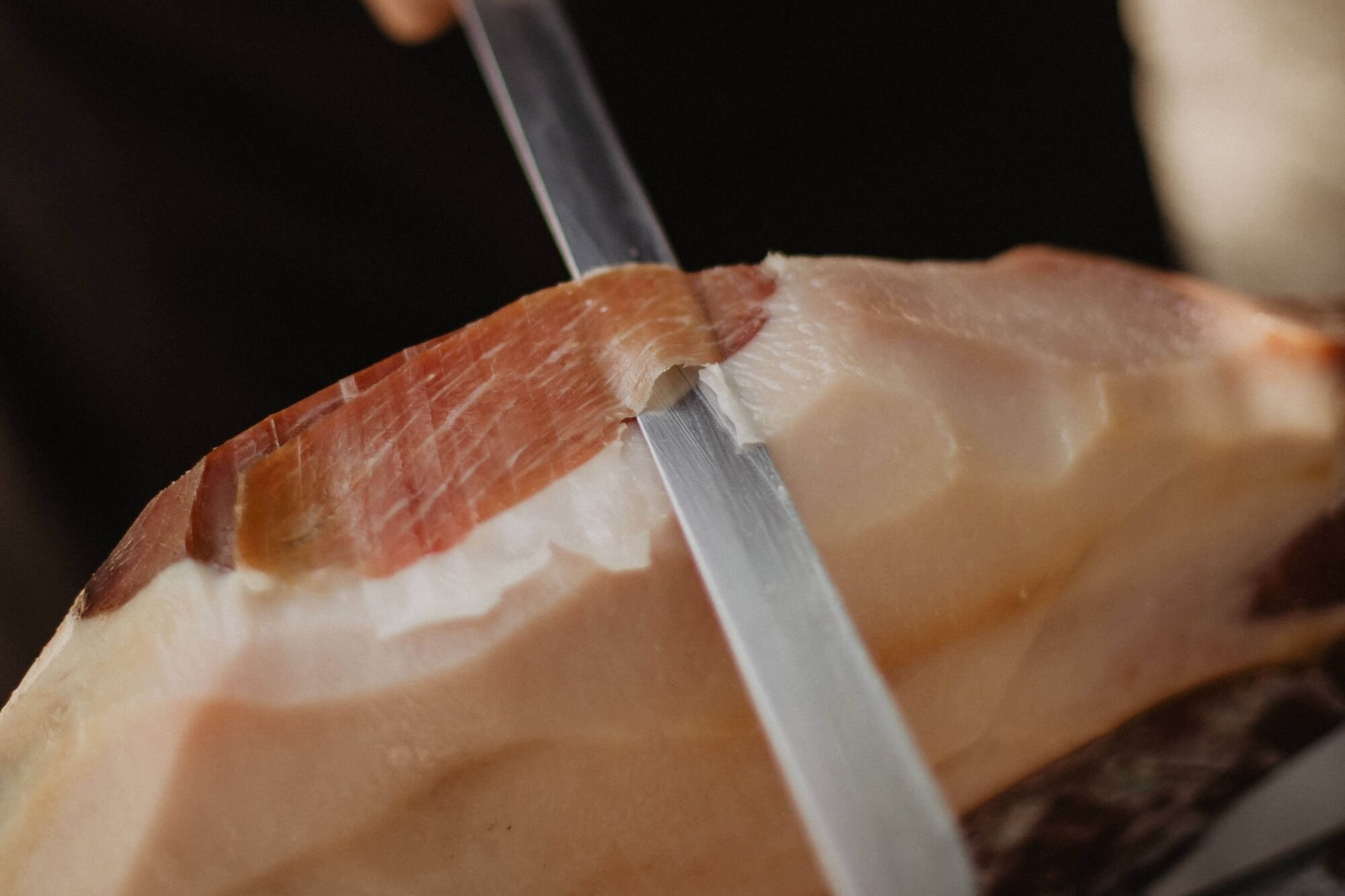 Prosciutto from Drniš at Agrotourism Kalpić © Ivana Kalpić
Prosciutto from Drniš at Agrotourism Kalpić © Ivana Kalpić
When they visit farming estates on day trips, it's very often a huge 'wow' moment for them. For many, in their minds, Croatia is simply sun and sea. And that's not entirely their fault. We, as a country, have done very little until now to promote alternative sides of Croatia. The visitors experience these wow moments because of the hospitality they receive and because of the tangible aspect of the visit. This is a modern aspect – people want to touch things, know how things feel, taste, smell. They want to ride on horses or feed them. Or take part in cultural activities. These parts of a visit to Seoski Tourism are very difficult to experience anywhere else.
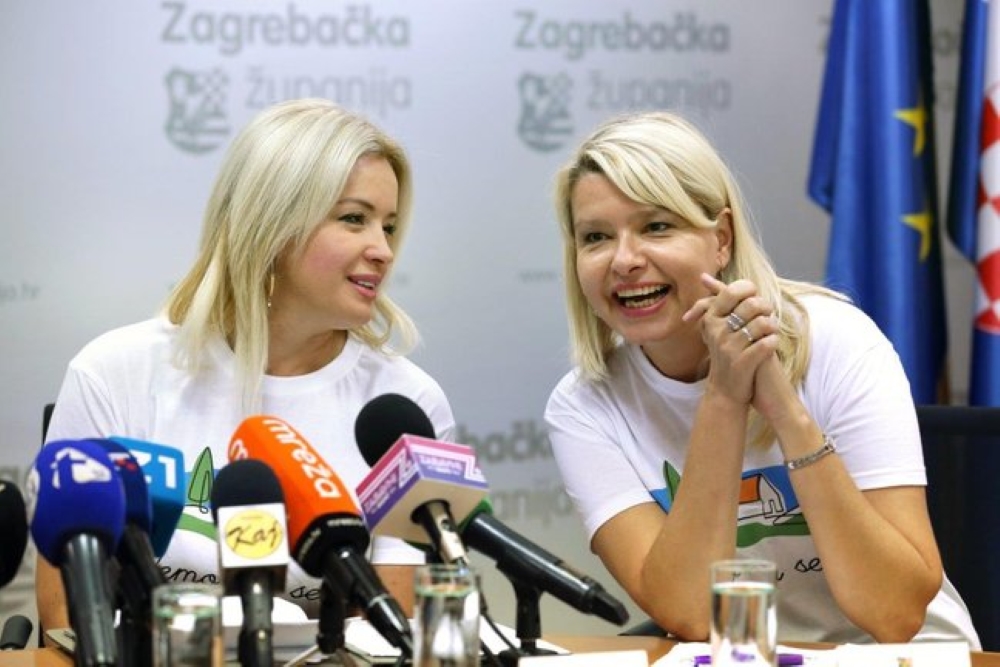 (left) Ivana Alilović, director of Zagreb County Tourist Board (right) Aleksandra Kuratko, secretary of Udruga ruralnog turizma Hrvatske (Croatian Rural Tourism Association) © Zagreb County
(left) Ivana Alilović, director of Zagreb County Tourist Board (right) Aleksandra Kuratko, secretary of Udruga ruralnog turizma Hrvatske (Croatian Rural Tourism Association) © Zagreb County
Udruga ruralnog turizma Hrvatske's online Seoski Tourism workshops begin today and their physical workshops continue next week in Istria.
If you'd like to read more about rural tourism in Croatia, then look here
World's Best Naive Art: Authentically Croatian Hlebine School
September 1, 2021 – We visit Podravina to discover the incredible Hlebine School of Croatian Naive Art
Croatia is sometimes difficult to find. Of course, with modern GPS and Croatia's nine international airports, getting here is no problem. But just where are you when you arrive?
Looking down at your dinner, the plate may hold a dish recognisable across the Mediterranean. Above your head, the architecture could be Roman, Austro-Hungarian or modern, indistinguishable. Ottoman influence lies everywhere from the best-loved handheld snacks to the mountain of slippers in every dwelling's doorway.
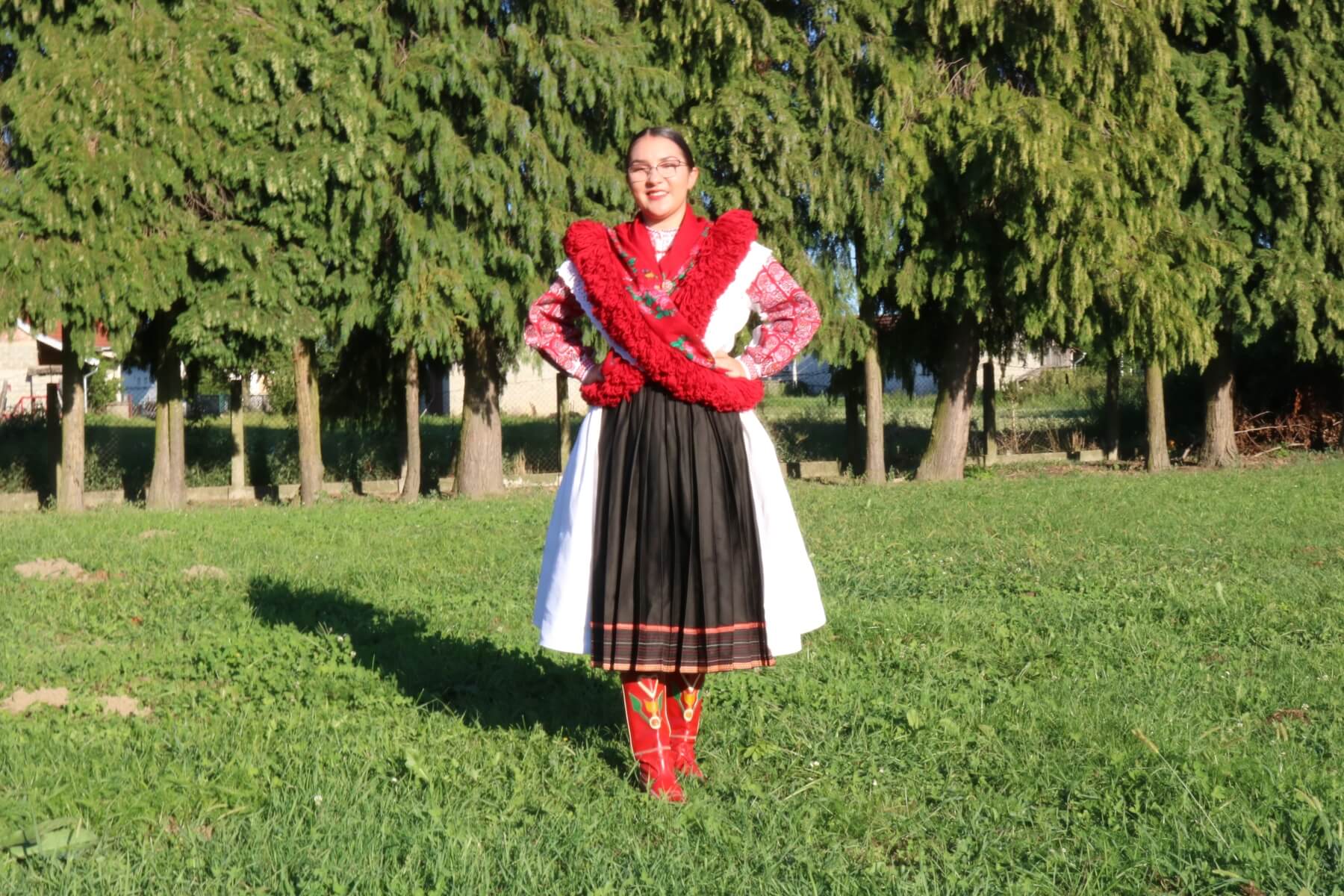 A friendly local wears the folk costume of the small region surrounding Koprivnički Ivanec, near Koprivnica. The costume features the incredibly intricate Ivanečki vez embroidery, which has been safeguarded locally for over 90 years and is now a protected part of Croatia's cultural heritage. Photo © Marc Rowlands.
A friendly local wears the folk costume of the small region surrounding Koprivnički Ivanec, near Koprivnica. The costume features the incredibly intricate Ivanečki vez embroidery, which has been safeguarded locally for over 90 years and is now a protected part of Croatia's cultural heritage. Photo © Marc Rowlands.
Actually, the true essence of the country you'll find in the Croatians themselves. And yet, their history is all too often obscured by the impositions of empires that once were here. However, we can find this history away from the major cities, the centres of influence. We find it in the villages. Specifically, in their folk costume, their folk song and folk dance. And we find it in the art there.
What is Naive Art?
 Cows In The Woods by Ivan Generalić, hanging at the Galerija naivne umjetnosti (Gallery of Naive Art), Hlebine © Koprivnica Town Museum
Cows In The Woods by Ivan Generalić, hanging at the Galerija naivne umjetnosti (Gallery of Naive Art), Hlebine © Koprivnica Town Museum
Naive art is any art made by someone who has received no formal or classical training. In this sense, the earliest discovered art of humans – cave paintings – are naïve art. However, there is nothing the classical art world likes more than specifically defining art movements. And, to them, the modern era of European Naive Art begins in the late 19th Century, with a growing appreciation of painters like French Post-Impressionist Henri Rousseau (1844–1910).
Because of the lack of formal, classical or academic training, it is said that common characteristics exist within the work of many Naive Artists. Specifically, these characteristics stem from an ignorance of strict perspective. Naive Artists often do not mute colours or lessen detail with distance. Also, they often don't attempt to accurately decrease the size of objects at distance.
Croatian culture as a part of national identity
 Horned horse by Ivan Generalić, hanging at the Galerija naivne umjetnosti (Gallery of Naive Art), Hlebine © Koprivnica Town Museum
Horned horse by Ivan Generalić, hanging at the Galerija naivne umjetnosti (Gallery of Naive Art), Hlebine © Koprivnica Town Museum
Croatian Naive Art is one of the best recognised and best-loved in the world. In truth, Croatia's movement doesn't begin to emerge until well into the 20th Century. Although, it is important to view the country's Naive Art within its broader search for a Croatian national identity. The roots of this movement stem back over 100 years prior to the emergence of Croatian Naive Art, beginning with the foundation of the Illyrian movement, Matica Hrvatska and more.
This older movement of national awakening had strong preoccupations with language, written text and cultural identity. Actually, its instigators were very much the educated intelligentsia of cities like Zagreb.
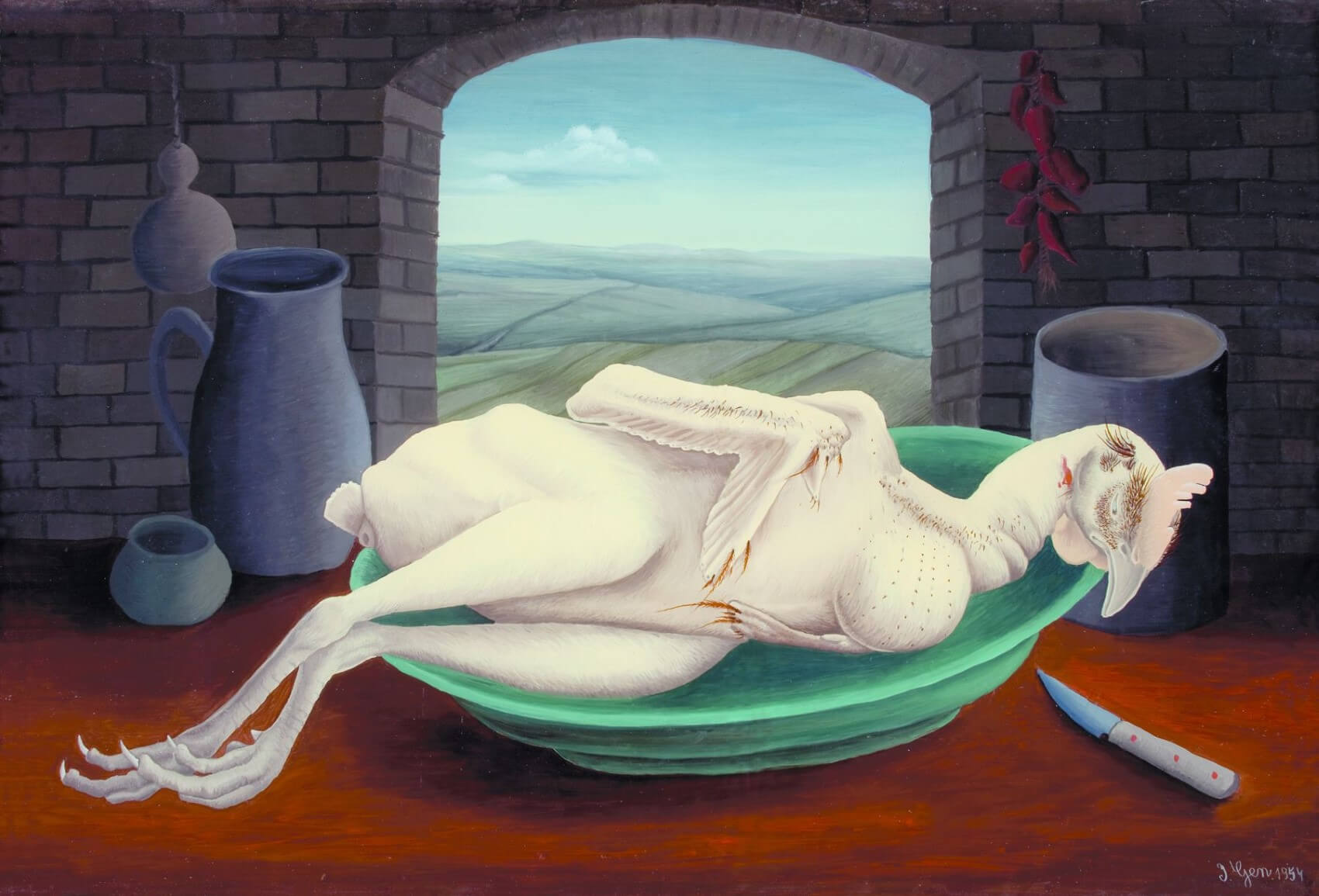 'A Battered Rooster' by Ivan Generalić, hanging at the Galerija naivne umjetnosti (Gallery of Naive Art), Hlebine © Koprivnica Town Museum
'A Battered Rooster' by Ivan Generalić, hanging at the Galerija naivne umjetnosti (Gallery of Naive Art), Hlebine © Koprivnica Town Museum
Before the end of World War I, Russia had undergone two revolutions. After the war, the German, Austro-Hungarian and Ottoman empires collapsed. Much of Europe was plunged into over half a decade of political upheaval - revolts, unrest and strikes by workers. Mostly socialist in sentiment - organised by workers and disillusioned former soldiers – this unrest and the accompanying birth of new nations lay not in the hands of the inner-city intelligentsia. And, many believed the cultural and artistic expression which reflected this new era should also come from the proletariat.
Krsto Hegedušić and the Earth Group (Grupa Zemlja)
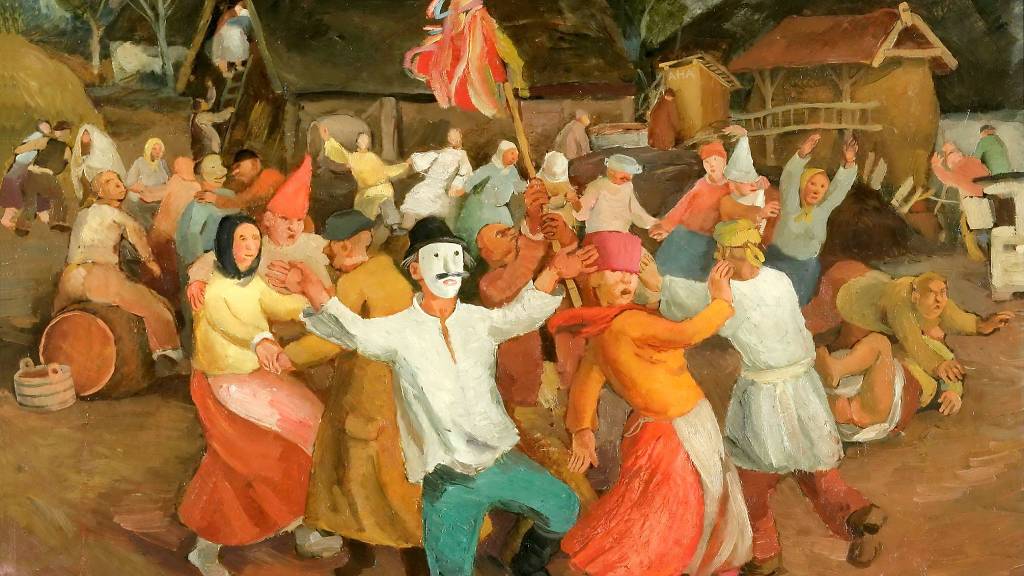 Krsto Hegedušić 'poklade' © Muzej moderne i suvremene umjetnosti Rijeka (MMSU)
Krsto Hegedušić 'poklade' © Muzej moderne i suvremene umjetnosti Rijeka (MMSU)
One Croat who believed strongly in this was painter Krsto Hegedušić. He co-founded the Earth Group in 1929 during a challenging period for Croatia. Europe was still reaping the dire economic repercussions of the First World War. Croatia had finally been freed of Austro-Hungarian hegemony, only to be forced into existing within another monarchy.
The founding beliefs of the Earth Group were that authentic artistic expression should be a product of the time and space whence it came and should be free of foreign influence. Art should not be created for the sake of art, but to depict an actual reality.
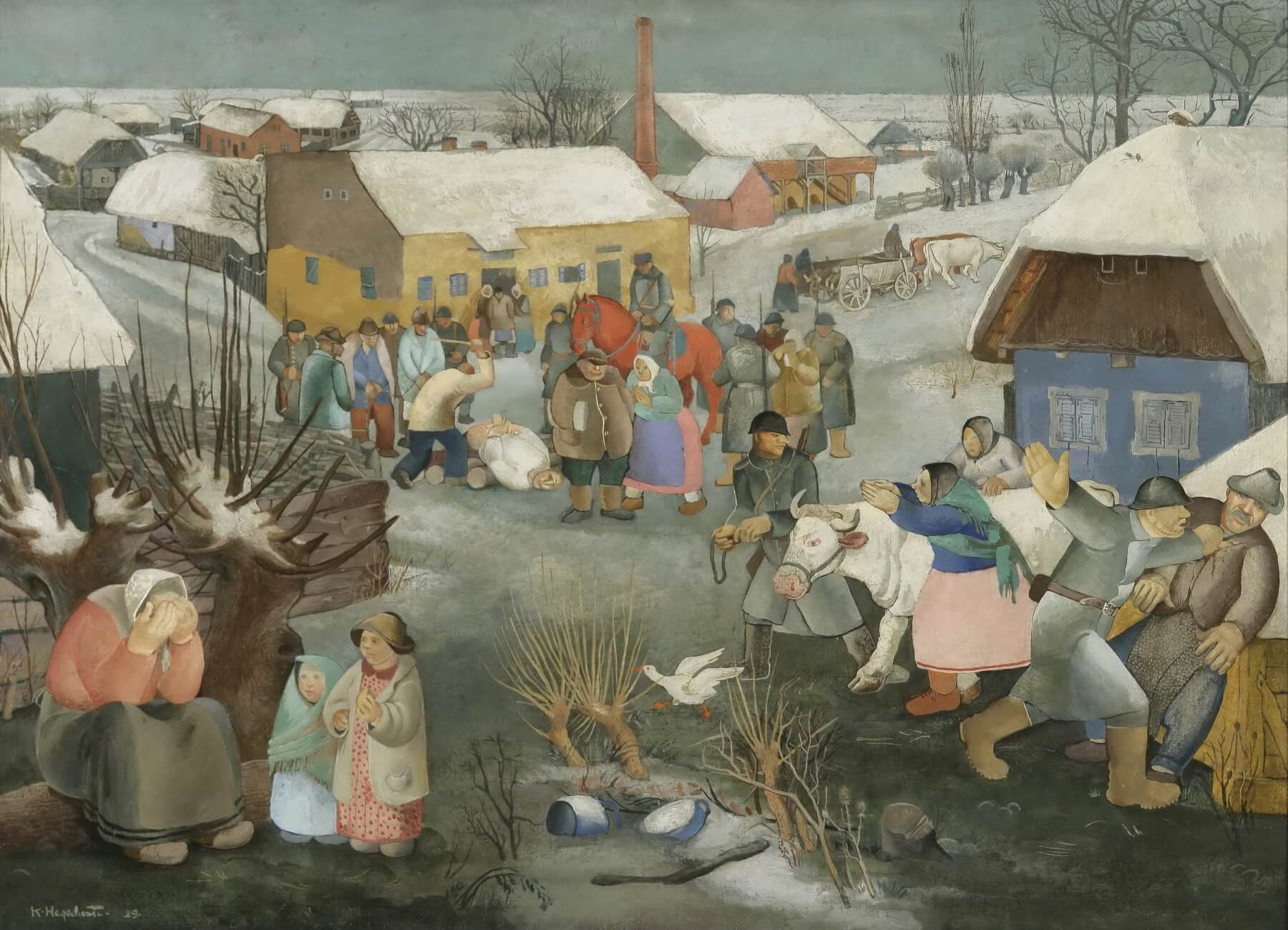 Krsto Hegedušić 'Rekvizicija (Requisition)', 1929 © Museum of Modern and Contemporary Art, Rijeka
Krsto Hegedušić 'Rekvizicija (Requisition)', 1929 © Museum of Modern and Contemporary Art, Rijeka
Krsto Hegedušić himself was very much a product of his studies. In 1920 he enrolled in what is today the Academy of Fine Arts in Zagreb. After graduating, he spent an additional two years on a scholarship in Paris. And yet, as a painter, his subject matter often reflected the world around him. Social critiques, within his work he depicted everyday poverty and the exploitation of Croatian peasants.
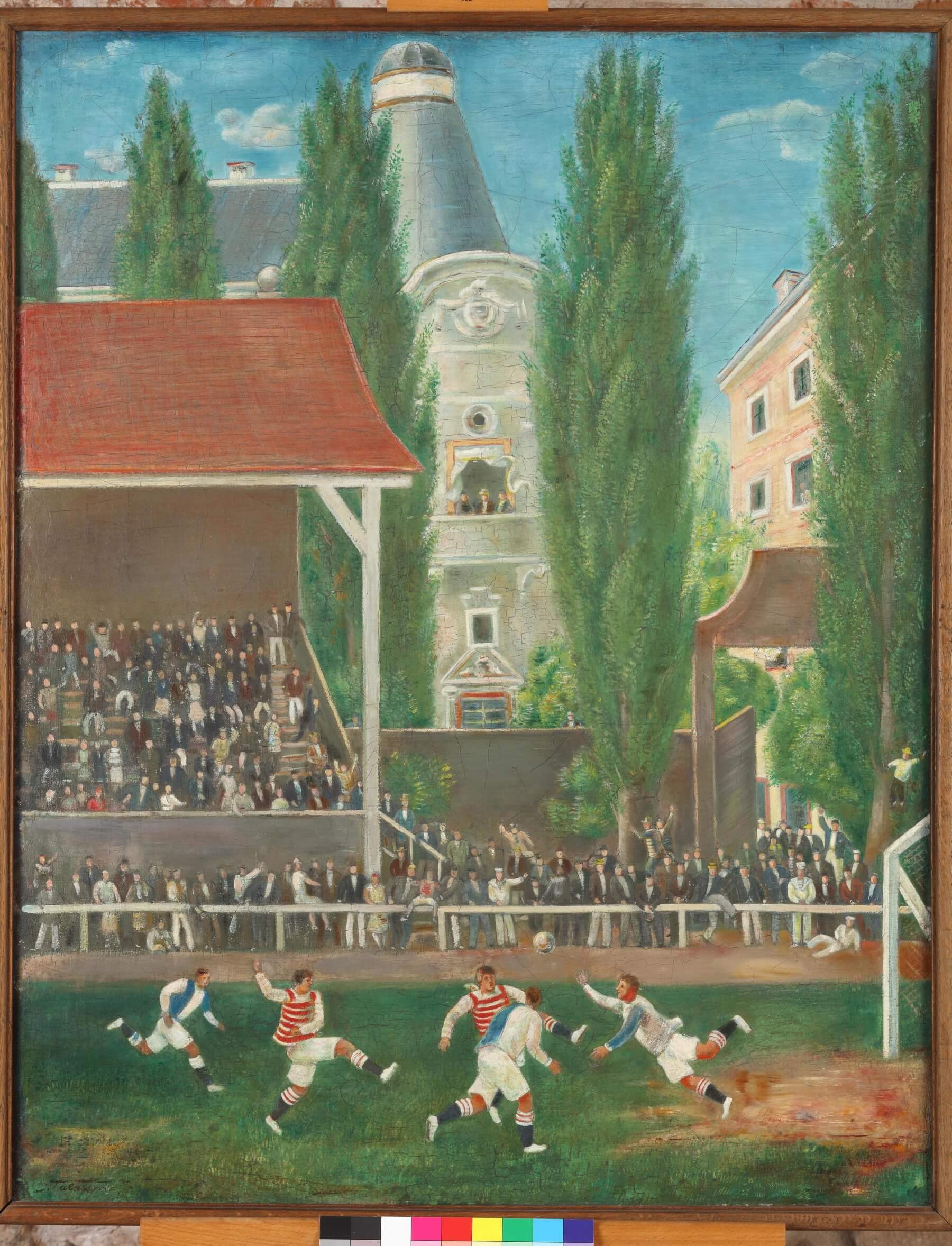 'Football match' by another of the Earth Group's founding members, Ivan Tabaković, 1927 © Gallery of Matica srpska, Novi Sad
'Football match' by another of the Earth Group's founding members, Ivan Tabaković, 1927 © Gallery of Matica srpska, Novi Sad
Born in Petrinja, Krsto Hegedušić spent summer holidays in the idyllic countryside and agricultural land surrounding his father's birth village of Hlebine, Podravina. When he was aged just 8 years old, Krsto's father died. Subsequently, the family moved to Hlebine. Later, Krsto would spend time living in Zagreb, not least for the duration of his studies. But, just one year into the life of the Earth Group, Krsto Hegedušić discovered a teenage artist back in Hlebine.
Hlebine School First Generation: Ivan Generalić, Franjo Mraz and Mirko Virius
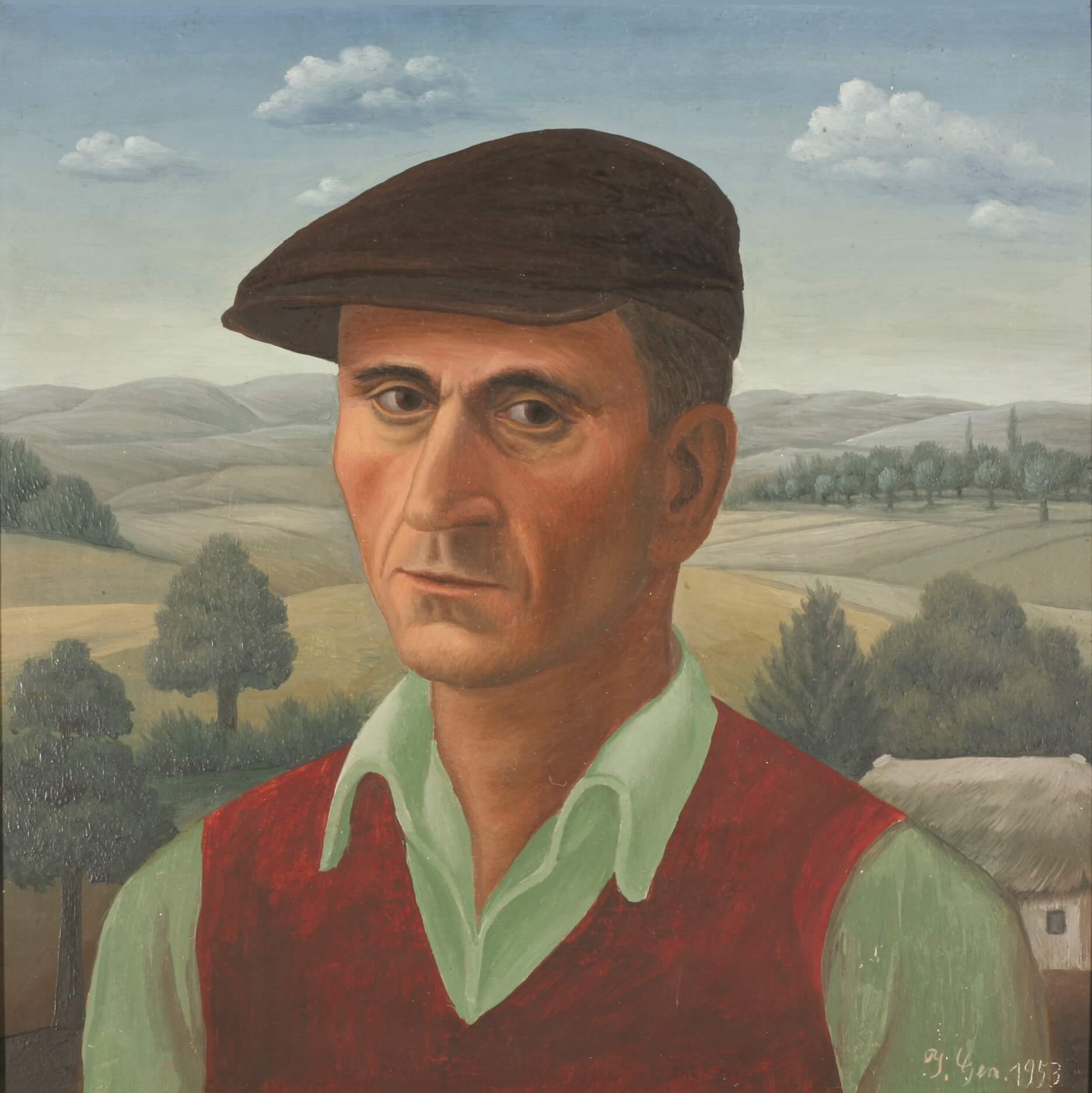 Self-portrait by Ivan Generalić, hanging at the Galerija naivne umjetnosti (Gallery of Naive Art), Hlebine. Photo © Koprivnica Town Museum
Self-portrait by Ivan Generalić, hanging at the Galerija naivne umjetnosti (Gallery of Naive Art), Hlebine. Photo © Koprivnica Town Museum
When we speak of the Hlebine School within Croatian Naive Art we are not actually talking about a building, an institution of learning. After all, the very definition of a Naive Artist is they are not classically trained. Instead, the Hlebine School is a discipline. And, more so than any Croatian Naive Art that followed, it is quite easy to define.
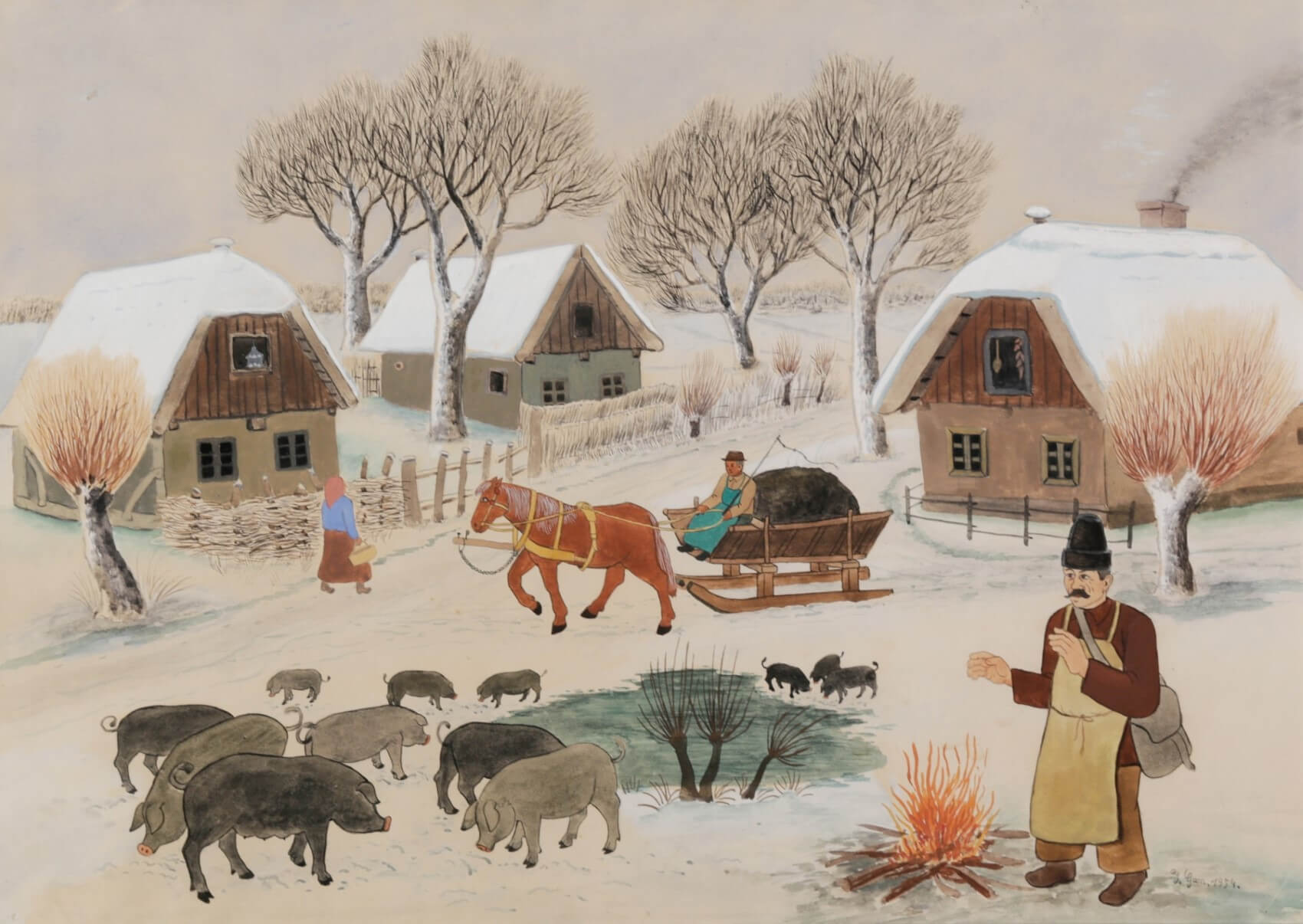 'Kanas' by Ivan Generalić, hanging at the Galerija naivne umjetnosti (Gallery of Naive Art), Hlebine © Koprivnica Town Museum
'Kanas' by Ivan Generalić, hanging at the Galerija naivne umjetnosti (Gallery of Naive Art), Hlebine © Koprivnica Town Museum
Within its first generation, the three most prominent artists are Ivan Generalić, Franjo Mraz and Mirko Virius. Both Ivan Generalić and Franjo Mraz were born, lived and were discovered by Krsto Hegedušić in the village of Hlebine. Mirko Virius was from Đelekovec, less than 15 kilometres to their north-west.
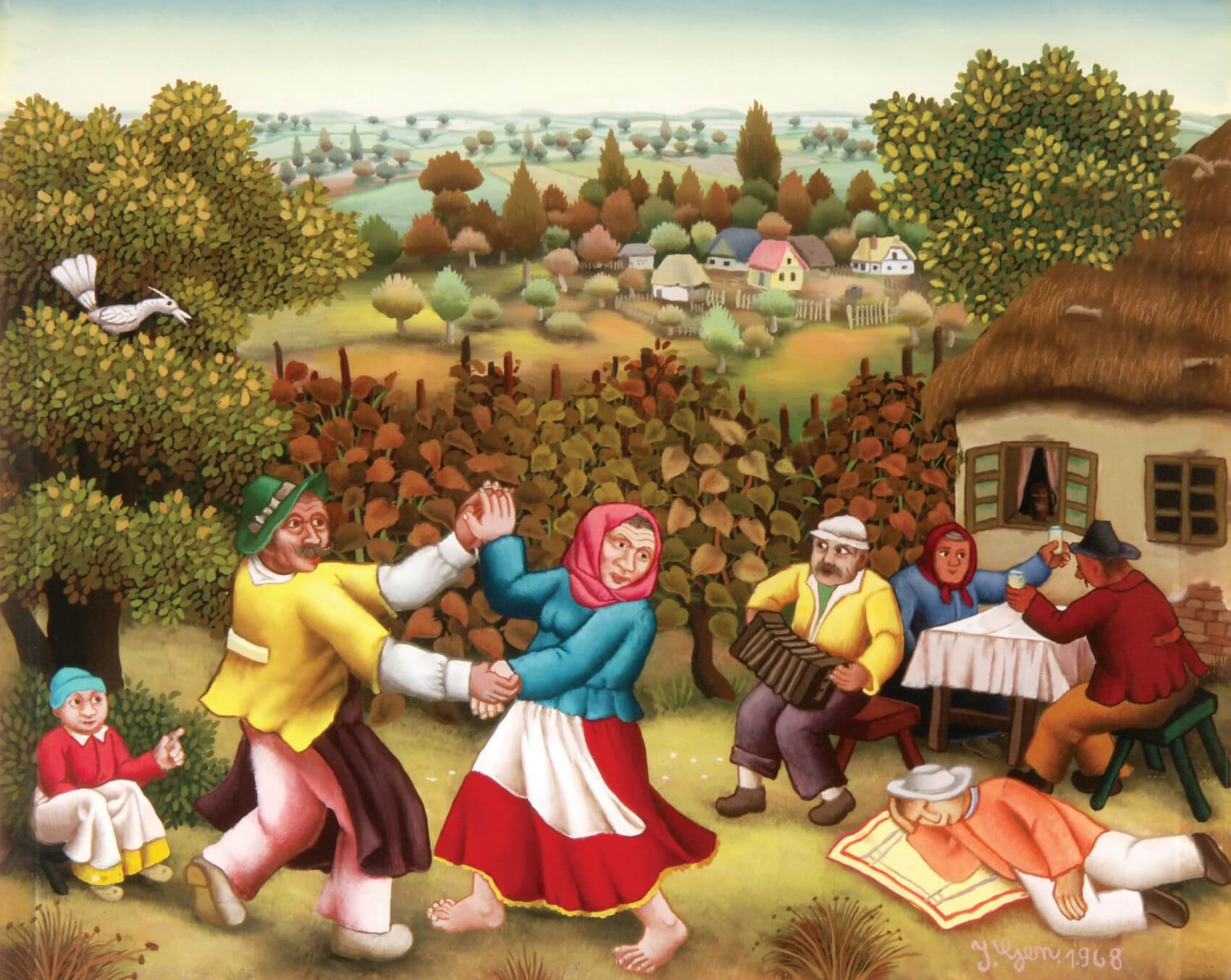 'Ples v goricaj' by Ivan Generalić, hanging at the Galerija naivne umjetnosti (Gallery of Naive Art), Hlebine © Koprivnica Town Museum
'Ples v goricaj' by Ivan Generalić, hanging at the Galerija naivne umjetnosti (Gallery of Naive Art), Hlebine © Koprivnica Town Museum
Key to identifying the Hlebine School in its First Generation is the subject matter. All three of these artists painted the world around them – their neighbours and peers, living everyday lives, in the villages, landscape and towns of today's Koprivnica-Križevci County. Certainly, Krsto Hegedušić helped inspire this subject matter, moulding the artists to suit the ethos of the Earth Group.
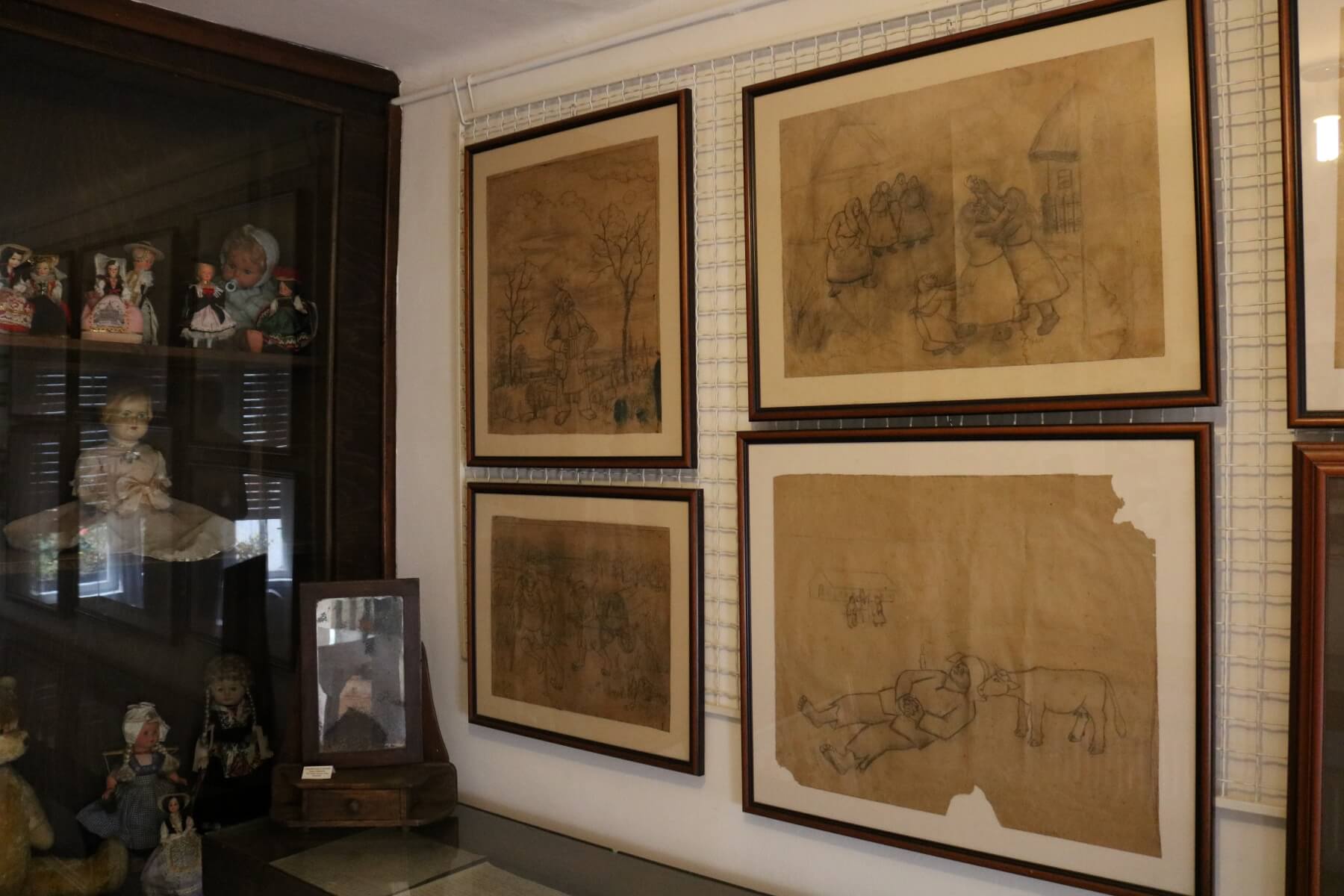
Ivan Generalić was just 16 years old when discovered by Krsto Hegedušić in 1930. The meeting would have a fast and long-lasting impact on Generalić. Ivan's humble early canvasses were the brown paper bags used in the business of a close relative. Yet, within a year of meeting Hegedušić, Ivan Generalić found his work being exhibited in Zagreb.
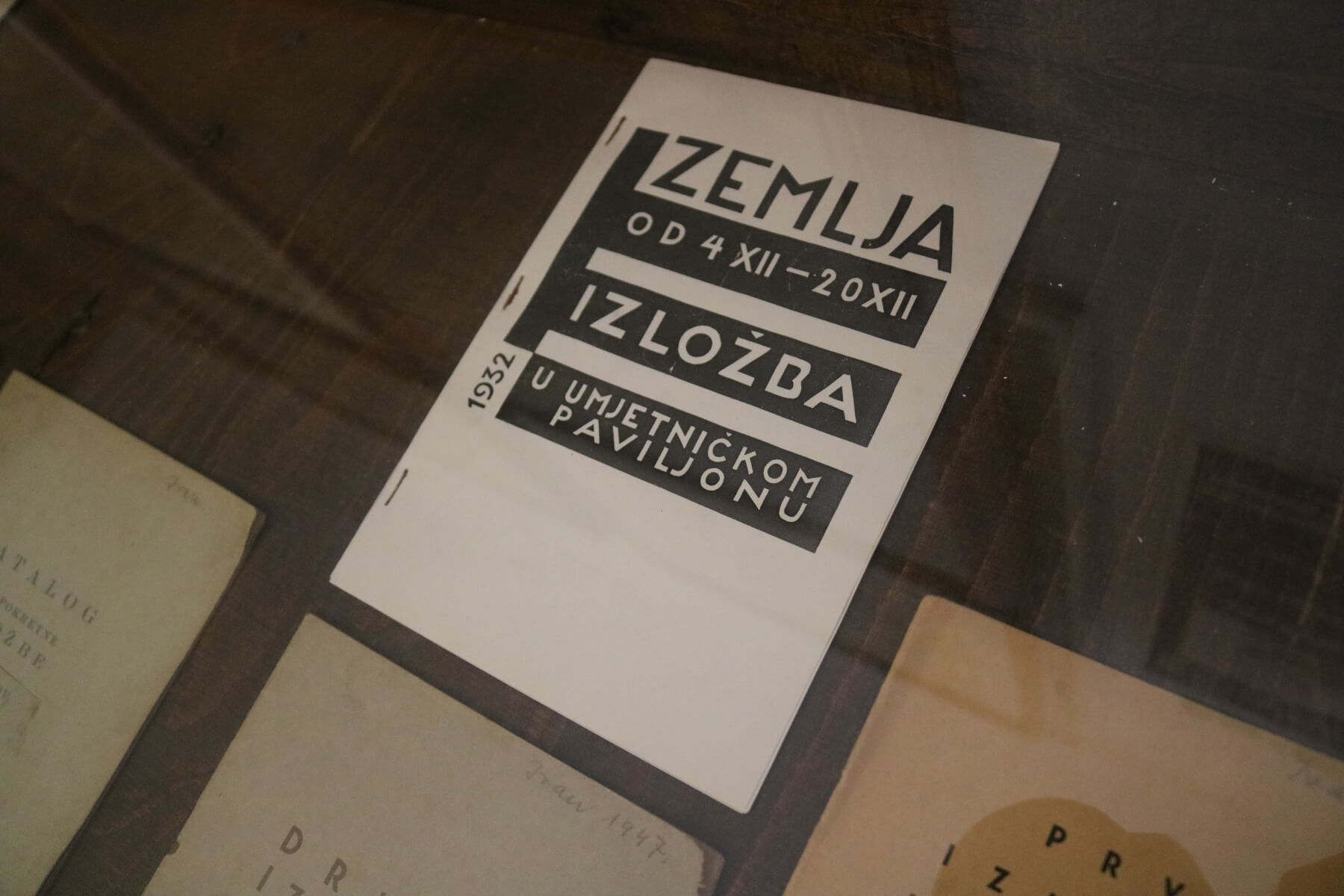
Hegedušić's shaping of the artists didn't obliterate their existing perspectives as much as it simply shifted them. For instance, Hegedušić's advice might have been "Instead of painting the church, why not paint people walking to the church in the snow?" or "Instead of marking the religious holiday by painting its origin story, why not show how you and your neighbours celebrate this holiday?"
Whether Hegedušić was conscious of doing it, or whether the artists were willfully lead, this guidance ultimately had the effect of politicising their work. In turn, this would lead the most authentic of all Croatian art into dangerous times when fascists took over the country. Proletarian in their themes, the Hlebine School and the Earth Group became viewed as Communist. The latter group was banned and Hegedušić arrested several times. During the Second World War, Mirko Virius was arrested, taken to a concentration camp in Zemun and executed. Ivan Generalić's painting of the sorrowful incident, 'The Death of Virius', is among his most famous. Franjo Mraz was also arrested during World War II but managed to escape.
 'Mask' by Ivan Generalić, hanging at the Galerija naivne umjetnosti (Gallery of Naive Art), Hlebine © Koprivnica Town Museum
'Mask' by Ivan Generalić, hanging at the Galerija naivne umjetnosti (Gallery of Naive Art), Hlebine © Koprivnica Town Museum
Aside from informing the subject matter of their work, Hegedušić also educated the painters in different techniques. One of these techniques – painting on glass – would become an enduring component of the Hlebine School and Croatian Naive Art.
Painting on glass
 'Eiffel Tower' by Ivan Generalić. The original hangs at Galerija naivne umjetnosti (Gallery of Naive Art), Hlebine © Koprivnica Town Museum
'Eiffel Tower' by Ivan Generalić. The original hangs at Galerija naivne umjetnosti (Gallery of Naive Art), Hlebine © Koprivnica Town Museum
Copying the style from imported religious art, when Hlebine School artists learned to paint on glass, it gave their efforts several distinct qualities. Firstly, if stored in the right conditions – away from damaging light – the glass protects the colours of the paint. As a result, much Hlebine School art is as brilliantly vivid today as the day it was first painted.
Secondly, this format makes the works heavy and fragile. Several masterpieces have been lost by falling to the floor and smashing.
Thirdly, painting on glass is time-consuming and challenging. Each painting must be thought out and planned in advance. The painter initially makes a sketch or preliminary painting as a guide. The image is then transferred to glass effectively in reverse. Details in the forefront of the painting must be applied first, with the background painted on top. Throughout the process, the artist will continuously check their progress on the opposite side of the glass.
Hlebine School Second Generation and onwards: Josip Generalić, Ivan Večenaj, Ivan Lacković, Mijo Kovačić, Franjo Filipović, Dragan Gaži
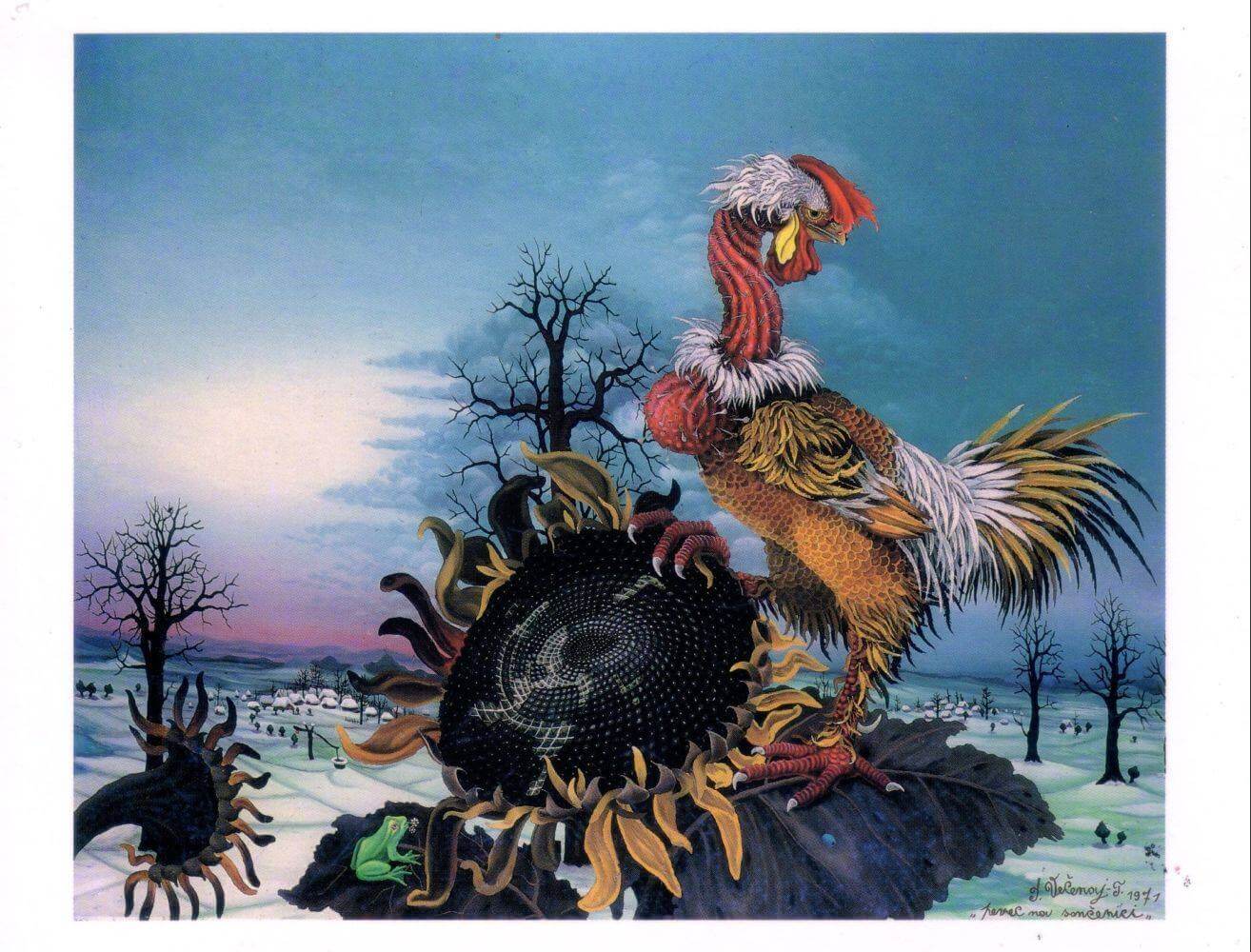 Rooster on Sunflower by Ivan Večenaj © Galerija Ivan Večenaj
Rooster on Sunflower by Ivan Večenaj © Galerija Ivan Večenaj
Perhaps to their surprise, the painters of Hlebine School first generation became a big hit. Exhibitions of their work were appreciated first in Zagreb. But, then the exhibitions began to tour across Yugoslavia and eventually the art capitals of the world. This attention would help inspire a new generation of artists from Hlebine and the surrounding area.
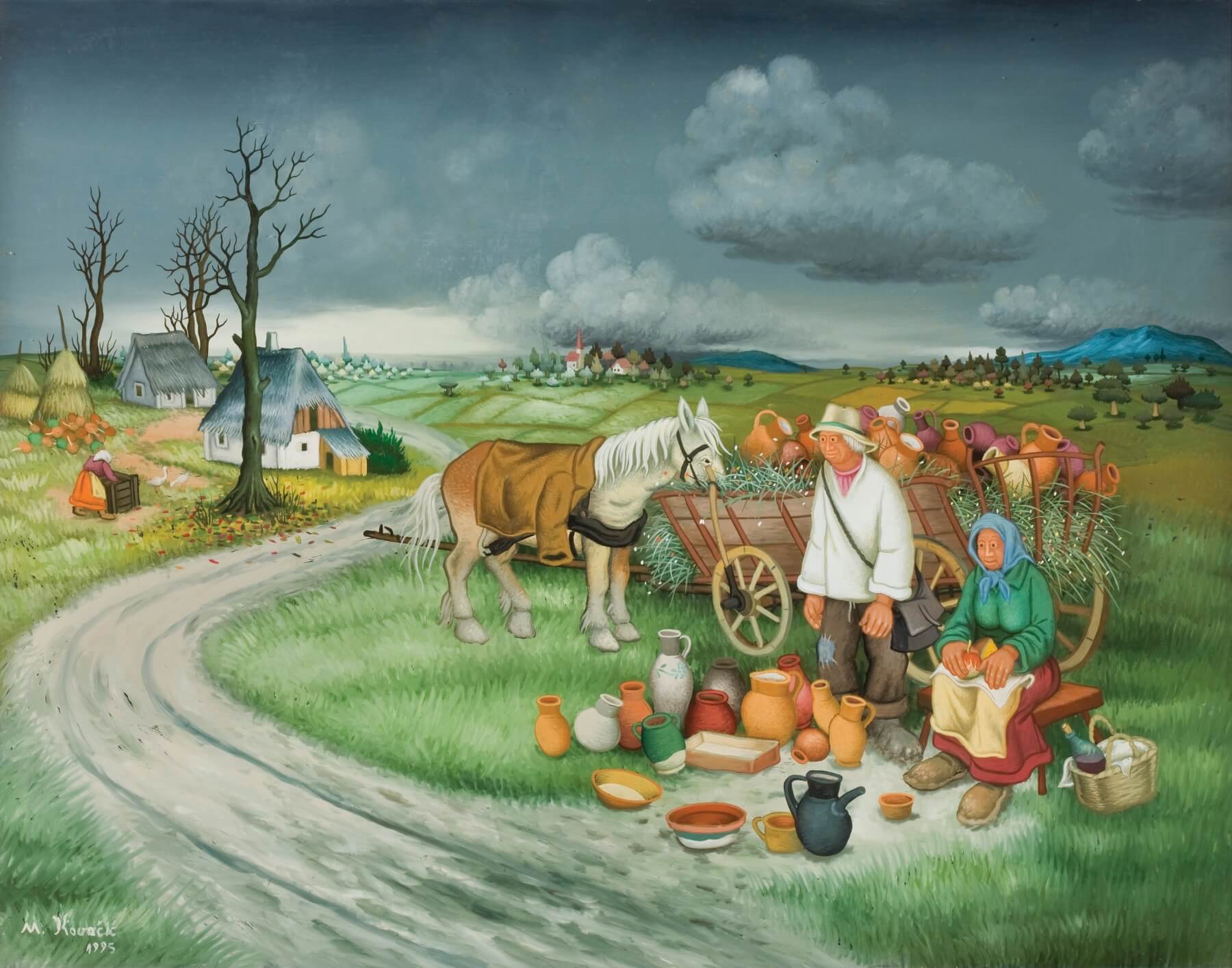 'Lončari' by Mijo Kovačić at Galerija Mijo Kovačić © Koprivnica Town Museum
'Lončari' by Mijo Kovačić at Galerija Mijo Kovačić © Koprivnica Town Museum
Success for the Hlebine School artists showed that Croatian art and self-expression were valid and valued even if unstudied. Thereafter, the tiny village of Hlebine would never look the same. More and more Naive Artists and folk artists were inspired to create. Still to this day, many continue.
While some Hlebine School artists carried on the tradition of painting on glass, others were inspired to sculpt in wood or, like Mirko Virius, paint on canvas. One of the key distinctions between later generations of the Hlebine School and the first is the subject matter.
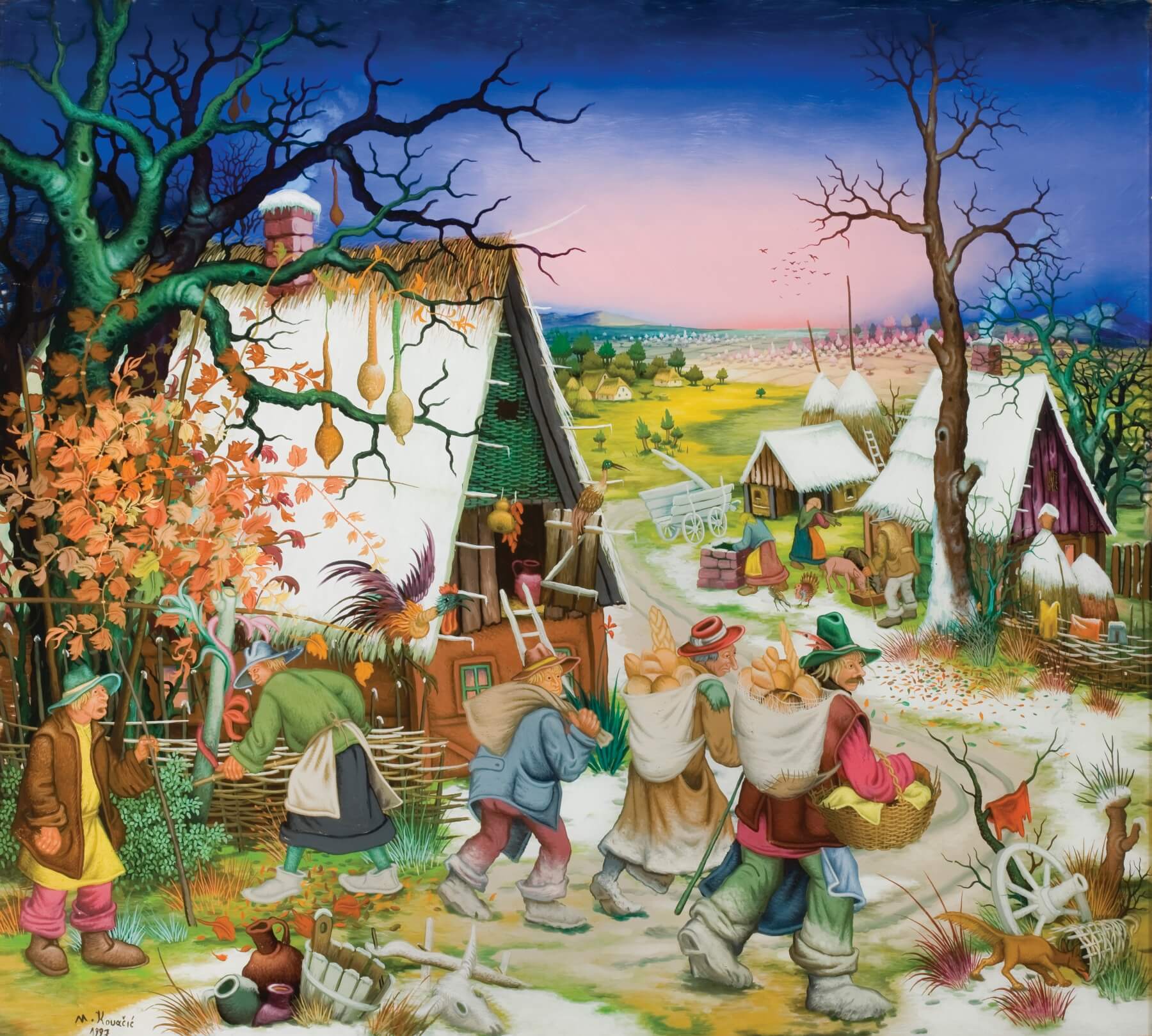 Podravina bread sellers in a picture hanging at Galerija Mijo Kovačić © Koprivnica Town Museum
Podravina bread sellers in a picture hanging at Galerija Mijo Kovačić © Koprivnica Town Museum
Second and then third generation Hlebine School artists were inspired to paint folklore, fantasy, from imagination, and with symbolic uses of vivid colur. This broadening of the style was partially the influence of Dimitrije Bašičević Mangelos, the first curator of the Gallery of Primitive Art in Zagreb (today Croatian Museum of Naïve Art). Subsequently, many of these later works would not fit within the paradigms of the Earth Group.
 'Žabe (Frogs)' by Ivan Večenaj © Galerija Ivan Večenaj
'Žabe (Frogs)' by Ivan Večenaj © Galerija Ivan Večenaj
For example, some of Ivan Večenaj's sacral paintings clearly come from the author's imagination and not his actual vision. Similarly, Josip Generalić, son of Ivan, travelled far beyond the limits of his home village in pursuit of his socio-political subject matter. Both artists were concerned with environmental issues on a global, not just a local level. Although, their work is still inextricably linked to their locale; Večenaj works the Podravina rooster emblem into many of his paintings and even depicts Christ within a Podravina landscape. So too does Josip Generalić when he paints The Beatles and others from the 60s counterculture movement.
On the Trail of the Hlebine School in Podravina & Prigorje, Home of the Treasures of Croatian Naive Art
 Locals return from mushroom picking in autumnal Podravina in a picture hanging at Galerija Mijo Kovačić © Koprivnica Town Museum
Locals return from mushroom picking in autumnal Podravina in a picture hanging at Galerija Mijo Kovačić © Koprivnica Town Museum
Some Croatian Naive Art is held in private and public collections across the world. Some of it finds a home in the National Museum of Naive Art in Zagreb. However, the vast majority of treasures from the Hlebine School of Croatian Naive Art remain in Podravina & Prigorje. The national Museum of Naive Art in Zagreb is currently closed as it undergoes the lengthy process of changing address. As a result, the following addresses in Koprivnica-Križevci County are currently the best places to see the most authentically Croatian of all the country's art.
Also, because the landscape of Hlebine, Koprivnica and wider Podravina appears in so much Hlebine School art, you genuinely need to come here to view both together. You'll get a much better understanding and appreciation of this art when you see it in its natural surroundings.
Galerija Mijo Kovačić, Koprivnica Town Museum, Koprivnica
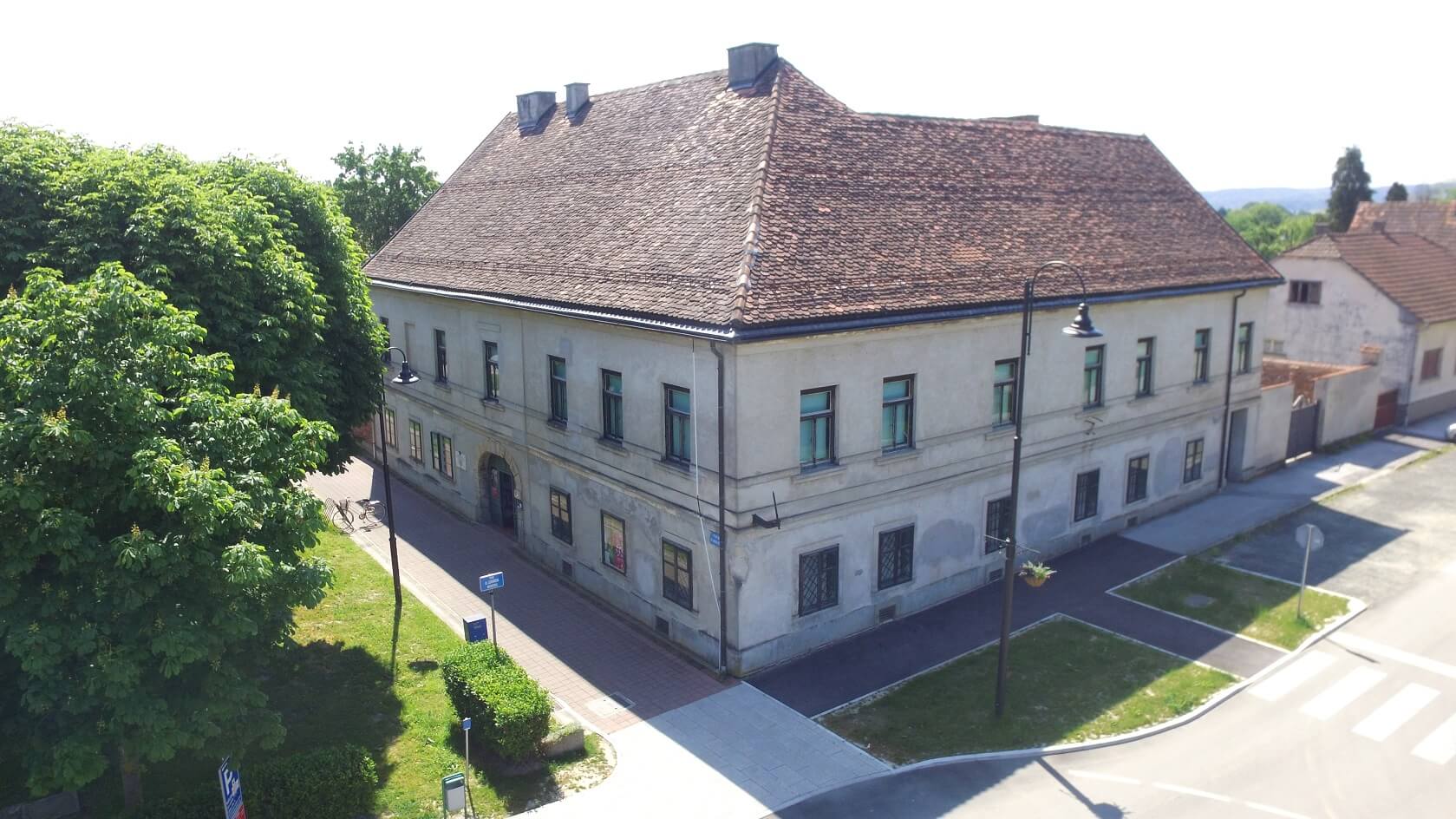 Koprivnica Town Museum © Koprivnica Town Museum
Koprivnica Town Museum © Koprivnica Town Museum
Born 5 August 1935 in Gornja Šuma, Molve, Podravina, Mijo Kovačić is one of the last remaining Croatian Naive Artists of the Hlebine School's second generation. He still paints today, albeit not quite as prolifically as in the past. He has produced such a body of work that not only can you find him exhibited in Croatian Museum of Naïve Art in Zagreb, but also in dedicated Mijo Kovačić galleries in Zagreb and Koprivnica. The one is run by Koprivnica Town Museum, which you can see above. Find out more about the gallery here.
 'Portrait' hanging at Galerija Mijo Kovačić © Koprivnica Town Museum
'Portrait' hanging at Galerija Mijo Kovačić © Koprivnica Town Museum
Galerija naivne umjetnosti (Gallery of Naive Art), Hlebine
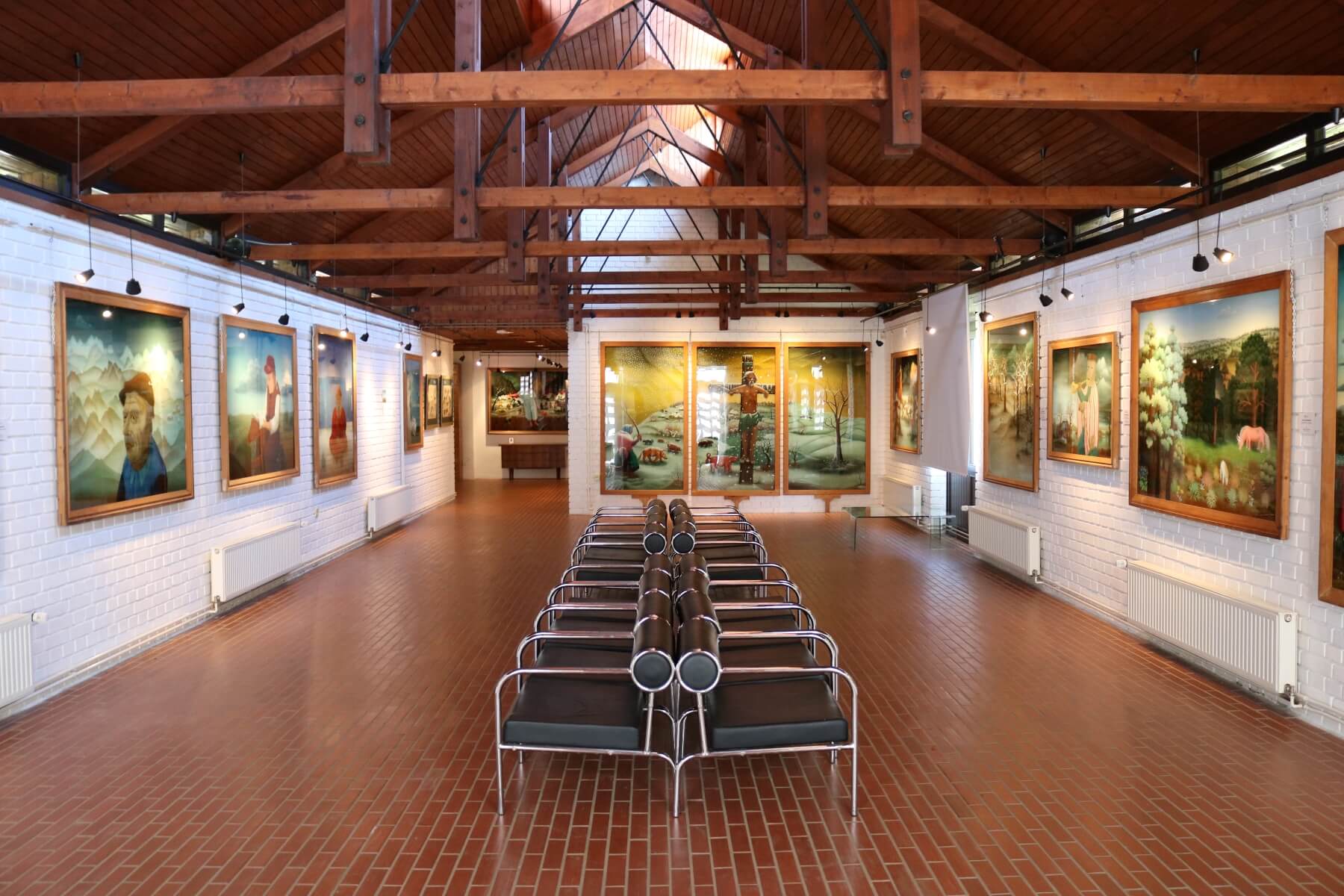
Founded in 1968, the Gallery of Naive Art in Hlebine is one of the top two most important galleries for Naïve Art in Croatia, the other being the Croatian Museum of Naïve Art in Zagreb. But, unlike their Zagreb counterpart, this gallery concentrates specifically on the Hlebine School and locally produced art. A crowd of sculpted wooden figures greets you on the front lawn. Inside, beneath the wooden beams of a beautiful building designed specifically for this purpose, some of the best artists and paintings of the Hlebine School.
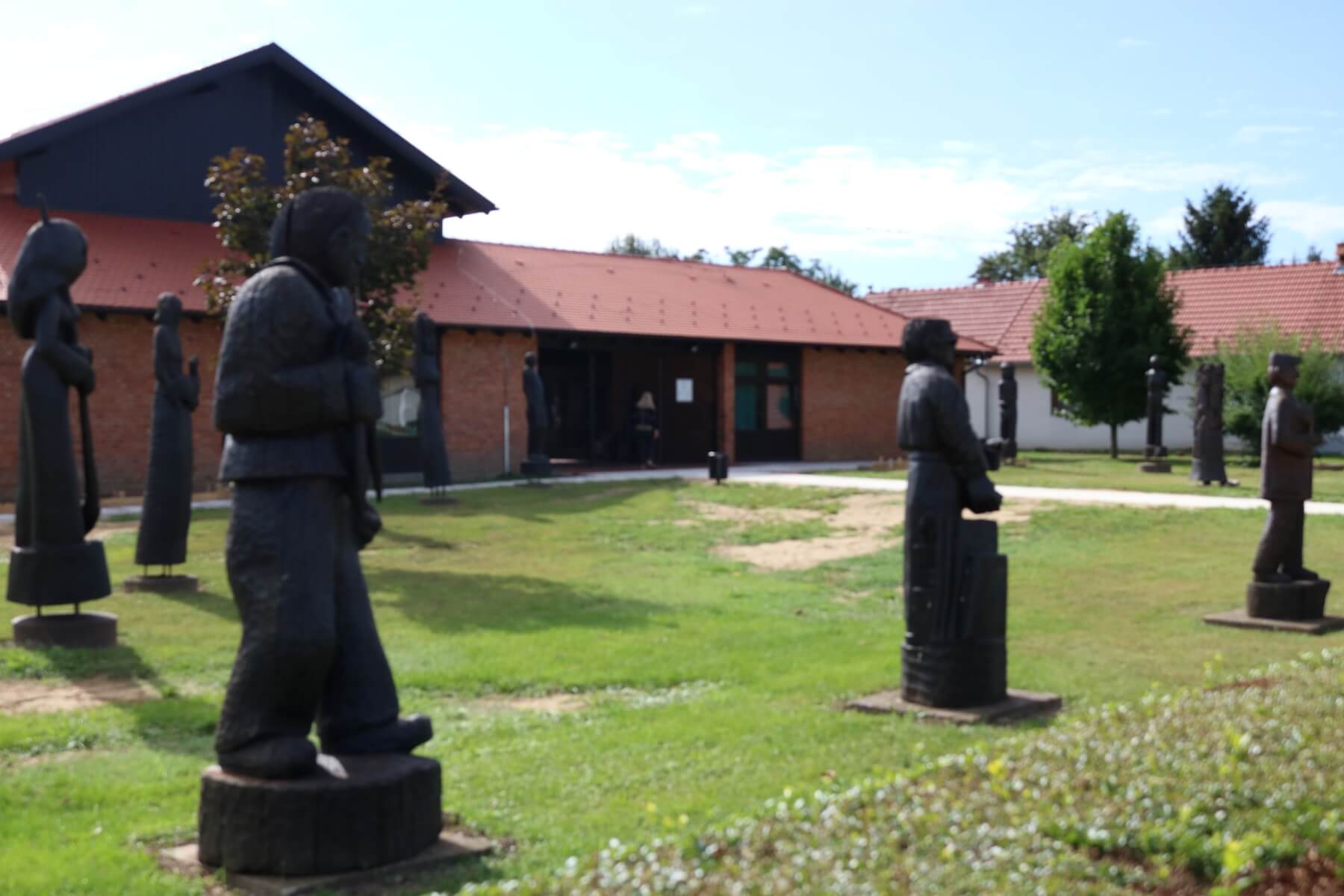
In the mid-1980s, when he was the most famous of all Croatian Naive Artists, neighbour Ivan Generalić paid the gallery a visit. He offered to pay for an extension to the gallery, on condition that it be used to house a permanent exhibition of his work. It was a win-win for the museum and Ivan Generalić subsequently donated some of his true masterpieces for the collection.
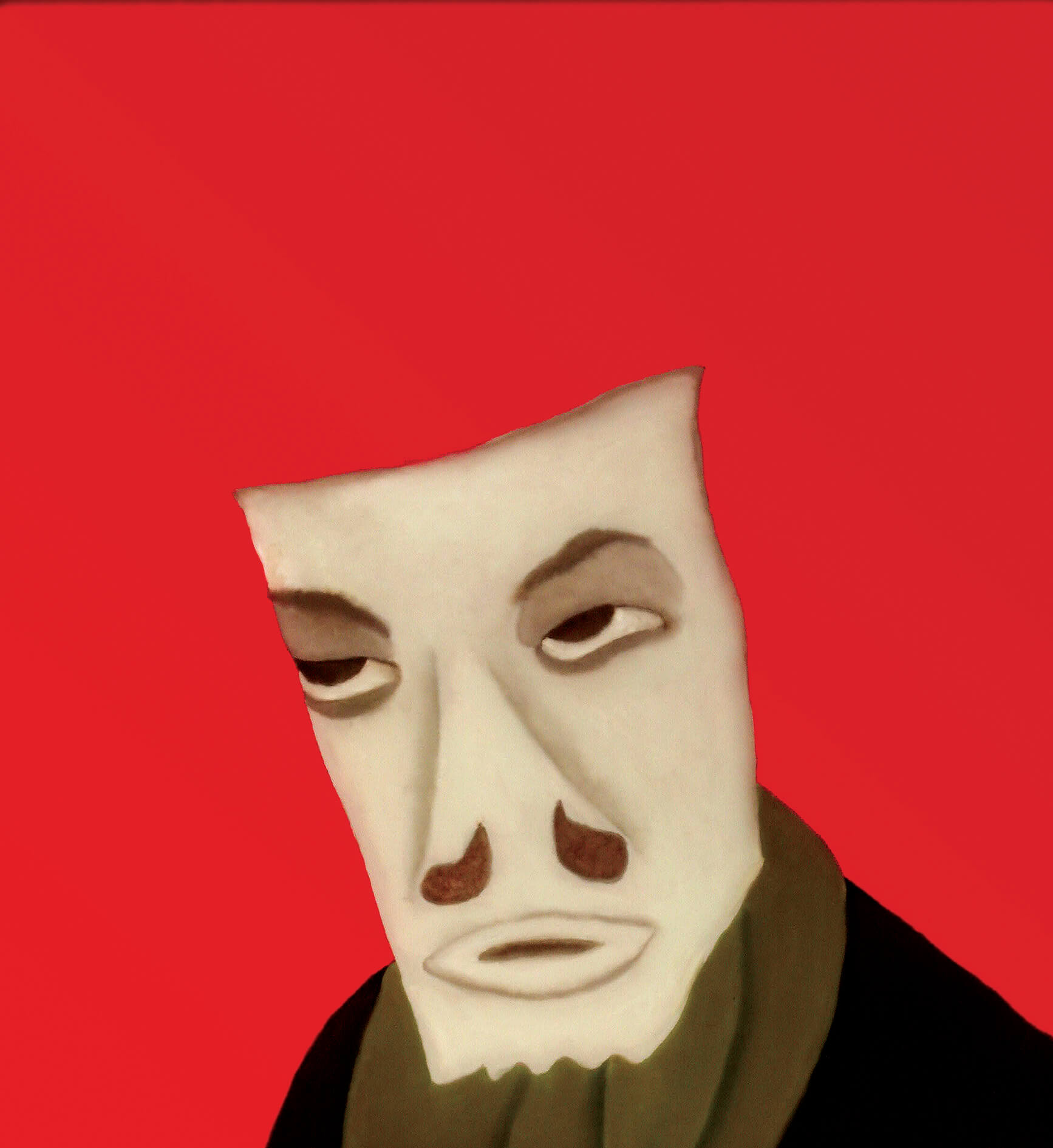
The newer part of the gallery is so true to the original design that, unless informed, you'd never guess it was built later. You'll find works by every key member of the Hlebine School here, including Ivan Generalić, Franjo Mraz and Mirko Virius, Josip Generalić, Ivan Večenaj, Ivan Lacković, Mijo Kovačić, Franjo Filipović and Dragan Gaži. Today, the museum is run by Koprivnica Town Museum. Find out more about the gallery here.
Galerija Josip Generalić, Hlebine
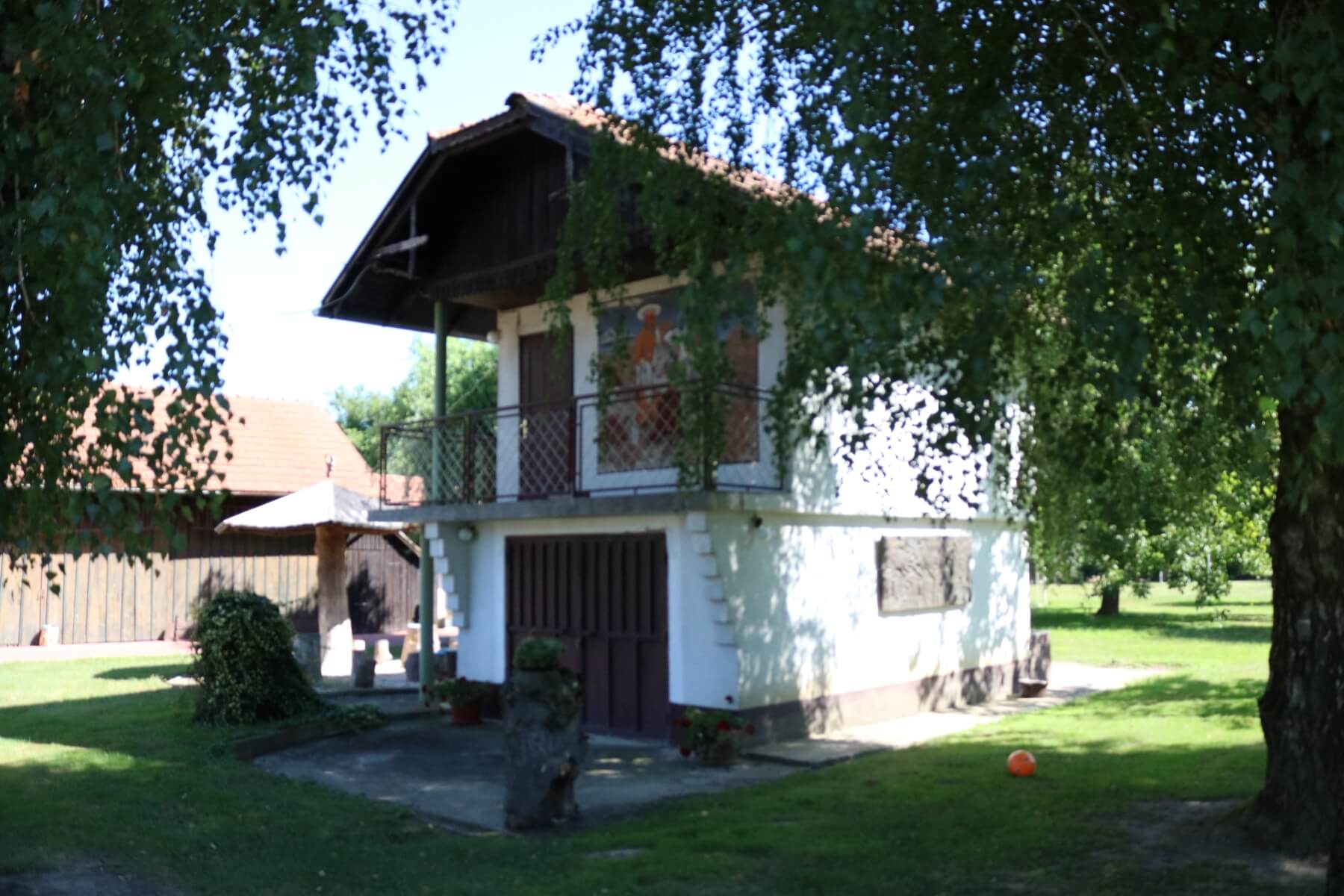
“How long have you got?” asks Ivan Generalić, grandson of Josip Generalić, great-grandson of Ivan Generalić, as he greets you at the Galerija Josip Generalić, Hlebine. He's asking if there's time for the1 hour tour or 6-hour tour. We think he's joking. He's not.
Generalić family have lived here for at least five generations. Having two of the Hlebine School's most famous and most successful painters within their ranks has allowed them to expand their property portfolio. It's just as well, because there's a lot to see here. What was once the simple, semi-agricultural farmstead where Ivan's great grandfather was born is now a sprawling family estate that houses an ethno-museum and considerable gallery spaces filled with incredible exhibits. All of the original furniture from how his great grandfather lived is preserved, displayed as it was, only in an adjoining property the family now own. Alongside the history and many works of Ivan Generalić and Josip Generalić, folk art, sculpture and artisan furniture made by incredible craftsmen from across the Balkans, who the painters once traded with.
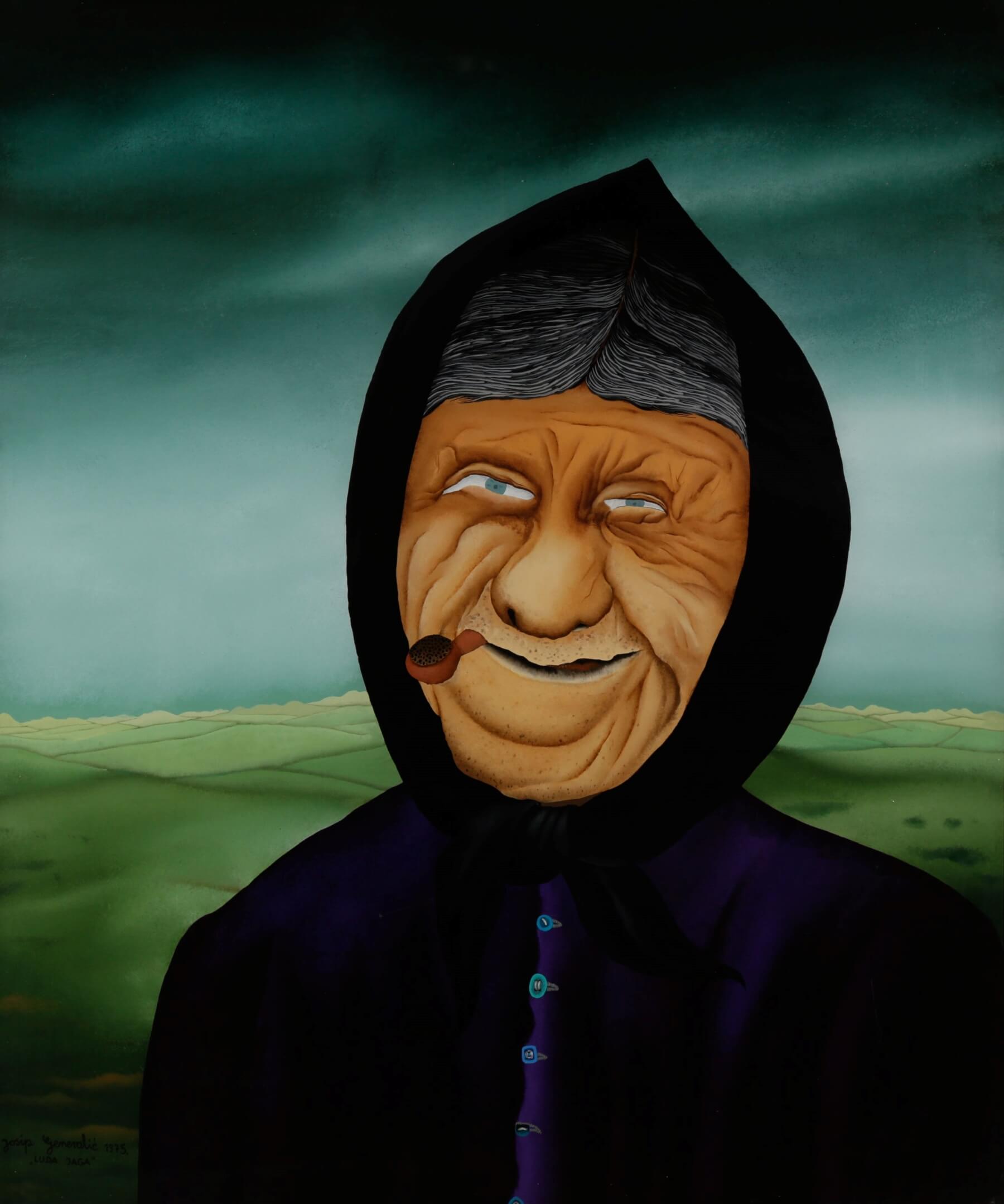 Luda Jaga by Josip Generalić, hanging at the Galerija naivne umjetnosti (Gallery of Naive Art), Hlebine © Koprivnica Town Museum
Luda Jaga by Josip Generalić, hanging at the Galerija naivne umjetnosti (Gallery of Naive Art), Hlebine © Koprivnica Town Museum
If you already like this kind of art, you might have to pinch yourself more than once that you're being shown around by someone called Ivan Generalić. Ivan himself is not only knowledgeable but extremely engaging - there are several big laughs on the tour. Ivan points out one image of an unloved neighbour, who grandfather Josip sent to the moon. He provides him with a Podravina cow so at least he can survive. Perhaps feeling slightly guilty, in the next room, Josip has painted the neighbour's return to earth. Although, he lands nearby in the famously barren Đurđevac desert (sometimes known as the Croatian Sahara). That's quite a lot of time and paint spent on someone you don't like!
Ivan's great grandfather also had a sense of humour. Having grown tired of friends bragging about their holidays in summer houses on the Croatian coast (which he did not like), at the height of his fame he decided to build his own. He invited several friends to accompany him on his holiday. And proceeded to take them to his own back garden, just metres from his main residence, where he had built the summer house. Genuinely, you'll wish you had time for the 6-hour tour. Find out more about the gallery here.
Galerija Ivan Večenaj, Gola
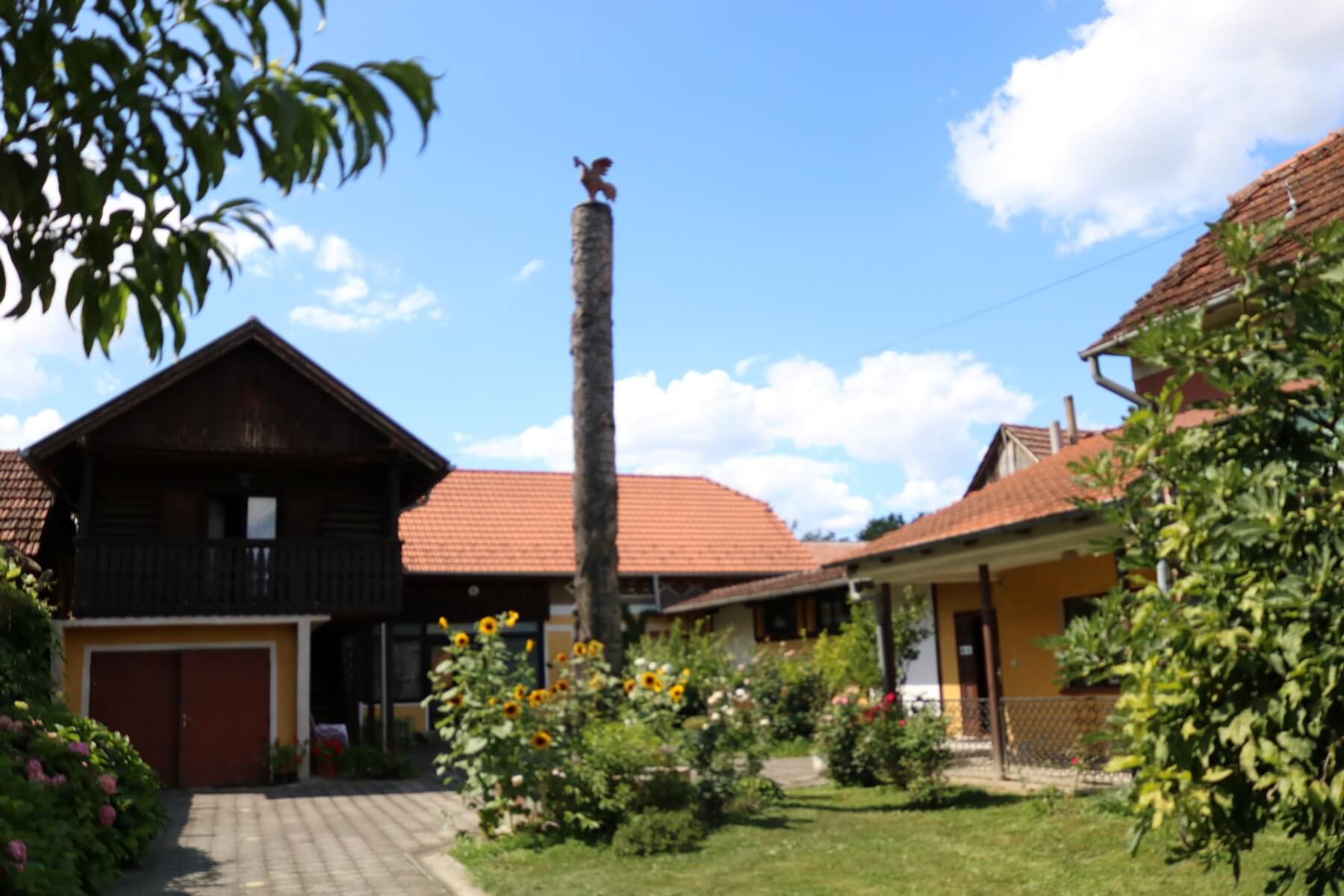
Some of the work by artists from the first and second generation of the Hlebine School are scattered far and wide. But, with the canon of Ivan Večenaj, it's a different story. Truly breathtaking examples of his finest work – definitely among the very best – were reserved by the artist for his family collection. Included in the collection, most of his key sacral works, including Golgotha, a triptych of the life of Jesus, crucifixion and the Four Horsemen of the Apocalypse. Don't worry, it's not all doom and gloom. Beautiful and bright images of Podravina roosters, agriculture and a charming portrait of his wife hang alongside. You can view them all at Večenaj's former home, now Galerija Ivan Večenaj in Gola. Across the road, an ethnic museum preserves life how it once was here. A truly unmissable highlight on the trail of Croatian Naive Art. Find out more about the gallery here.
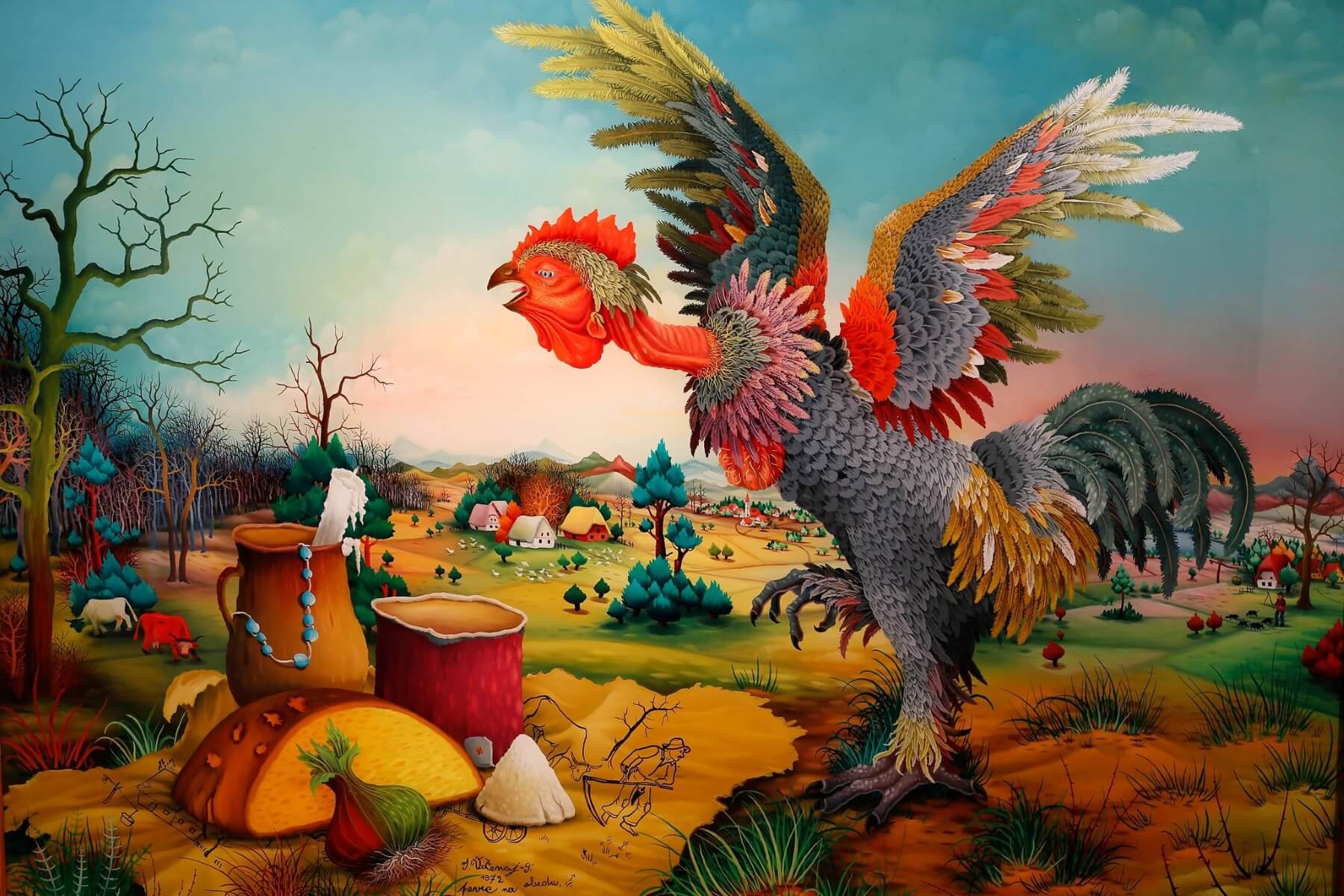 'Pevec na obedu' © Galerija Ivan Večenaj
'Pevec na obedu' © Galerija Ivan Večenaj
Galerija Ivan Lacković, Batinske
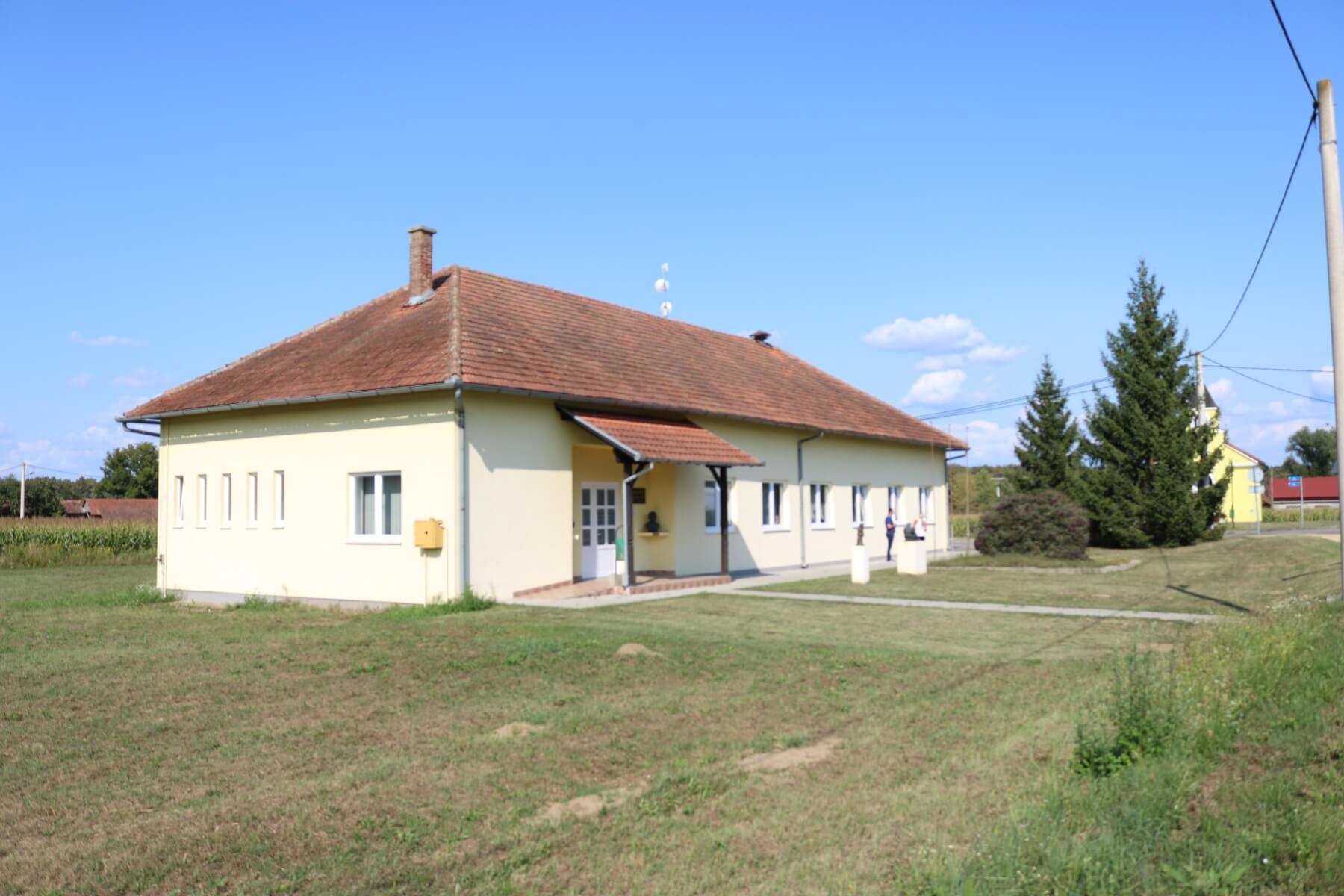
Clearly something of a local patriot, Ivan Lacković donated some 300 works to the village of his birth. Within the collection, you'll find not only works by Lacković himself but also sculptures by Naive Artists Ljubica Marulec and the painter's brother, M. Lacković. Find out more about the gallery here.

Podravina Motifs (Podravski motivi)
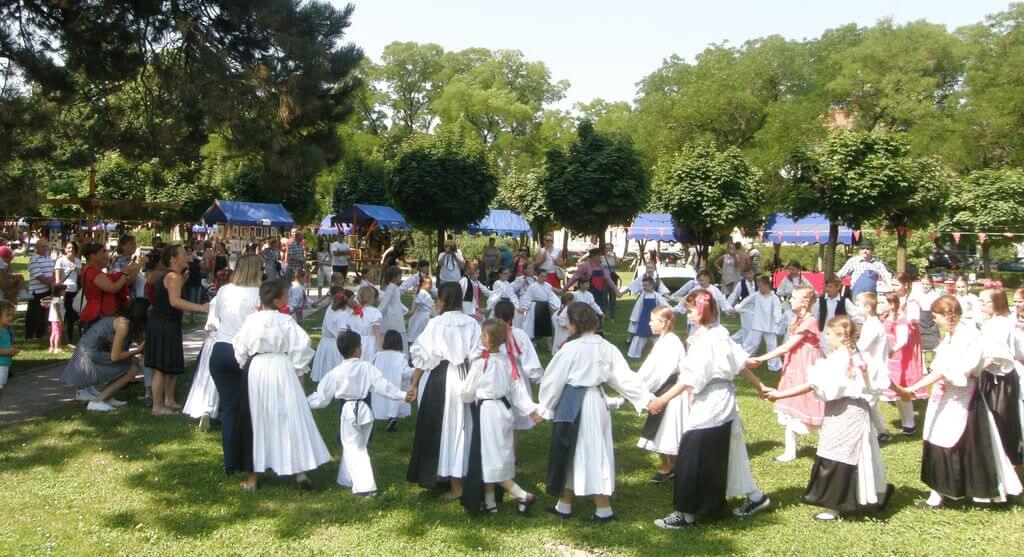 Podravina Motifs (Podravski motivi). Photo © Grad Koprivnica
Podravina Motifs (Podravski motivi). Photo © Grad Koprivnica
A three-decade-old Koprivnica event that showcases all of the cuisine, culture, music, dance, costume and art of Podravina. Naive Art is a key and central theme to the event. Usually, there are over 50 contemporary Naive Artists from the region exhibited, with their work on sale. Taking place each summer, it's a great place to get to know traditional Podravina and to pick up some amazing gifts. Find out more about the event here.
Šetnja kroz naivu u Hlebinama (Walk Through The Naive of Hlebine)
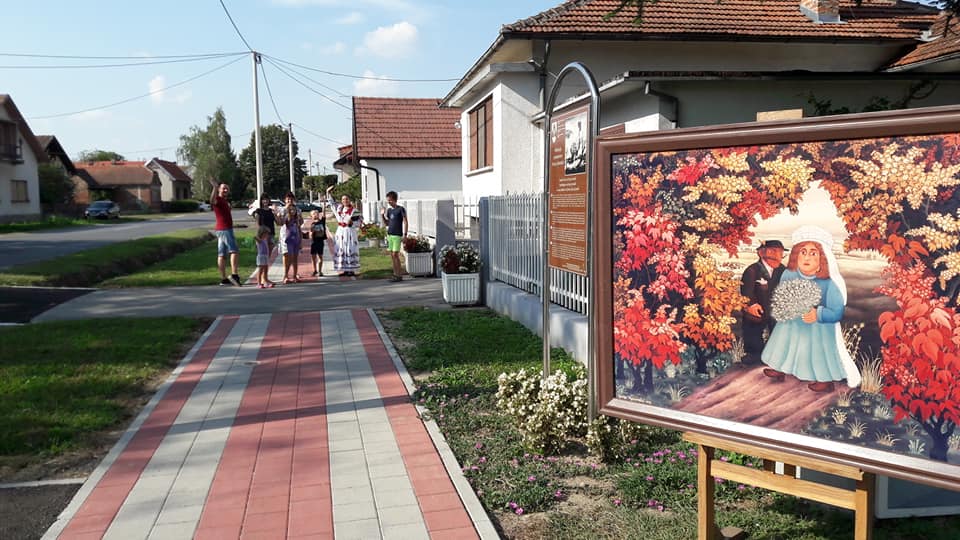 Outside Galerija Josip Generalić during Šetnja kroz naivu u Hlebinama © Tourist Board Central Podravina
Outside Galerija Josip Generalić during Šetnja kroz naivu u Hlebinama © Tourist Board Central Podravina
An annual open-air gallery of Hlebine Naive Art taking place on the streets of the village itself. Organised by Tihomir Želimorski who has the rural accommodation offer Stari zanati in Hlebine, Šetnja kroz naivu u Hlebinama differs from Podravina Motifs because it focusses exclusively on art – painting and sculpture. The houses in Hlebine are treasure troves of Croatian Naive Art. During this summertime event, all village residents bring their paintings and statues out onto the streets, hang them on trees or in gardens. You're invited to walk around the delightful village to look. Find out more about the event here.
This article was produced with the kind help of Koprivnica-Križevci County Tourist Board and checked for accuracy by Koprivnica Town Museum.
If you want to find out the latest from Podravina, be sure to check TCN pages here.
Three Continental Croatian Cities Cooperate in Name of EU Funding
August the 25th, 2021 - Numerous continental Croatian cities are hoping to get their hands on European Union (EU) Funds. Koprivnica, Cakovec and Varazdin are all on the hunt for EU cash injections following their recent decision on cooperation.
As Poslovni Dnevnik/Ana Blaskovic writes, this year's Spancirfest not only turned the historic core of Varazdin into a festival stage once again, but also opened the door to cooperation between three continental Croatian cities: Varazdin, Koprivnica and Cakovec, all of which agreed on a joint application for individual European Union projects.
"We've agreed on the models of our future joint cooperation in applying for some EU projects and funds, where each of us is too small to be able to apply on our own,'' said Varazdin Mayor Neven Bosilj, who hosted Cakovec Mayor Ljerka Cividini and their colleague Misel Jaksic from Koprivnica on Monday.
According to Bosilj, these three continental Croatian cities are among the top six in the entire country in terms of employment and are the (probably rather unexpected) drivers of economic activities.
At the same time, these three continental Croatian host the largest traditional events in the country, such as the aforementioned Spancirfest which is held annually in beautiful Varazdin, whose edition this year has been being visited by about 20,000 people a day, Porcijunkulov in Cakovec, and the Koprivnica Renaissance Festival, all of which attract crowds year after year.
"Tourism doesn't solely exist down by the coast. These are the three most important tourist events not only in this part of the country, but in the whole of continental Croatia,'' said Bosilj.
Cividini stressed that they must not miss out on grabbing the opportunity for cooperation on projects that are opening up through the ITU mechanism and other European Union funds.
"Cooperation will take place through the economy, tourism, cultural development. Today, we've shown that we have the will and that we want to do this, and there are a lot of projects," she said.
"I think this is a good trigger for our agricultural production, traditional crafts, cultural development and everything that makes life what it is up here in the north," Jaksic said.
For more on Croatian access to EU funding, follow our dedicated politics section.
Pandemic Still Poses Threat as Terme Sveti Martin Wins Prestigious EU Label
July the 21st, 2021 - Terme Sveti Martin recently won a prestigious European Union (EU) label, which is sure to position it even higher on the popularity scale. That being said, coronavirus remains a very real threat to business operations.
As Ana Blaskovic/Poslovni Dnevnik writes, the popular Terme Sveti Martin has become the first Croatian hotel to boast the European eco-label EU Ecolabel as awarded by the Ministry of Economy and Sustainable Development to products and services to encourage innovation for climate neutrality by 2050.
It was handed over to the director of Terme Sveti Martin, Igor Nekic, on Monday by the Minister of Tourism and Sport, Nikolina Brnjac.
"Market research at the global and European level has clearly shown that tourists are no longer looking for things in terms of mass alone, but sustainable and environmentally conscious tourist destinations that will provide them with authentic experiences tailored to individuals. Today, tourists at the European level are mostly looking for active holidays and services provided by health tourism,'' said Nikolina Brnjac.
In order to get their hands on this prestigious EU label, the Ecolabel, Terme Sveti Martin had to meet as many as 22 stringent criteria, from energy efficiency to rational water consumption. Croatia's much talked about national recovery and resilience programme envisions a shift towards ''green'' tourism and the concept of thermal rivieras in the continental part of Croatia, for which it has always been somewhat well known.
"I believe that through the planned investments by the end of 2025, by which time the planned investments must be completed, we will achieve the goal of Terme Sveti Martin becoming the first among many Croatian hotels to bear the EU Ecolabel label, and Medjimurje as one of the first thermal rivieras in continental Croatia,'' said the Minister of Tourism and Sport.
For Croatian tourism, offering a lot to as many guests as possible is currently the very last item on the list of; with the pandemic still an enormous threat and the entire Adriatic coast recently in orange on the ECDC list, the main question is whether last year's sudden end of the season will be repeated and whether it can be prevented at all.
For more, follow our travel section.
OPG Čudesna šuma: Paradise Reimagined in Beautiful, Traditional Baranja
May 13, 2021 – OPG Čudesna šuma: How an unexpected turn of events helped world-renowned photographer Mario Romulić realise his lifelong dream.
War and genocide and the aftermath. Famine. Disease. Death. In a former life, harrowing images filled the lens of internationally renowned photographer Mario Romulić. But thankfully, we're now far from such scenes.
In fact, at OPG Čudesna šuma - Mario Romulić's home and family farm - we're pretty much far from everything. One other eco-farm is his only neighbour. Well, unless you count the llamas the Romulić family keep out back. Occasionally, through the rich green of surrounding trees, you see birds flying above the branches. Probably they're toing and froing from Kopački rit. The nearby Nature Park is less than a kilometre from OPG Čudesna šuma. Famously, the wetlands are home to over 250 species of birds. They are also the reason why Mario Romulić is here.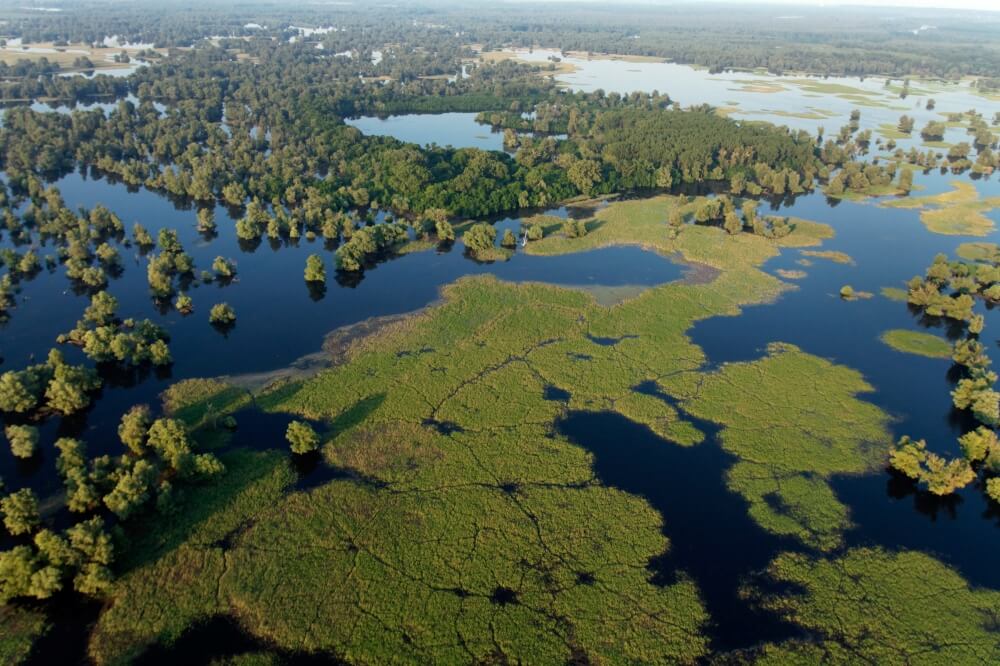 Kopački rit Nature Park © Kopački rit Nature Park.
Kopački rit Nature Park © Kopački rit Nature Park.
“Back then, I was very occupied with Kopački rit,” remembers Mario of the time, 21 years ago, when he moved to what is now OPG Čudesna šuma. “I was working as a cameraman for people like Reuters, all over the world. The assignments would last 7-10 days and I'd be in places like Afghanistan, Rwanda, Congo, Liberia, Bosnia. It was often quite dangerous. For the next 20 days, I would spend a lot of time in Kopački rit, trying to calm my nerves. It was something like a cure after seeing all these horrible scenes. Eventually, instead of travelling every day from my home in Osijek to Kopački rit, I decided to try and find something close by. And this is what I found.”
Just as this beautiful, natural landscape in Bilje, Baranja once served as a peaceful getaway for Mario Romulić, his OPG Čudesna šuma today does the same for others. Because, after dreaming for two decades of turning this blissful plot and homestead into a forest farm and eco-village, Mario Romulić is finally turning that vision into a reality.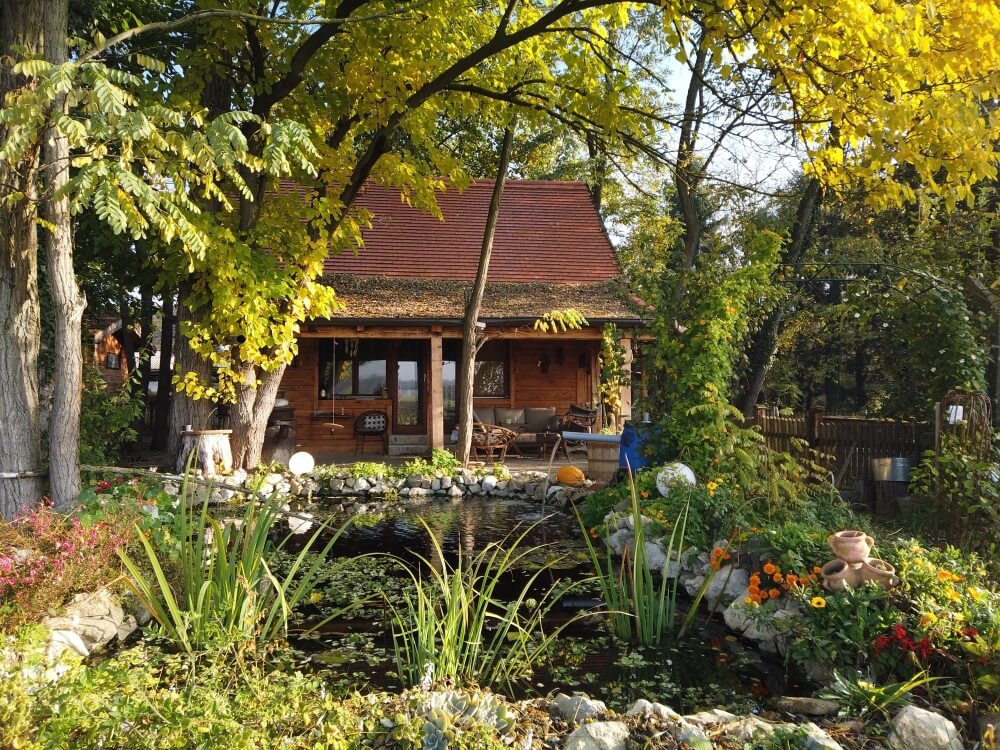 The impossibly pretty OPG Čudesna near Kopački rit Nature Park, Bilje Municipality, Baranja © OPG Čudesna šuma.
The impossibly pretty OPG Čudesna near Kopački rit Nature Park, Bilje Municipality, Baranja © OPG Čudesna šuma.
“Because of my job - first, travelling all around the world, then travelling Croatia - I did not even have much time to think about it, let alone do it,” says Mario. “But, then Corona came. Finally, I found myself at home. At last, I had time to work on my dream.”
OPG Čudesna šuma in the Month of Baranja Cooking (Mjesec baranjske kuhinje)
A group of 30 or so are Mario's guests today at OPG Čudesna šuma. They're here for a presentation of speciality cooking. It's the grand finale of the Month of Baranja Cooking (Mjesec baranjske kuhinje).
Over previous weeks, OPGs from all across the region have welcomed guests to try goulash, soups, stews, perklet and other traditional foods of the area. While visiting, they've been embraced by the beautiful landscape of Baranja. Not only have they discovered how this delightful, distinct cuisine tastes, but also they've learned exactly how it's prepared. However, they've evidently saved the best for last. On the menu today, river fish inventively cooked, accompanied by a riotous rainbow of seasonal vegetables. Seasonal vegetables of Baranja in springtime at the Month of Baranja Cooking (Mjesec baranjske kuhinje) © OPG Čudesna šuma.
Seasonal vegetables of Baranja in springtime at the Month of Baranja Cooking (Mjesec baranjske kuhinje) © OPG Čudesna šuma.
It's a beautifully sunny day, right at the start of May. It depends on your preference, but looking across this happy vista in the glorious sunshine, it's difficult to imagine this not being the perfect time to be in Baranja. Young children are raised to chest height by their parents so they can meet Mario's free-roaming llamas face-to-face. The children's faces flit between surprise, curiosity and delight. The llamas return their stare. They're used to welcoming new guests. Meeting the Romulić family llamas at OPG Čudesna šuma © Turistička zajednica Općine Bilje - Kopački rit.
Meeting the Romulić family llamas at OPG Čudesna šuma © Turistička zajednica Općine Bilje - Kopački rit.
Partially shaded by trees, the smiling adult guests sit casually on wooden benches around a central, outdoor cooking area. Several open fires display a range of traditional cooking methods. Steam rises from a cast-iron stove suspended over one. Beneath the vapours, you can make out the dish is fish paprikash. It's unmistakable because of the deeply red coloured bubbles, a result of generous amounts of paprika.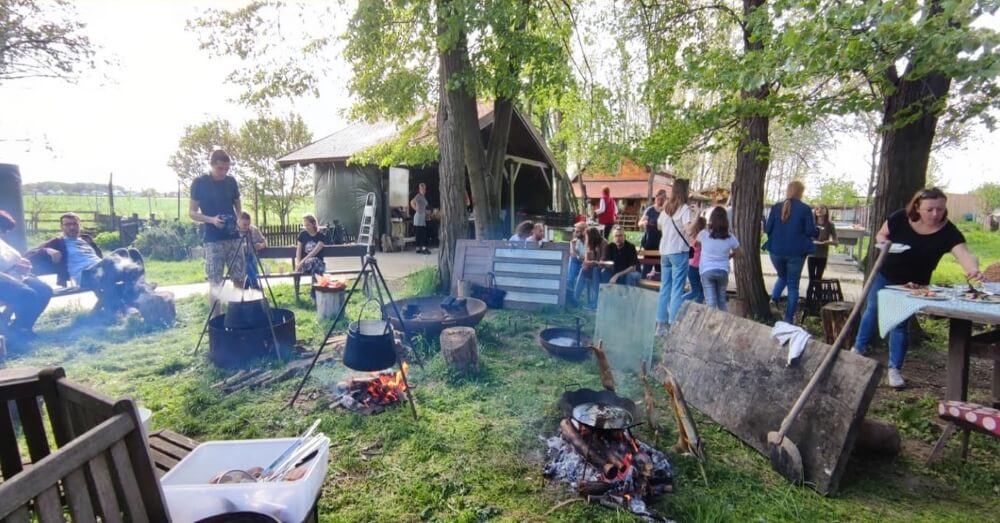 Guests enjoy a warm springtime day at OPG Čudesna šuma during the Month of Baranja Cooking (Mjesec baranjske kuhinje), as fish paprikas cooks over an open fire © OPG Čudesna šuma.
Guests enjoy a warm springtime day at OPG Čudesna šuma during the Month of Baranja Cooking (Mjesec baranjske kuhinje), as fish paprikas cooks over an open fire © OPG Čudesna šuma.
A huge bag of this paprika sits propped up, close by. It's from another organic OPG, just a kilometre or so from here. The colour is vivid, impossibly red, unrecognisable from anything store-bought. At the next fire, pike impaled on wooden sticks are placed far enough from the flickering flames so they cook slowly and do not burn.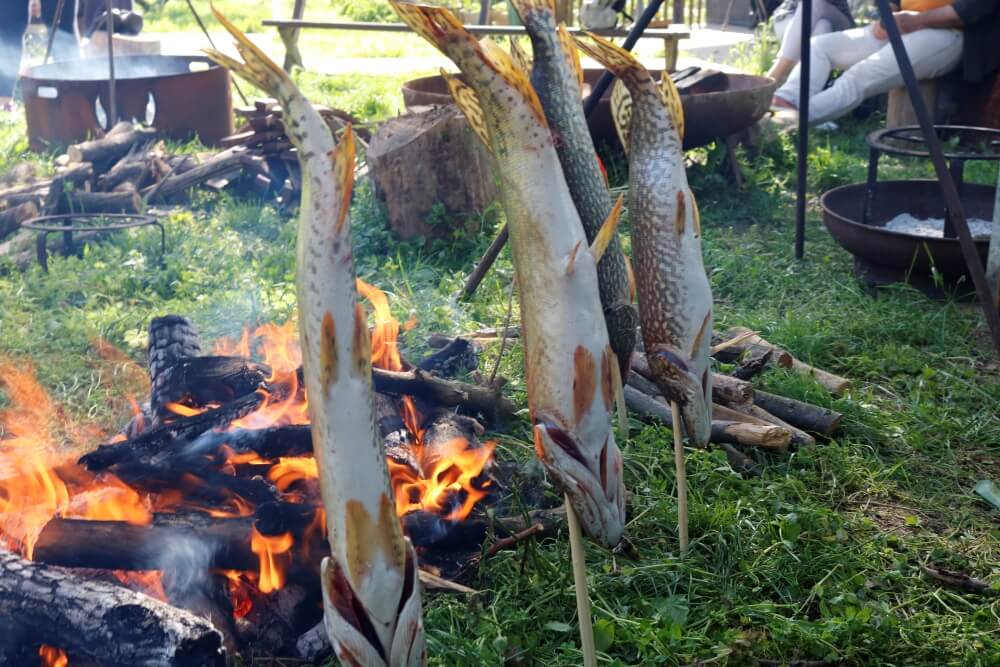 Pike impaled on sticks, cooking by an open fire at OPG Čudesna šuma @ Marc Rowlands.
Pike impaled on sticks, cooking by an open fire at OPG Čudesna šuma @ Marc Rowlands.
In the outdoor kitchen, Mario Romulić's co-chefs prepare an unending supply of fish dishes and vegetables. Carp, catfish, trout, bream. There's a bounty of fresh asparagus. It's that time of year. With the restraint of experience, they've cooked it perfectly. After the crunch of the bite, the flavour explodes. They're seasoned simply – delicious olive oil and sea salt.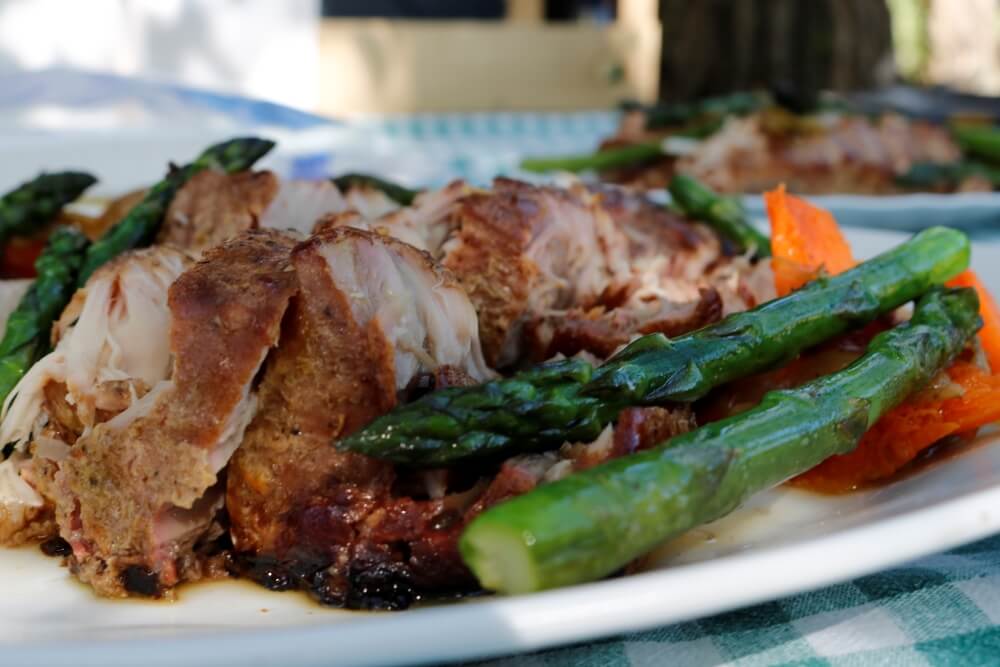 Seasonal asparagus, perfectly cooked, served with smoked river fish © Marc Rowlands.
Seasonal asparagus, perfectly cooked, served with smoked river fish © Marc Rowlands.
A group of peers – accomplished chefs from Osijek-Baranja restaurants – peak over the shoulders of Romulić's co-chefs. They're admiring the inventive techniques employed. Although, being chefs, they can't help themselves. They end up briefly forgetting their families in order to help out.
Mario Romulić, the host with the most
 Mario Romulić © Turistička zajednica Općine Bilje - Kopački rit.
Mario Romulić © Turistička zajednica Općine Bilje - Kopački rit.
After all the guests arrive, Mario Romulić holds court. Cheerily he welcomes us all to OPG Čudesna šuma and the event. Without question, the success of rural, village tourism depends on the personalities of the hosts. It's no good plonking a group of visitors in a pretty place and throwing some food in front of them. We've all seen trees, grass and food before. Rural tourism is not just about the place, it's about the experience, the ambience. And, especially, it's about the people.
Hands down, the OPGs of Slavonia and Baranja are the best in Croatia at this. The folks here are famous for their friendliness, warm welcome and big personalities. And, Mario Romulić has one of the biggest of them all.
In the research for this reportage, looking back at archive pictures of Mario Romulić is startling. During his years spent as an international photographer, he himself has been photographed many times – on assignment in distant countries, at the opening of exhibitions that have showcased his celebrated work. In most, there's an intensity to his stare. It's sometimes difficult to look at. He looks like a man who has tales you never want to hear, like a man who has seen too much.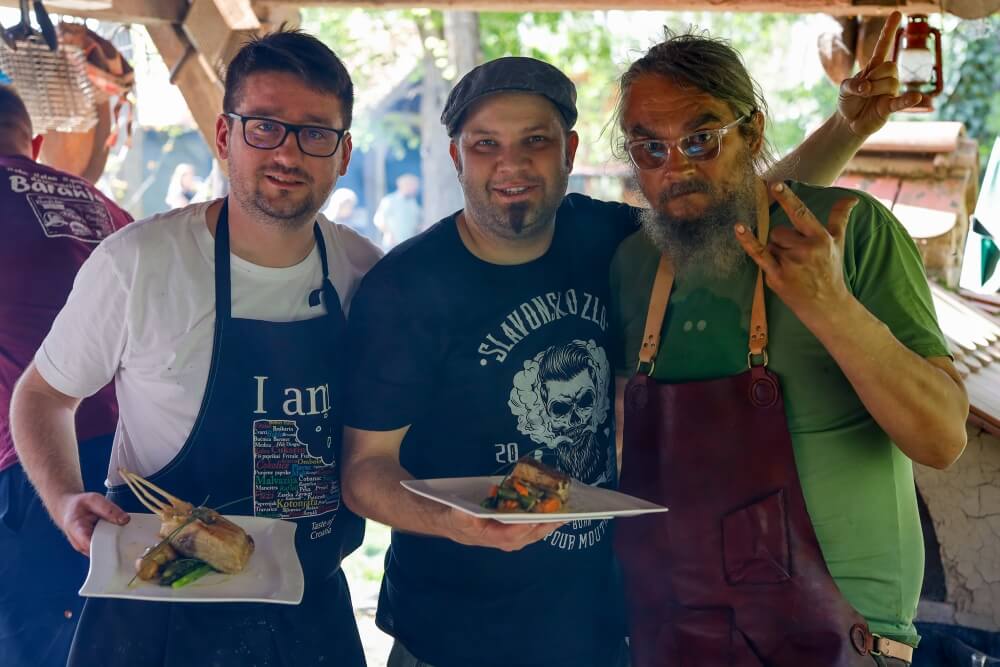 (L- R) OPG Čudesna šuma co-chef at the event Mihael Tomić, renowned Osijek chef Ivan Đukić currently of Osijek's Lipov Hlad and a happy Mario Romulić © Turistička zajednica Općine Bilje - Kopački rit.
(L- R) OPG Čudesna šuma co-chef at the event Mihael Tomić, renowned Osijek chef Ivan Đukić currently of Osijek's Lipov Hlad and a happy Mario Romulić © Turistička zajednica Općine Bilje - Kopački rit.
By comparison, the Mario Romulić that welcomes us at OPG Čudesna šuma today is unrecognisable. Sure, there's a little more grey to his long hair and beard but, otherwise, he looks incredibly healthy and happy. The intense stare is gone, replaced by a warm, wide smile that shows across his entire face. Even in early May, he has a darkened skin tone, the telltale signs of a man who spends much of the day outdoors. Romulić's enthusiasm for his guests and the event is palpable. After his sincere welcome, this enthusiasm is immediately transferred to each of his guests.
Mrs Romulić ensures everyone's glass is overflowing with wine or juice. One of Mario's teenage sons helps out with the food, while the other is taking photographs of the event. Well, someone has to do the photography now that dad wants to be a chef and host! Mario himself is engulfed in smoke. Among the other duties he's assumed today, Mario is tending a smoker. Without a doubt, this is the most revelatory cooking method we meet today.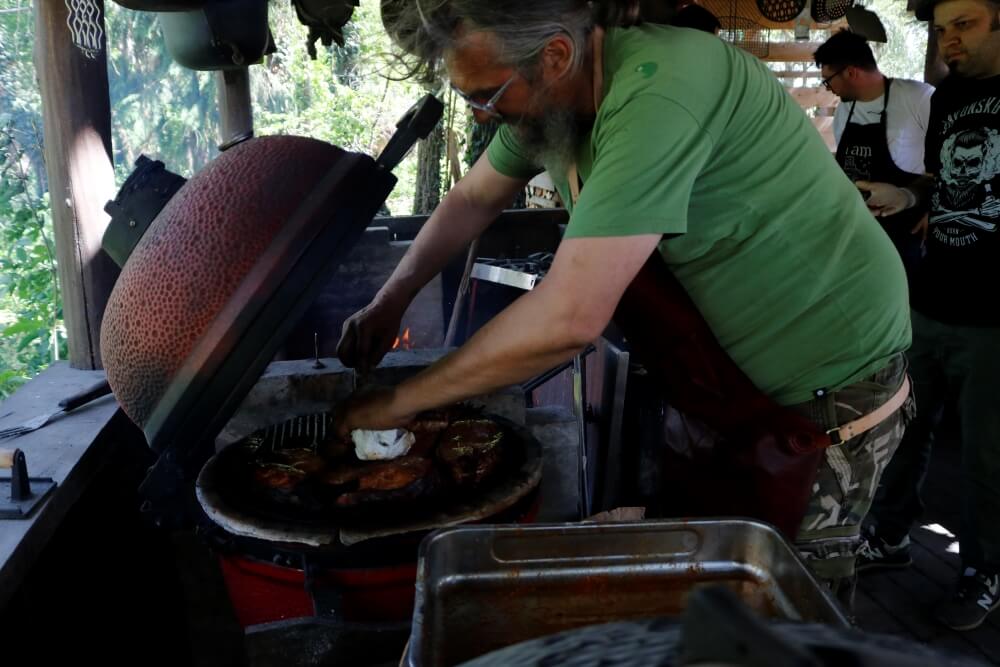 Mario Romulić tends to smoked river fish, a revelatory gastronomic experience at OPG Čudesna šuma © Marc Rowlands.
Mario Romulić tends to smoked river fish, a revelatory gastronomic experience at OPG Čudesna šuma © Marc Rowlands.
Smoked fish of Slavonia and Baranja at OPG Čudesna šuma
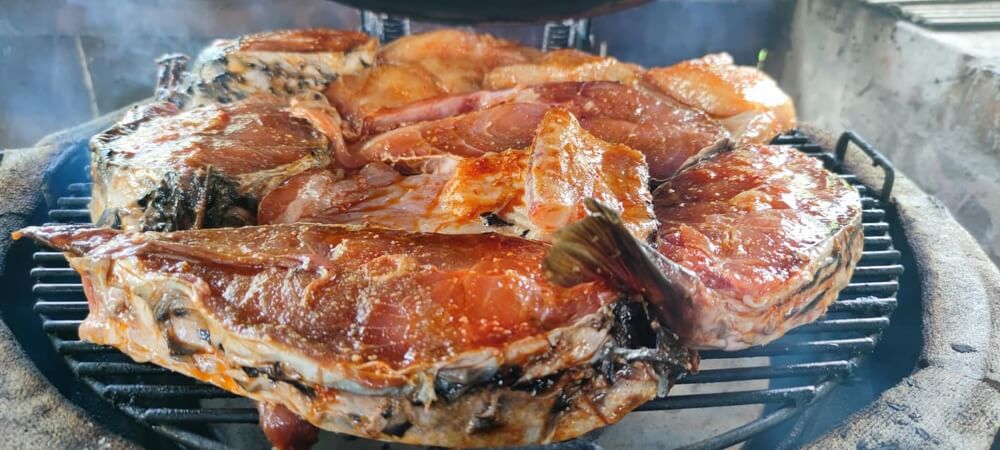 An American-style smoker, loaded with river fish. TOP TIP: A great way to stop fish sticking to the grill of your barbecue or smoker is to place them on top of a layer of lemon slices © OPG Čudesna šuma.
An American-style smoker, loaded with river fish. TOP TIP: A great way to stop fish sticking to the grill of your barbecue or smoker is to place them on top of a layer of lemon slices © OPG Čudesna šuma.
“We do have smoked fish here, but not in this way,” he says. “This is more like an American grill. I never heard of anyone trying Baranja cooking like this. Actually, I never heard of anyone nearby who has a smoker like this. The first time I tried stuka (pike) in the smoker, that was unbelievable. It's incomparable, really special.” Exquisite presentation of river fish by the enthusiastic team of OPG Čudesna šuma © Turistička zajednica Općine Bilje - Kopački rit.
Exquisite presentation of river fish by the enthusiastic team of OPG Čudesna šuma © Turistička zajednica Općine Bilje - Kopački rit.
“In Slavonia and Baranja, there are just a few ways we usually cook our river fish - carp on sticks, fish paprikash, perklet and fried fish. So, we tried something new, to expand the palette. For instance, almost nobody eats Babuška (a type of carp). They feed it instead to their pigs. It costs 5 kuna a kilo! But, if you cook it in this completely natural way, it's delicious.”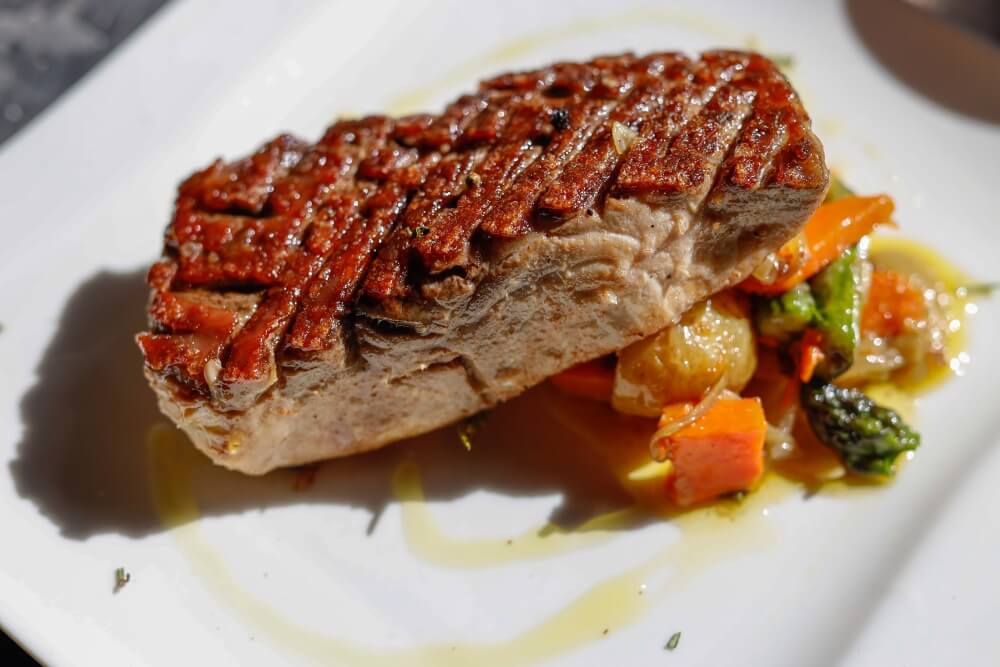 More river fish, cooked by the team of OPG Čudesna šuma © Turistička zajednica Općine Bilje - Kopački rit.
More river fish, cooked by the team of OPG Čudesna šuma © Turistička zajednica Općine Bilje - Kopački rit.
He's not wrong. Today's mountain of different smoked fish is the talk on most of the adult lips. The rich flavours surprise. Compliments and returns for second helpings ensue. Mario stands to one side, happily watching as his smoked fish secret escapes. In the future, he plans similar events based on other regional foods - Black Slavonian pig, wild meats like deer or boar. Eventually, in the seven hectares of land he owns here, he would like to expand OPG Čudesna šuma as an eco-village, with beds for visitors, a natural swimming pool and then surround it with a food forest. Big plans. It looks as though the camera may stay more permanently in the hands of his son. Because it's difficult to imagine Mario Romulić leaving his happy place and the realisation of his long-held dream. Mario Romulić in his happy place, with a friend © OPG Čudesna šuma.
Mario Romulić in his happy place, with a friend © OPG Čudesna šuma.
Both the author and Total Croatia News would like to thank the following for their invaluable help in creating this article: Ivana Jurić and the Tourist Board of Osijek-Baranja County, OPG Čudesna šuma, Mario Romulić and family, Renata Forjan and Turistička zajednica Općine Bilje - Kopački rit and Domagoj Butković of expert travel guides to Slavonia and Baranja, Kulen travel.
Zagreb County Horse Riding Trail Covering Nearly 100 Kilometres Presented
April the 27th, 2021 - Zagreb County horse riding is a perfect way to see some of the beautiful rolling green hills and other areas of the countryside in the City of Zagreb's vicinity, and a brand new almost 100 kilometre trail for precisely that has been presented.
As Poslovni Dnevnik/Darko Bicak writes, strengthening continental and rural Croatian tourism through 85 kilometres of trails for experienced horse riders, as well as for for beginners is part of a plan that will enrich the tourist offer of Zagreb County.
The beautiful nature located a mere stone's throw from the capital will now be able to be enjoyed by keen and experienced horse riders and all those who want to escape from the hustle and bustle of city life, as was explained the mayor of Orle, Ervin Vujica, who emphasised the fact that the Zagreb County horse riding opportunities are very close to the heart of the capital and that the municipality of Orle is now set to become the first in this part of Croatia with marked trails of this type.
On Sunday, May the 2nd, 2021, the grand opening of the first and longest trail (23 kilometres) will be held, realised in cooperation with the Miklin Equestrian Centre, which has existed and been in operation for about 30 years now.
“Our equestrian centre has been gathering lovers of these noble animals for many years and it provides them with the experience of riding in almost untouched nature. We're looking forward to embarking on this new project in cooperation with the Municipality. When creating the Zagreb County horse riding trails, we rode more than 203 kilometres and chose 85 kilometres of different trails, each of which carries a special experience, some are intended for experienced riders and some are for beginners, and the natural environment is diverse,'' explained the owner of the Equestrian Centre, Ivan Miklin.
Vujica explained that the focus of the Zagreb County horse riding trails lies primarily on rural development, which means in the near future, the opening of accommodation facilities for all visitors and providing the highest quality gastronomic offer from local family farms will take place.
He also added that this is one in a series of development projects in the municipality of Orle to contribute to the tourist offer of the entire county. One of the initiators of the project, Zeljko Matejcic, pointed out that these Zagreb County horse riding trails located in the municipality of Orle will attract horse lovers from all over Croatia, as well as from the rest of Europe.
For more, make sure to follow our travel page. For all you need to know about Zagreb in 2021, bookmark Zagreb in a Page.
Beautiful Osijek to be Transformed into Tourist Magnet with 18 Million Kuna
January the 21st, 2021 - Osijek, one of Croatia's eastern cities, doesn't often find itself on the typical tourist map. Continental Croatia is still very much being discovered, with even Zagreb being relatively new on there when compared to the Adriatic coast and its wild popularity. Eastern Croatia is even more neglected, in almost every sense. Is all that about to change for beautiful Osijek?
As Poslovni Dnevnik/Marija Crnjak writes, the City of Osijek is investing a massive 18 million kuna into the renovation and refurbishment of a neglected historic space into a regional reception info-tourist centre in central Osijek. The facilities it is set to boast will promote the tourist attractions of Osijek, Osijek-Baranja County and the wider region of eastern Croatia in general.
The project is co-financed from European Union funds in the amount of 85 percent, and includes the reconstruction of an old Austro-Hungarian stable covering 40 thousand square metres, the construction of more roads and car parks, as well as a lot of landscaping.
“The group of contractors involved, the companies Kale and Binder, were all introduced into the works two weeks ago, and the deadline for completion of works is June 2022.
Through this project, we anticipate the creation of new jobs in beautiful Osijek, an increase in the number of visits to the city's tourist attractions and a number of new programmes for the development of cultural and natural heritage in regional destinations,'' said the Deputy Mayor of Osijek, Zana Gamos.
According to Kornelija Mlinarevic, head of the Administrative Department for European Union Programmes, a stop for buses and cars will be arranged next to the centre itself, and since it is located near the state road and two EuroVelo routes, part of the offer will be adapted to cyclists.
"After the realisation of this project for beautiful Osijek, this will be a place where there will be a special shopping area for authentic local and regional products, ATMs and exchange offices, as well as space for travel agencies and guides, toilets and other facilities," concluded Mlinarevic.
In addition, she explained, the City of Osijek plans to move GPP’s depot from its current space to the east of the city, which will open up space to build a prefabricated garage which will be able to accommodate as many as 345 cars.
This would move the curreny car park away from the city's fortress and enable its further development as a cultural and tourist centre of beautiful Osijek.
For the latest travel info, bookmark our main travel info article, which is updated daily.
Read the Croatian Travel Update in your language - now available in 24 languages.


